How To Draw Feynman Diagrams In Latex
Tabular array of Contents
How to make Feynman diagrams in LaTeX
This page shows some of the basics of making Feynman diagrams in LaTeX with the feynMF/feynMP bundle. Y'all will besides find many examples relevant for our group. More information tin can exist found at:
Simple example: electron - muon scattering
The virtually basic case is electron - muon scattering with a photon propagator. Utilise \fmfleft for creating and labeling the external vertices of incoming legs and \fmfright for approachable ones. Connect the electron line to the vertices and create internal ones with \fmf{fermion}. And then connect a photon \fmf{photon} to the internal vertices.
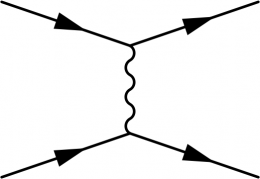
\begin { fmffile }{feyngraph} \begin { fmfgraph }(110,60) \fmfleft {i1,i2} \fmfright {o1,o2} \fmf {fermion}{i1,v1,o1} \fmf {fermion}{i2,v2,o2} \fmf {photon}{v1,v2} \stop { fmfgraph } \end { fmffile }
Apply the label option of \fmf to name a leg and the command \fmflabel (or \fmfv) to label vertices.
\begin { fmffile }{feyngraph} \begin { fmfgraph* }(110,60) \fmfleft {i1,i2} \fmfright {o1,o2} \fmflabel { $\mu^-$ }{i1} \fmflabel { $due east^-$ }{i2} \fmflabel { $\mu^-$ }{o1} \fmflabel { $e^-$ }{o2} \fmf {fermion}{i1,v1,o1} \fmf {fermion}{i2,v2,o2} \fmf {photon,label=$\gamma$ }{v1,v2} \stop { fmfgraph* } \end { fmffile }
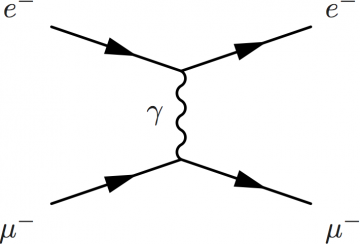
Checkout the feynMF manual for all the bachelor line styles, line options, vertex options and all their parameters.
Table 1: Bachelor line styles of \fmf. 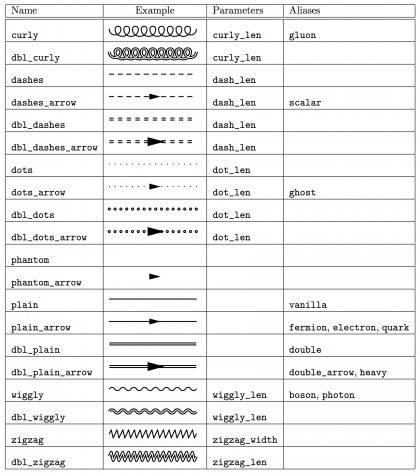
Table 2: Available line options of \fmf. 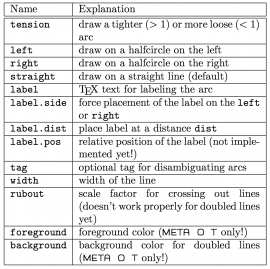
Tabular array 3: Available vertex options of \fmfv. 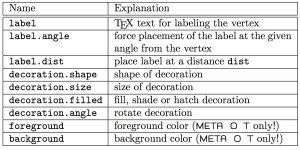
(Tables from the transmission.)
To put a dot on a vertex, you tin use these two equivalent options:
\fmfdot { v} \fmfv {decor.shape=circle,decor.filled=full,decor.size=4}{v} \fmfv{decor.shape=circle,decor.filled=full,decor.size=2thick}{v }
To make blobs for generic, effective field theory or beyond the standard model processes:
\fmfblob { 10}{v} \fmfv{decor.shape=circle,decor.filled=shaded,decor.size=10}{5 }
Emphasizing legs with color and width
To emphasize some legs, use the option foreground where you can set the color with a normalized decimal RBG value separated by two commas foreground=(<red>,,<blueish>,,<greenish>). You can hands detect websites similar this ane to go the RBG color code from some image, or with a color bike this 1, or you tin use the DigitalColor Meter application of Max OS X (in Applications/Utilities).
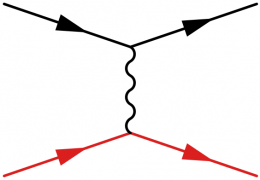
\begin { fmffile }{feyngraph} \begin { fmfgraph* }(110,60) \fmfleft {i1,i2} \fmfright {o1,o2} \fmf {fermion,foreground=(1,,0.1,,0.i)}{i1,v1,o1} \fmf {fermion}{i2,v2,o2} \fmf {photon}{v1,v2} \end { fmfgraph* } \end { fmffile }
Furthermore you can emphasize some leg with the width choice of \fmf, or employ \fmfpen{thick} to brand the whole diagram thick (default setting is thin).
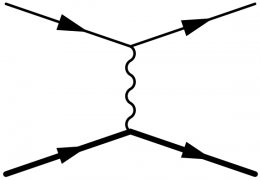
\begin { fmffile }{feyngraph} \brainstorm { fmfgraph* }(110,sixty) \fmfleft {i1,i2} \fmfright {o1,o2} \fmf {fermion,width=2}{i1,v1,o1} \fmf {fermion}{i2,v2,o2} \fmf {photon}{v1,v2} \stop { fmfgraph* } \end { fmffile }
Shaping diagrams with tension, freezing and phantom lines
Tension
You tin can command a leg's length and its pull on vertices and other legs by changing \fmf's tension option from the default value of i.
\begin { fmffile }{feyngraph} \begin { fmfgraph }(110,60) \fmfleft {i1,i2} \fmfright {o1,o2} \fmf {fermion}{i1,v1} \fmf{fermion,tension=two}{v1,o1 } % make shorter \fmf { fermion,tension=2}{i2,v2 } % brand shorter \fmf { fermion}{v2,o2} \fmf{photon,tension=0.4}{v1,v2 } % brand longer \end { fmfgraph } \end { fmffile }

Using \fmffreeze and drawing invisible lines with \fmf{phantom} can also help to command the shape. Past drawing a phantom line with some well-chosen tension, y'all can "pull" vertices in other directions. By freezing afterward drawing role of your diagram, you preclude these new lines from pulling information technology out of the desired shape.
Vertex positioning and distribution
Every bit documented in the feynMF transmission, the external vertices are by default (or explicitly with \fmfcurved) positioned on a curve:

Left to right: \fmfbottom, \fmfleft, \fmfsurround, \fmftop and \fmfright. If you prefer the external vertices aligned on a straight box, utilise \fmfstraight:

(Images from the manual.)
Phantoms, freezing and tension
How tin can yous accept more control over the line length and vertex positions? Consider making a diagram of a Higgs boson decaying into two Westward bosons (H → WW → 4f) without the use of tension:
\brainstorm { fmffile }{feyngraph} \begin { fmfgraph }(150,150) \fmfleft {i1} \fmfright {o1,o2,o3,o4} \fmf {dashes}{i1,v1} \fmf {boson}{v1,v21} \fmf {boson}{v1,v22} \fmf {fermion}{o1,v21,o2} \fmf {fermion}{o3,v22,o4} \finish { fmfgraph } \end { fmffile }
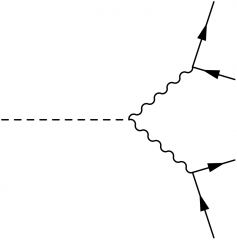
This was pretty straightforward, but possibly you prefer the fermion lines to exist equal in length. This can exist achieved by drawing help lines, which pull dorsum the vertices of the W boson decays. Commonly yous would use the invisible phantom lines, but let'southward showtime with the visible dashes:
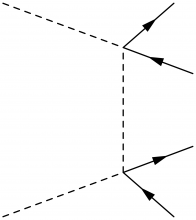
Find the endpoints of the outgoing fermion lines are not horizontally aligned. This is solved past including the control \fmfstraight:
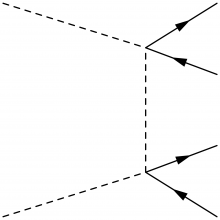
Utilise \fmffreeze to freeze this part of the diagram. This volition prevent the adjacent lines nosotros add from ruining this balance. Now put dorsum the rest (H → WW).
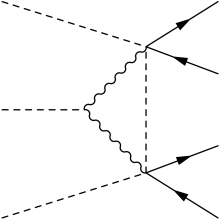
Now simple use phantom to make the assistance lines invisible. Note the use of tension, which needs to exist fine-tuned:
\begin { fmffile }{feyngraph} \brainstorm { fmfgraph }(150,150) \fmfstraight \fmfleft {i0,i1,i2} \fmfright{o1,o2,o3,o4 } % fermions \fmf { fermion}{o1,v21,o2} \fmf{fermion}{o3,v22,o4 } % phantoms to pull back fermion lines \fmf { phantom}{i0,v21} \fmf {phantom,tension=0.5}{v21,v22} \fmf{phantom}{i2,v22 } \fmffreeze % HWW \fmf { dashes,tension=i.five}{i1,v1} \fmf {boson}{v1,v21} \fmf {boson}{v1,v22} \stop { fmfgraph } \end { fmffile }
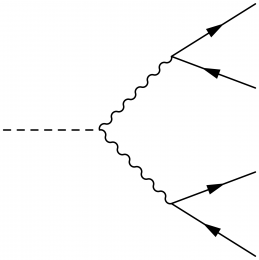
Adding momentum arrows
The easiest and most economic way to add together momentum arrows next to a leg is by using the following predefined control in the preamble (source):
\ newcommand { \marrow }[ five ]{ % \fmfcmd { style_def marrow#ane expr p = drawarrow subpath (1/4, iii/four) of p shifted 6 #2 withpen pencircle scaled 0.4; characterization.#three(btex #four etex, point 0.5 of p shifted 6 #2); enddef;} \fmf{marrow#1,tension=0}{#v} }
This predefined command \marrow makes use of \fmfcmd which draws an fermion line (patently line with arrow) in MetaPost. \marrow needs five parameters (#1–#v):
-
unique label of the arrow object (containing just letters);
-
postion of the momentum arrow w.r.t. the particle leg:
down,up; -
position of the label w.r.t. momentum arrow (optional):
bot,top; -
label text drawn with the arrow (optional);
-
comma-separated vertices betwixt which the momentum arrow is drawn.
\brainstorm { fmffile }{feyngraph} \begin { fmfgraph* }(110,60) \fmfleft {i1,i2} \fmfright {o1,o2} \fmflabel { $e^-$ }{i2} \fmflabel { $east^-$ }{o2} \fmflabel { $\mu^-$ }{i1} \fmflabel { $\mu^-$ }{o1} \fmf {fermion}{i2,v2,o2} \marrow {ea}{ up }{summit}{ $p_1$ }{i2,v2} \marrow {eb}{downwardly}{bot}{ $p_3$ }{v2,o2} \fmf {fermion}{i1,v1,o1} \marrow {ma}{down}{bot}{ $p_2$ }{i1,v1} \marrow {mb}{ up }{top}{ $p_4$ }{v1,o1} \fmf {photon,label=$\gamma$ }{v2,v1} \end { fmfgraph* } \end { fmffile }
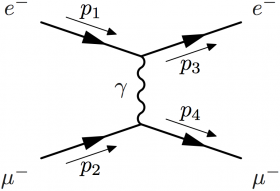
Aptitude lines and loop
Lines can exist bent by simply calculation right or left. Here is for instance the one-loop correction to the electron-photon vertex to compute the anomalous magnetic momentum:
\LARGE \begin { fmffile }{feyngraph} \begin { fmfgraph* }(70,100) \fmfleft {f2,f1} \fmfright{p } % outgoing photon \fmf { boson,l.s=left,t=0.viii}{p,v} \fmf {fermion}{f2,v1} \fmf {plainly,t=1.5}{v1,v,v2} \fmf {fermion}{v2,f1} \fmfv {l.a=165,50=due east$^-$}{f1 } % outcoming electron \fmfv { l.a=-165,l=due east$^-$}{f2 } % incoming electron \fmffreeze \fmf { boson,left}{v1,v2 } % bend photon line to the left \end { fmfgraph* } \end { fmffile }

More than examples can be found below in the sections on Higgs mass corrections and Penguin diagrams.
Intermediate way: How to use MetaPost
If you don't like puzzling with phantom lines and tension, you lot can gain greater control by using feynMP's "intermediate mode" to utilize MetaPost more directly. \fmfipairs and \fmfiequ gives the ability to exactly position vertices, and \fmfi allow to draw straight and curved lines between these points.
The adjacent level is executing MetaPost commands direct with \fmfcmd.
Yous can learn more about MetaPost in the transmission or this tutorial. The feynmf manual and this paper comprise some examples, and the author also put some advanced ones on this webpage. Examples on this wiki page that make apply of MetaPost intermediately of directly are:
Vertices: MetaPost pairs
Vertices in the intermediate mode are declared as MetaPost pairs with \fmfpair. Then you can set them in several different means: explicitly with some coordinates, along a path betwixt ii other pairs, sum of two pairs, … "feynMF vertices" declared with \fmfleft etc. can be accessed in MetaPost by prepending its proper noun with two underscores; so they can be converted to a MetaPost pair using the vloc role. These different methods are shown below. Note there are already some predefined points like origin and the cardinal directions ne (northeast), nw (northwest), se (southeast) and sw (southwest) for each corner.
\brainstorm { fmffile }{feyngraph} \begin { fmfgraph* }(120,120) % predefined points (MetaPost pairs) \fmfiv { d.sh=circle,d.f=1,d.si=5pt,50=ne}{ne} \fmfiv {d.sh=circle,d.f=1,d.si=5pt,l=nw}{nw} \fmfiv {d.sh=circle,d.f=1,d.si=5pt,l=se}{se} \fmfiv {d.sh=circle,d.f=1,d.si=5pt,fifty=sw,fifty.a=140}{sw} \fmfiv{d.sh=circle,d.f=1,d.si=5pt,l=origin,l.a=-140}{origin } % new feynMF vertices \fmftop { t} \fmfbottom{b } % new MetaPost pairs \fmfipair { o,i,1000,d,d',x,10',t'} \fmfiequ {o}{(0,0)} \fmfiequ {i}{(1w,1h)} \fmfiequ {thousand}{0.five[ nw,sw ]} \fmfiequ {d}{0.33[ ne,sw ]} \fmfiequ {d'}{0.33[ sw,ne ]} \fmfiequ {ypart(ten)}{ypart(one thousand)} \fmfiequ {xpart(x)}{xpart(.5[ ne,se ])} \fmfiequ {ten'}{k+(.2w,.2h)} \fmfiequ{t'}{vloc(__t) } % new points labels \fmfiv { d.sh=circumvolve,d.f=1,d.si=5pt,l=o,l.a=40}{o} \fmfiv {d.sh=circumvolve,d.f=i,d.si=5pt,fifty=i,l.a=-40}{i} \fmfiv {d.sh=circumvolve,d.f=i,d.si=5pt,fifty=thousand}{thou} \fmfiv {d.sh=circumvolve,d.f=1,d.si=5pt,l=d}{d} \fmfiv {d.sh=circle,d.f=one,d.si=5pt,50=d'}{d'} \fmfiv {d.sh=circle,d.f=one,d.si=5pt,l=x}{x} \fmfiv {d.sh=circumvolve,d.f=1,d.si=5pt,fifty=ten'}{x'} \fmfiv {d.sh=circumvolve,d.f=ane,d.si=5pt,l=t'}{t'} \fmfiv {d.sh=circle,d.f=1,d.si=5pt,fifty=b}{vloc(__b)} \end { fmfgraph* } \end { fmffile }
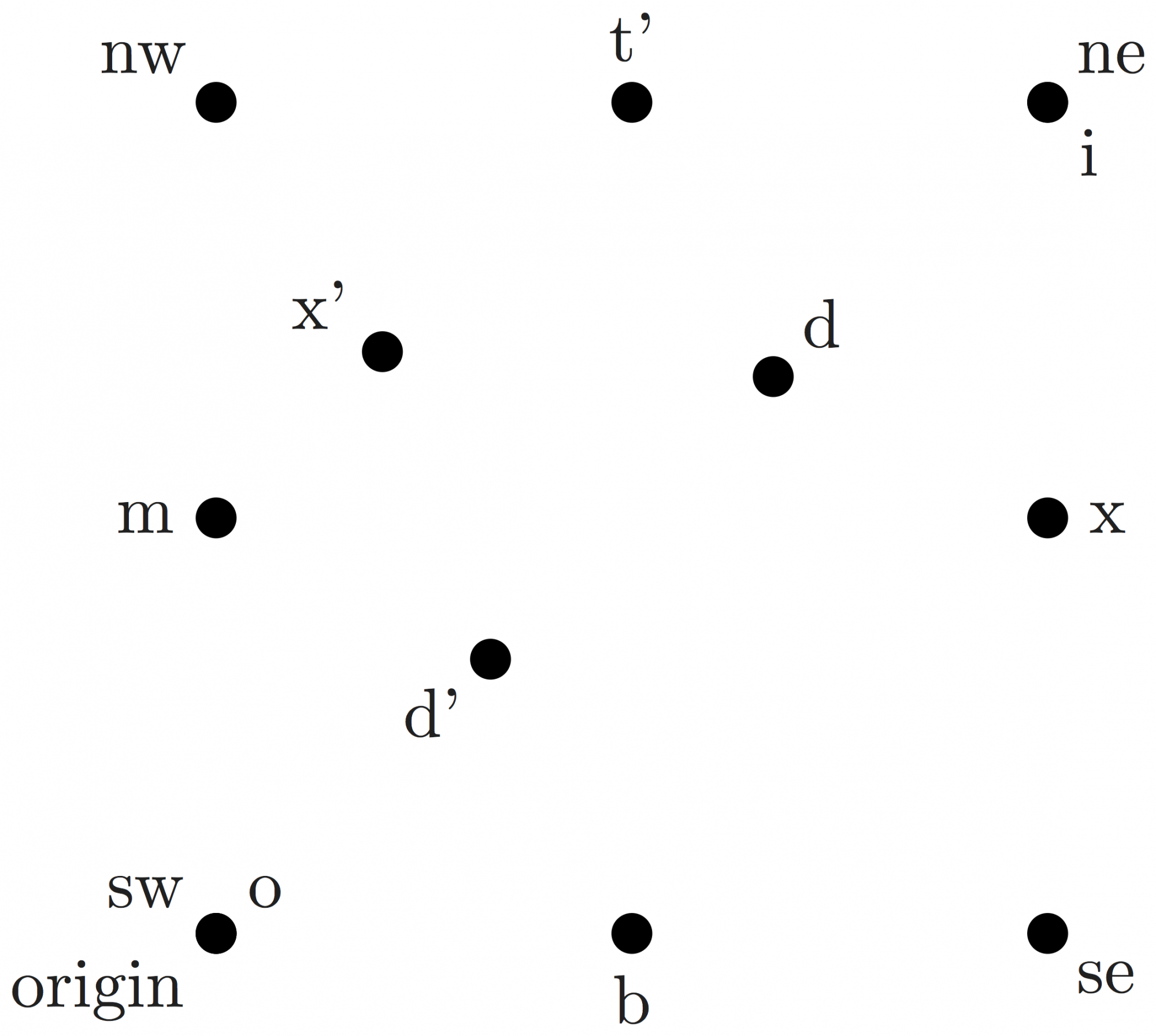
MetaPost paths
How do yous connect vertices? Here is a straightforward case with MetaPost pairs using \fmfi:
\begin { fmffile }{feyngraph} \brainstorm { fmfgraph* }(120,50) \fmfipair {i,o} \fmfiequ {i}{(0,0)} \fmfiequ {o}{(1w,0)} \fmfiv {d.sh=circumvolve,d.f=1,d.si=5pt,l=i,l.a=180}{i} \fmfiv {d.sh=circle,d.f=i,d.si=5pt,fifty=o,l.a=0}{o} \fmfi {fermion,l=path betwixt MetaPost pairs,50.s=left}{i--o} \finish { fmfgraph* } \end { fmffile }

You lot can at present hands shift or rotate these paths:

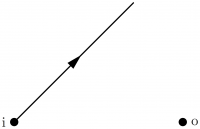
\fmfi { fermion}{(i--o) shifted(x,-20) }
\fmfi { fermion}{(i--o) rotatedaround(i,45) }
An equivalent way is by using a vpath between two feynMF vertices by prepending the vertex name with two underscores so MetaPost can acces them:
\begin { fmffile }{feyngraph} \begin { fmfgraph* }(120,l) \fmfleft {i} \fmfright {o} \fmfdot {i,o} \fmflabel {i}{i} \fmflabel {o}{o} \fmf {phantom}{i,o} \fmfi {fermion,l=vpath between feynMP vertices,fifty.s=left}{vpath (__i,__o)} \finish { fmfgraph* } \cease { fmffile }


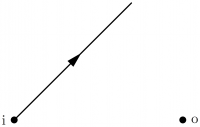
\fmfi { fermion}{vpath (__i,__o) shifted(10,-20) }
\fmfi { fermion}{vpath (__i,__o) rotatedaround(vloc(__i),45) }
Here is an example of curved paths with i{thou-i} .. {right}v drawing a path from i to v. The .. operator ensures a smooth connection. i{m-i} ways that the line m-i is the tangent of the path starting on i's right side. {right}five means the path'due south right terminate arrives in vertex v'due south left side.
\begin { fmffile }{feyngraph} \begin { fmfgraph* }(120,threescore) \fmfipair {i,o,five,m} \fmfiequ {i}{(0,0)} \fmfiequ {o}{(westward,0)} \fmfiequ {v}{(.5w,.5h)} \fmfiequ{m}{(.5w,h) } % gray tangent line (for analogy purposes) \fmfi { dashes,foreground=(0.7,,0.7,,0.7)}{m--i} \fmfi{dashes,foreground=(0.seven,,0.7,,0.seven)}{o--thousand } % curved paths \fmfi { fermion}{i{m-i} .. {right}v} \fmfi{fermion}{v{correct} .. {o-m}o } % point labels \fmfiv { d.sh=circumvolve,d.f=1,d.si=2pt,l=i}{i} \fmfiv {d.sh=circle,d.f=1,d.si=2pt,l=o}{o} \fmfiv {d.sh=circle,d.f=1,d.si=2pt,l=k}{1000} \fmfiv {d.sh=circumvolve,d.f=i,d.si=2pt,l=v,50.a=xc}{5} \finish { fmfgraph* } \end { fmffile }
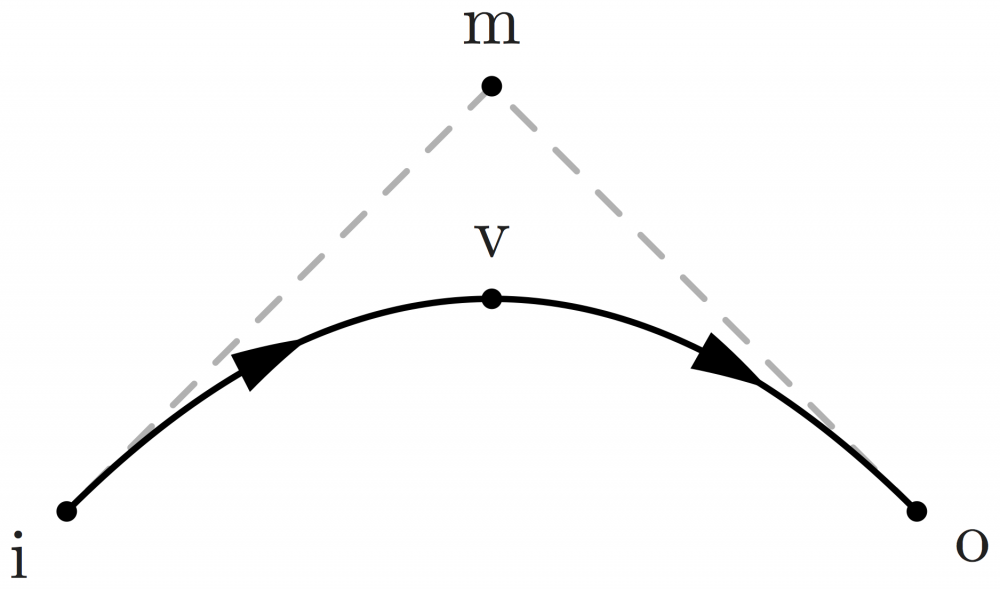
Y'all can command a path'due south curvature by adding tension betwixt two .. operators (less tension is more curvature):
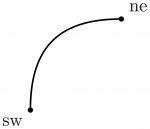
\fmfi { plainly}{sw{upwardly} .. tension .8 .. {correct}ne }
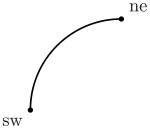
\fmfi { plain}{sw{upward} .. {right}ne} \fmfi{obviously}{sw{up} .. tension i .. {right}ne }
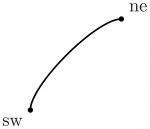
\fmfi { plain}{sw{up} .. tension two .. {correct}ne }
Here are some examples from the aforementioned webpage making one long path:
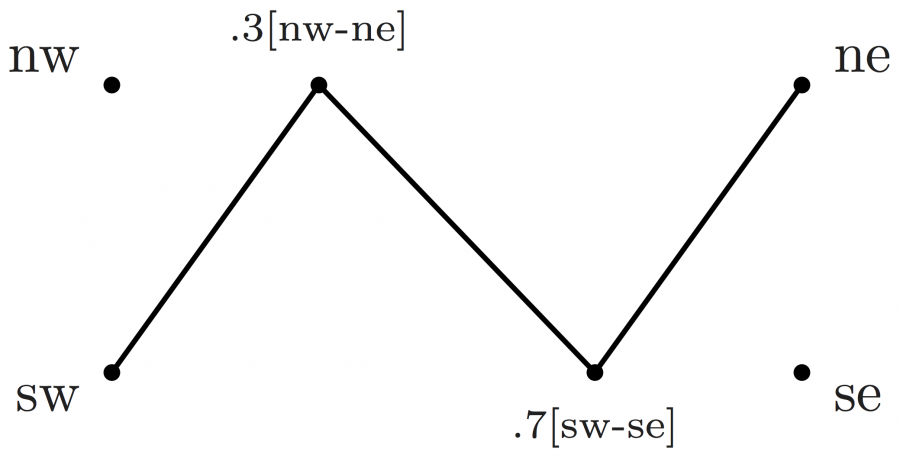
\fmfi { plain}{sw -- .3[nw,ne ] -- .7[ sw,se] -- ne }
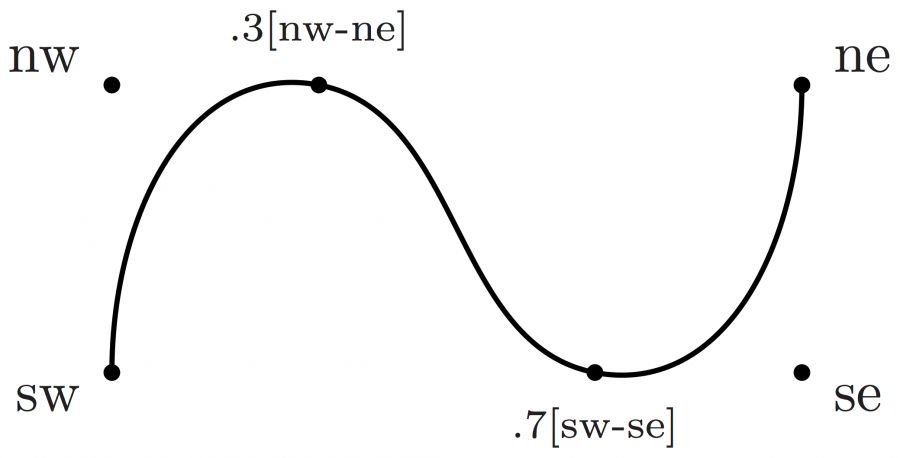
\fmfi { plain}{sw{upwards} .. .3[nw,ne ] .. .7[ sw,se] .. {upwards}ne }
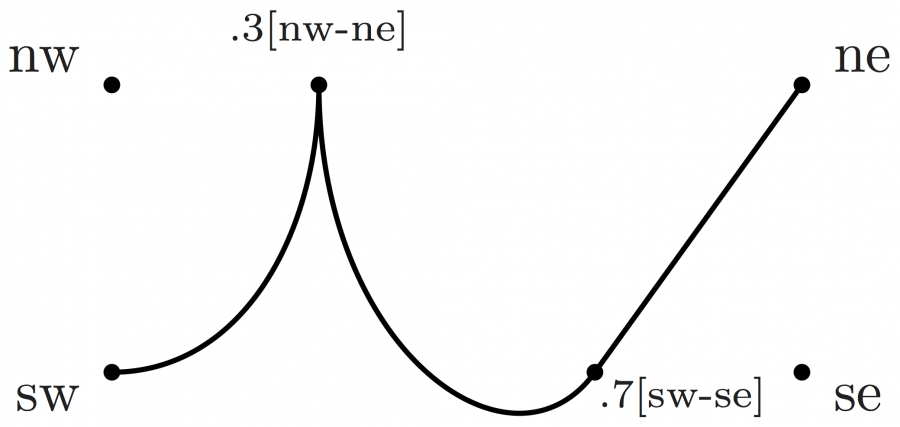
\fmfi { plain}{sw{right} .. {upwardly}.three[nw,ne ]{downwardly} .. .7[ sw,se] --- ne }
Examples
Top quark pair product
Some Feynman diagrams contributing to top quark pair product via gluon-gluon fusion:
\begin { fmffile }{feyngraph} \begin { fmfgraph* }(110,threescore) \fmfleft {i2,i1} \fmfright {o2,o1} \fmf {fermion}{o2,v2,o1} \fmf {gluon}{i2,v1,i1} \fmf {gluon,label=$g$ }{v1,v2} \fmflabel { $g$ }{i1} \fmflabel { $g$ }{i2} \fmflabel { $\overline { \text{t}}$ }{o2} \fmflabel {t}{o1} \end { fmfgraph* } \end { fmffile }

\begin { fmffile }{feyngraph} \begin { fmfgraph* }(110,60) \fmfleft {i2,i1} \fmfright {o2,o1} \fmf {gluon}{v1,i1} \fmf {fermion}{v1,o1} \fmf {gluon}{i2,v2} \fmf {fermion}{o2,v2} \fmf {fermion,label=t}{v2,v1} \fmflabel { $m$ }{i2} \fmflabel { $g$ }{i1} \fmflabel {t}{o1} \fmflabel { $\overline { \text{t}}$ }{o2} \end { fmfgraph* } \end { fmffile }

\begin { fmffile }{feyngraph} \brainstorm { fmfgraph* }(110,60) \fmfleft {i2,i1} \fmfright {o2,o1} \fmf {fermion}{i1,v1,i2} \fmf {fermion}{o2,v2,o1} \fmf {gluon,label=$chiliad$,label.side=right,characterization.dist=10}{v2,v1} \fmflabel { $q$ }{i1} \fmflabel { $\overline{q}$ }{i2} \fmflabel { $\overline { \text{t}}$ }{o2} \fmflabel {t}{o1} \stop { fmfgraph* } \end { fmffile }

With jets:
\large \begin { fmffile }{feyngraph} \brainstorm { fmfgraph* }(125,75) \fmfleft {i2,i1} \fmfright {o2,o1} \fmftop {t} \fmf {phantom}{i1,v1,i2} \fmf {phantom}{o1,v2,o2} \fmf {phantom}{v1,v2} \fmffreeze \fmfshift {5 left}{i1} \fmfshift {v upward}{i1,t} \fmf {gluon,tension=0.8}{g,i1} \fmf {fermion}{v1,thou} \fmf {gluon}{v1,i2} \fmf {fermion,tension=0}{g,t} \fmf {gluon}{v1,v2} \fmf {fermion}{o2,v2,o1} \fmflabel { $thousand$ }{i1} \fmflabel { $g$ }{i2} \fmflabel { $\overline { \text{t}}$ }{o2} \fmflabel {t}{o1} \end { fmfgraph* } \end { fmffile }

\large \brainstorm { fmffile }{feyngraph} \begin { fmfgraph* }(125,75) \fmfleft {i2,i1} \fmfright {o2,o1} \fmftop {t} \fmf {phantom}{i1,v1,i2} \fmf {phantom}{o1,v2,o2} \fmf{phantom}{v1,v2 } \fmffreeze %\fmfshift{5 left}{i1} %\fmfshift{5 up}{i1,t} \fmf { gluon,tension=0.viii}{g,i1} \fmf {fermion}{v1,g} \fmf {fermion}{i2,v1} \fmf {fermion,tension=0}{g,t} \fmf {gluon}{v1,v2} \fmf {fermion}{o2,v2,o1} \fmflabel { $g$ }{i1} \fmflabel { $q$ }{i2} \fmflabel { $\overline { \text{t}}$ }{o2} \fmflabel {t}{o1} \cease { fmfgraph* } \finish { fmffile }

\large \begin { fmffile }{feyngraph} \begin { fmfgraph* }(120,seventy) \fmfleft {i2,i1} \fmfright {o2,o1} \fmftop {t} \fmf {phantom}{i1,v1,i2} \fmf {phantom}{o1,v2,o2} \fmf {phantom}{v1,v2} \fmffreeze \fmf {fermion}{i1,g} \fmf {obviously,tension=two.viii}{g,v1} \fmf {fermion}{v1,i2} \fmf {gluon,tension=0}{t,thou} \fmf {gluon}{v1,v2} \fmf {fermion}{o2,v2,o1} \fmflabel { $q$ }{i1} \fmflabel { $\overline{q}$ }{i2} \fmflabel { $\overline { \text{t}}$ }{o2} \fmflabel {t}{o1} \stop { fmfgraph* } \end { fmffile }

Drell-Yan plus jet product
A simple one:
\big \brainstorm { fmffile }{feyngraph} \begin { fmfgraph* }(110,lx) %\fmfset{arrow_len}{10} \fmfleft { i2,i1} \fmfright {o2,o1} \fmf {fermion}{i1,v1,i2} \fmf {fermion}{o2,v2,o1} \fmf {boson,characterization=$\text {Z}/\gamma^*$,label.side=right}{v1,v2} \fmflabel { $q$ }{i1} \fmflabel { $q'$ }{i2} \fmflabel { $\bar { \ell}$ }{o2} \fmflabel { $\ell$ }{o1} \stop { fmfgraph* } \end { fmffile }
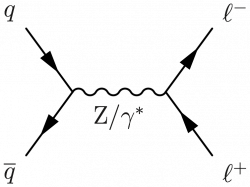
Some variants of Drell-Yan plus jets.
\big \begin { fmffile }{feyngraph} \begin { fmfgraph* }(125,75) \fmfleft {i2,i1} \fmfright {o2,o1} \fmftop {t} \fmf {phantom}{i1,v1,i2} \fmf {phantom}{o1,v2,o2} \fmf {phantom}{v1,v2} \fmffreeze \fmfshift {five left}{i1} \fmfshift {5 up}{i1,t} \fmf {gluon,tension=0.8}{thou,i1} \fmf {fermion}{v1,g} \fmf {fermion}{i2,v1} \fmf {fermion,tension=0}{chiliad,t} \fmf {boson,label=$\text {Z}/\gamma^*$,label.side=right}{v1,v2} \fmf {fermion}{o2,v2,o1} \fmflabel { $m$ }{i1} \fmflabel { $q$ }{i2} \fmflabel { $q'$ }{t} \fmflabel { $\bar { \ell}$ }{o2} \fmflabel { $\ell$ }{o1} \finish { fmfgraph* } \stop { fmffile }
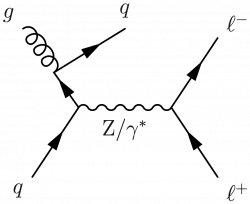
\large \begin { fmffile }{feyngraph} \begin { fmfgraph* }(120,70) \fmfleft {i2,i1} \fmfright {o2,o1} \fmftop {t} \fmf {phantom}{i1,v1,i2} \fmf {phantom}{o1,v2,o2} \fmf {phantom}{v1,v2} \fmffreeze \fmf {fermion}{i1,thou} \fmf {plain,tension=2.8}{thousand,v1} \fmf {fermion}{v1,i2} \fmf {gluon,tension=0}{t,1000} \fmf {boson,label=$\text {Z}/\gamma^*$,label.side=right}{v1,v2} \fmf {fermion}{o2,v2,o1} \fmflabel { $q$ }{i1} \fmflabel { $q'$ }{i2} \fmflabel { $\bar { \ell}$ }{o2} \fmflabel { $\ell$ }{o1} \end { fmfgraph* } \stop { fmffile }
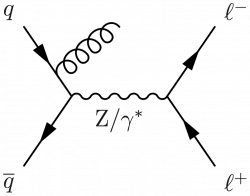
\begin { fmffile }{feyngraph} \brainstorm { fmfgraph* }(110,60) \fmfleft {i2,i1} \fmfright {o2,o1} \fmflabel { $q$ }{i1} \fmflabel { $\bar{q}$ }{i2} \fmf {fermion}{i1,v1,v2,i2} \fmflabel { $thousand$ }{o2} \fmflabel {Z}{o1} \fmf {photon}{v1,o1} \fmf {gluon}{v2,o2} \end { fmfgraph* } \end { fmffile }
Z boson with two b jets.
\begin { fmffile }{feyngraph} \begin { fmfgraph* }(150,90) \fmfpen {thick} \fmfleftn {i}{ii} \fmfrightn{o}{four } %particelle entranti \fmf { fermion}{i1,v1} \fmf {fermion}{v2,i2} \fmflabel { $\bar{q}$ }{i2} \fmflabel { $q$}{i1 } %mediatore \fmf { fermion}{v1,v2 } %%% produzione Z \fmf { photon,label=Z}{v2,v4 } % produzione l 50 \fmf { fermion}{v4,o4} \fmf {fermion}{o3,v4} \fmflabel { $\ell^+$ }{o3} \fmflabel { $\ell^-$}{o4 } %%% produzione glume \fmf { gluon,label=$one thousand$}{v1,v3 } %produzione b b \fmf { fermion}{v3,o2} \fmf {fermion}{o1,v3} \fmflabel { $\bar { \text{b}}$ }{o2} \fmflabel {b}{o1} \end { fmfgraph* } \end { fmffile }
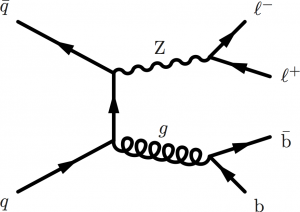
W plus jet product
Two simple ones:
\big \begin { fmffile }{feyngraph} \begin { fmfgraph* }(120,70) \fmfleft {i2,i1} \fmfright {o2,o1} \fmftop {t} \fmf {phantom}{i1,v1,i2} \fmf {phantom}{o1,v2,o2} \fmf {phantom}{v1,v2} \fmffreeze \fmf {fermion}{i1,g} \fmf {evidently,tension=two.8}{yard,v1} \fmf {fermion}{v1,i2} \fmf {gluon,tension=0}{t,g} \fmf {boson,characterization=$\text {West}^\pm$,label.side=right}{v1,v2} \fmf {fermion}{o2,v2,o1} \fmflabel { $q$ }{i1} \fmflabel { $\overline{q}$ }{i2} \fmflabel { $\ell^\pm$ }{o1} \fmflabel { $\overline { \nu }_\ell$ }{o2} \end { fmfgraph* } \end { fmffile }
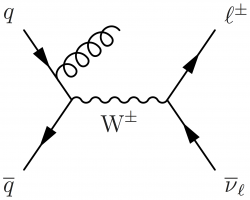
\large \brainstorm { fmffile }{feyngraph} \begin { fmfgraph* }(120,90) \fmfstraight \fmfleft {i2,i1} \fmfright{o1,l2,l1 } % skeleton \fmf { phantom,tension=1.viii}{i1,v1} \fmf {phantom,tension=1.0}{v1,l1} \fmf {phantom,tension=1.viii}{v1,v2} \fmf {phantom,tension=i.8}{i2,v2} \fmf{phantom,tension=1.0}{v2,o1 } \fmffreeze % Due west + jets \fmfshift { 5 right}{l1,l2} \fmfshift{20 left}{o1 } % quarks \fmflabel { $q$ }{i1} \fmflabel { $\overline{q}$ }{i2} \fmf{fermion}{i1,v1,v2,i2 } % West boson \fmf { boson,tension=1.2,label=$W^+$,label.side=left}{v1,z} \fmf{gluon}{v2,o1 } % leptons \fmflabel { $\ell^+$ }{l1} \fmflabel { $\overline { \nu }_\ell$ }{l2} \fmf {fermion}{l1,z,l2} \finish { fmfgraph* } \end { fmffile }
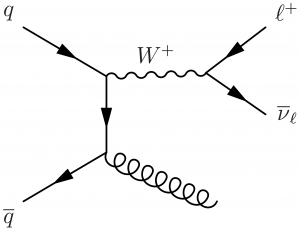
Higgs boson product
Here are some examples of Higgs production in proton-proton collisions. For more Higgs related diagrams and plots, check out this summary paper by ATLAS and CMS with a gallery of Feynman diagrams, or this LHC TWiki page with high resolution cross department and branching ratio plots.
Gluon fusion
Higgs boson production via gluon-gluon fusion with a fermion triangle loop:
\large \begin { fmffile }{feyngraph} \begin { fmfgraph* }(150,60) \fmfstraight \fmfleft {i1,i2} \fmfright{o1,h,o2 } % gluons \fmf { gluon}{i1,t1} \fmf {gluon}{t2,i2} \fmf {phantom,tension=0.5}{t1,o1} \fmf{phantom,tension=0.v}{t2,o2 } \fmffreeze % meridian loop \fmf { fermion,tension=1}{t1,t2,t3,t1 } % Higgs boson \fmf { dashes,tension=2.0}{t3,h } % labels \fmflabel { $thousand$ }{i1} \fmflabel { $g$ }{i2} \fmflabel {H}{h} \stop { fmfgraph* } \stop { fmffile }
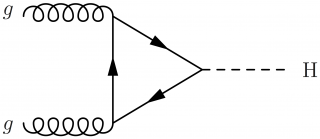
Including final-state gluon radiations:
\large \begin { fmffile }{feyngraph} \begin { fmfgraph* }(140,120) \fmfstraight \fmfleft {d,i1,d,i2,d} \fmfright{d,o1,h,o2,o3 } % gluons \fmf { gluon}{i1,t1} \fmf {gluon}{t2,i2} \fmf {phantom,tension=0.v}{t1,o1} \fmf{phantom,tension=0.5}{t2,o2 } \fmffreeze % acme loop \fmf { phantom,tension=0.8}{t1,t2,t3,t1} \fmf{fermion,tension=0,characterization=t,label.side=left}{t3,t1,t2 } %\fmf{fermion,tension=0.01,label=t,characterization.side=left}{t2,r1,t3} \fmf { fermion,tension=0.001,label=t,characterization.side=left}{t2,r1} \fmf{fermion,tension=0.001}{r1,t3 } % Higgs boson \fmf { dashes,tension=2}{t3,h } \fmffreeze % radiated gluon pulled by phantoms \fmf { gluon,tension=1.4}{r2,r1} \fmf{phantom,tension=i.5}{r2,o3 } % pull up \fmf { phantom,tension=1.0}{r2,o2 } % pull down % labels \fmflabel { $g$ }{i1} \fmflabel { $thou$ }{i2} \fmflabel { $g$ }{r2} \fmflabel {H}{h} \end { fmfgraph* } \end { fmffile }
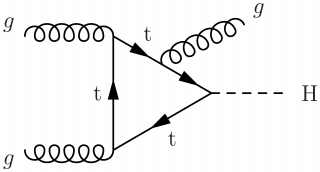
\large \brainstorm { fmffile }{feyngraph} \begin { fmfgraph* }(140,120) \fmfstraight \fmfleft {d,i1,d,i2,d} \fmfright{d,o1,h,o2,o3 } % gluons \fmf { gluon}{i1,t1} \fmf {gluon}{t2,i2} \fmf {phantom,tension=0.5}{t1,o1} \fmf{phantom,tension=0.five}{t2,o2 } \fmffreeze % Higgs boson \fmf { dashes,tension=2}{t3,h } % superlative loop \fmf { phantom,tension=0.8}{t1,t2,t3,t1} \fmffreeze \fmf {fermion,tension=one,label=t,characterization.side=left}{t3,t1,t2,tm} \fmf{plain,tension=five}{tm,t3 } \fmffreeze % radiated gluon pulled by phantoms \fmf { phantom,tension=1}{t2,r1 } % offset vertex \fmf { phantom,tension=2}{r1,t3 } % offset vertex \fmffreeze \fmf { gluon,tension=ane.4}{r2,r1} \fmf{phantom,tension=1.v}{r2,o3 } % pull up \fmf { phantom,tension=one.0}{r2,o2 } % pull downward % labels \fmflabel { $g$ }{i1} \fmflabel { $one thousand$ }{i2} \fmflabel { $g$ }{r2} \fmflabel {H}{h} \end { fmfgraph* } \end { fmffile }
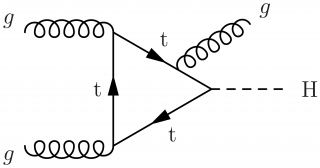
\large \begin { fmffile }{feyngraph} \begin { fmfgraph* }(170,60) \fmfstraight \fmfleft {i1,i2} \fmfright{o1,o2 } % gluons \fmf { gluon}{i1,t1} \fmf {gluon}{t2,i2} \fmf {phantom,tension=0.92}{t1,t4} \fmf{phantom,tension=0.92}{t2,t3 } % Higgs boson and gluon radiation \fmf { dashes,tension=1}{t4,o1} \fmf{gluon,tension=1}{o2,t3 } % acme loop \fmf { fermion,tension=0}{t1,t2,t3,t4,t1 } % labels \fmflabel { $g$ }{i1} \fmflabel { $g$ }{i2} \fmflabel {H}{o1} \fmflabel { $grand$ }{o2} \end { fmfgraph* } \finish { fmffile }
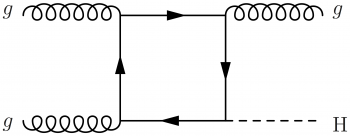
Vector boson fusion
Some variations of Higgs boson production in vector boson fusion, where V can be a Z or W boson:
\large \begin { fmffile }{feyngraph} \begin { fmfgraph* }(150,80) \fmfleft {i1,i3} \fmfright {o1,o2,o3} \fmf {fermion}{i1,v1,o1} \fmf {fermion}{i3,v3,o3} \fmf {phantom,tension=0.three}{v1,v3} \fmffreeze \fmf {boson,characterization=$V$,label.side=left}{v3,v2,v1} \fmf {dashes}{v2,o2} \fmflabel { $q$ }{i3} \fmflabel { $q'$ }{i1} \fmflabel {H}{o2} \end { fmfgraph* } \end { fmffile }
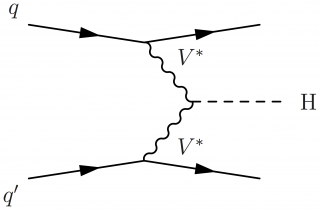
\large \begin { fmffile }{feyngraph} \begin { fmfgraph* }(150,xc) \fmfleft {d,i1,d,d,i3,d} \fmfright {o1,d,o2,d,o3} \fmf {fermion}{i1,v1,o1} \fmf {fermion}{i3,v3,o3} \fmf {phantom,tension=0.three}{v1,v3} \fmffreeze \fmf {boson,label=$V^*$,label.side=left,tension=0.7}{v3,v2,v1} \fmf {dashes}{v2,o2} \fmflabel { $q$ }{i3} \fmflabel { $q'$ }{i1} \fmflabel {H}{o2} \end { fmfgraph* } \end { fmffile }
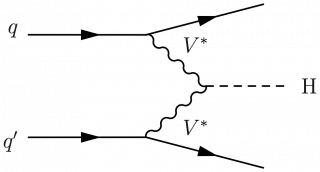
\large \begin { fmffile }{feyngraph} \begin { fmfgraph* }(120,60) %\fmfstraight \fmfleft { i1,i3} \fmfright {o1,o2,o3} \fmf {fermion}{i1,v1,o1} \fmf {fermion}{i3,v3,o3} \fmffreeze \fmf {boson,label=$V$,label.side=left}{v3,v2,v1} \fmffreeze \fmf {dashes}{v2,o2} \fmflabel { $q$ }{i3} \fmflabel { $q'$ }{i1} \fmflabel {H}{o2} \stop { fmfgraph* } \stop { fmffile }
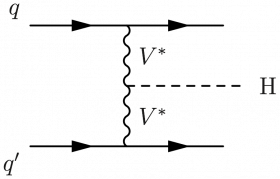
Higgs Strahlung
Some variation of Higgs boson production in Higgs Strahlung, including diagrams with gluon radiation and ZH product in gluon-gluon fusion:
\brainstorm { fmffile }{feyngraph} \begin { fmfgraph* }(120,sixty) \fmfleft {i1,i2} \fmfright {o1,o2} \fmf {fermion}{i1,v1} \fmf {fermion}{i2,v1} \fmf {boson,label=$V^*$,characterization.side=left}{v1,v2} \fmf {boson,label.side=left}{v2,o2} \fmf {dashes}{v2,o1} \fmflabel { $q'$ }{i1} \fmflabel { $q$ }{i2} \fmflabel { $5$ }{o2} \fmflabel {H}{o1} \end { fmfgraph* } \finish { fmffile }
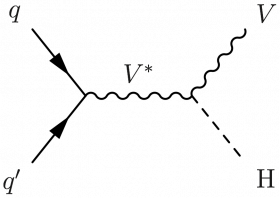
\Large \brainstorm { fmffile }{feyngraph} \brainstorm { fmfgraph* }(240,100) \fmfset {wiggly_len}{18} \fmfleft {i1,i2} \fmfright {o1,o2} \fmf {fermion}{i1,v1} \fmf {fermion}{i2,v1} \fmf {boson,label=$V^*$,characterization.side=left}{v1,v2} \fmf {boson,label.side=left}{v2,o2} \fmf {dashes}{v2,o1} \fmflabel { $q'$ }{i1} \fmflabel { $q$ }{i2} \fmflabel { $V$ }{o2} \fmflabel {H}{o1} \terminate { fmfgraph* } \end { fmffile }
\Large \begin { fmffile }{feyngraph} \begin { fmfgraph* }(240,100) \fmfset {wiggly_len}{18} \fmfleft {i1,i2} \fmfright {o1,o2} \fmftop {t1} \fmf {fermion}{i1,v1} \fmf {fermion,tension=two}{i2,s2,v1} \fmf {boson,label=$5^*$,label.side=left}{v1,v2} \fmf {boson,label.side=left}{v2,o2} \fmf {dashes}{v2,o1} \fmffreeze \fmf {gluon}{t1,s2} \fmflabel { $q'$ }{i1} \fmflabel { $q$}{i2 } %\fmflabel{$g$}{t1} \fmflabel { $V$ }{o2} \fmflabel {H}{o1} \end { fmfgraph* } \end { fmffile }
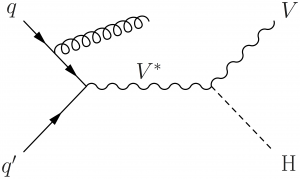
\large \brainstorm { fmffile }{feyngraph} \begin { fmfgraph* }(170,sixty) \fmfstraight \fmfleft {i1,i2} \fmfright{o1,m,o2 } % gluons \fmf { gluon}{i1,t1} \fmf {gluon}{t2,i2} \fmf {phantom,tension=0.iv}{t1,o1} \fmf{phantom,tension=0.4}{t2,o2 } \fmffreeze % superlative loop \fmf { fermion,tension=ane}{t1,t2,t3,t1} \fmf{phantom,tension=one.four}{t3,one thousand } \fmffreeze % Higgs boson \fmf { boson,tension=1.4,characterization=Z$^*$ }{t3,h} \fmf {dashes,tension=1}{h,o1} \fmf{boson,tension=ane}{h,o2 } % labels \fmflabel { $g$ }{i1} \fmflabel { $g$ }{i2} \fmflabel {H}{o1} \fmflabel {Z}{o2} \finish { fmfgraph* } \end { fmffile }
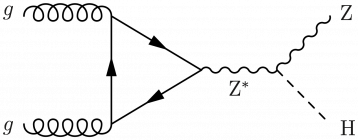
\big \brainstorm { fmffile }{feyngraph} \begin { fmfgraph* }(170,60) \fmfstraight \fmfleft {i1,i2} \fmfright{o1,o2 } % gluons \fmf { gluon}{i1,t1} \fmf {gluon}{t2,i2} \fmf {phantom,tension=0.92}{t1,t4} \fmf{phantom,tension=0.92}{t2,t3 } % Higgs boson \fmf { dashes,tension=1}{t4,o1} \fmf{boson,tension=one}{t3,o2 } % pinnacle loop \fmf { fermion,tension=0}{t1,t2,t3,t4,t1 } % labels \fmflabel { $g$ }{i1} \fmflabel { $g$ }{i2} \fmflabel {H}{o1} \fmflabel {Z}{o2} \end { fmfgraph* } \cease { fmffile }
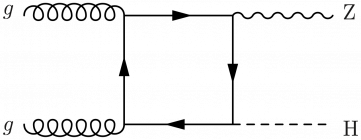
Associated production
Associated production of Higgs boson production with a peak quark pair:
\large \begin { fmffile }{feyngraph} \begin { fmfgraph* }(140,90) \fmfleft {d,i1,d,d,i3,d} \fmfright {o1,d,o2,d,o3} \fmf {gluon,tension=1.2}{i1,v1} \fmf {gluon,tension=one.2}{v3,i3} \fmf {fermion}{o1,v1} \fmf {fermion}{v3,o3} \fmf {phantom,tension=0.3}{v1,v3} \fmffreeze \fmf {fermion}{v1,v2,v3} \fmf {dashes,tension=i.3}{v2,o2} \fmflabel { $g$ }{i3} \fmflabel { $g$ }{i1} \fmflabel { $t$ }{o3} \fmflabel { $\bar{t}$ }{o1} \fmflabel {H}{o2} \end { fmfgraph* } \end { fmffile }
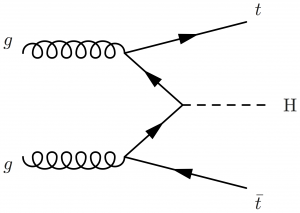
Higgs boson pair production via gluon-gluon fusion
Triangle diagram of gluon-gluon fusion to produce a pair of Higgs bosons.
\brainstorm { fmffile }{feyngraph} \begin { fmfgraph* }(170,sixty) \fmfstraight \fmfleft {i1,i2} \fmfright{o1,m,o2 } % gluons \fmf { gluon}{i1,t1} \fmf {gluon}{t2,i2} \fmf {phantom,tension=0.4}{t1,o1} \fmf{phantom,tension=0.iv}{t2,o2 } \fmffreeze % top loop \fmf { fermion,tension=one}{t1,t2,t3,t1} \fmf{phantom,tension=i.4}{t3,grand } \fmffreeze % Higgs boson \fmf { dashes,tension=one.4}{t3,h} \fmf {dashes,tension=1}{h,o1} \fmf {dashes,tension=1}{h,o2} \end { fmfgraph* } \end { fmffile }

A box diagram of gluon-gluon fusion producing a pair of Higgs bosons.
\begin { fmffile }{feyngraph} \begin { fmfgraph* }(170,lx) \fmfstraight \fmfleft {i1,i2} \fmfright{o1,o2 } % gluons \fmf { gluon}{i1,t1} \fmf {gluon}{t2,i2} \fmf {phantom,tension=i}{t1,t4} \fmf{phantom,tension=i}{t2,t3 } % Higgs boson \fmf { dashes,tension=1}{t4,o1} \fmf{dashes,tension=1}{t3,o2 } % top loop \fmf { fermion,tension=0}{t1,t2,t3,t4,t1} \cease { fmfgraph* } \end { fmffile }

Beyond the Standard model
For constructive field, unknown or generalized processes beyond the Standard Model (BSM), 1 tin introduce blobs of some size at some vertex with \fmfblob.
\begin { fmffile }{feyngraph} \begin { fmfgraph* }(80,fourscore) \fmfstraight \fmfleft {i1,i2} \fmfright{o1,o2 } % gluons \fmf { gluon}{i1,v} \fmf {gluon}{v,i2} \fmfblob{20}{v } % Higgs boson \fmf { dashes,tension=one}{v,o1} \fmf {dashes,tension=1}{v,o2} \end { fmfgraph* } \stop { fmffile }
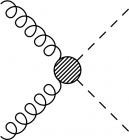
\brainstorm { fmffile }{feyngraph} \brainstorm { fmfgraph* }(130,80) \fmfstraight \fmfleft {i1,i2} \fmfright{o1,o2 } % gluons \fmf { gluon}{i1,five} \fmf {gluon}{five,i2} \fmfblob{xx}{v } % Higgs boson \fmf { dashes,tension=ane}{v,h} \fmf {dashes,tension=1}{h,o1} \fmf {dashes,tension=ane}{h,o2} \end { fmfgraph* } \end { fmffile }
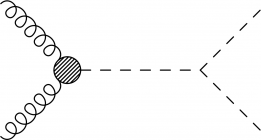
\begin { fmffile }{feyngraph} \brainstorm { fmfgraph* }(120,60) \fmfstraight \fmfleft {i1,i2} \fmfright{o1,o2 } % gluons \fmf { gluon}{i1,t1} \fmf {gluon}{t2,i2} \fmf {phantom,tension=0.6}{t1,o1} \fmf{phantom,tension=0.vi}{t2,o2 } \fmffreeze % top loop \fmf { fermion,tension=0.lxx}{t1,t2,t3,t1 } % Higgs boson \fmf { dashes,tension=i}{t3,o1} \fmf {dashes,tension=one}{t3,o2} \fmfblob {20}{t3} \terminate { fmfgraph* } \finish { fmffile }
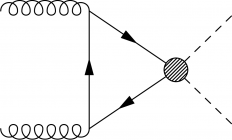
Pseudoscalar Higgs boson
Here are some examples of processes with a pseudoscalar Higgs boson a from a two Higgs doublet model (2HDM).
\large \brainstorm { fmffile }{feyngraph} \begin { fmfgraph* }(130,130) \fmfleft {d,d,g2,d,g1,d,d} \fmfright {b2,d,t2,d,t1,d,b1} \fmf {gluon,tension=2}{v1,g1} \fmf {gluon,tension=ii}{g2,v2} \fmf {phantom}{v1,t1} \fmf {phantom}{v2,t2} \fmffreeze \fmf {fermion}{b2,v2,v3,v1,b1} \fmf {dashes,tension=1.v,label=$a$,l.s=left}{v3,a} \fmf {fermion}{t2,a,t1} \fmflabel { $g$ }{g1} \fmflabel { $g$ }{g2} \fmflabel { $\tau^-$ }{t1} \fmflabel { $\tau^+$ }{t2} \fmflabel {b}{b1} \fmflabel { $\overline { \text{b}}$ }{b2} \cease { fmfgraph* } \end { fmffile }
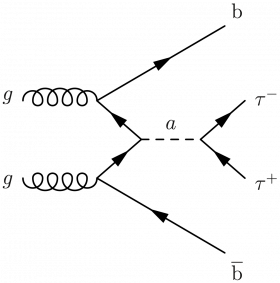
\large \brainstorm { fmffile }{feyngraph} \begin { fmfgraph* }(180,140) \fmfstraight \fmfleft {i2,g2,g1,i1} \fmfright {o4,o3,o2,o1} \fmftop {top} \fmfbottom{bot } % gluon \fmf { gluon,tension=ii.six}{t1,g1} \fmf {gluon,tension=2.six}{g2,t2} \fmf {phantom,tension=0.4}{o1,t1,o3} \fmf{phantom,tension=0.4}{o2,t2,o4 } \fmffreeze % superlative loop \fmf { fermion,tension=i.0}{t1,t3,t2,t1} \fmf{phantom,tension=0.4}{o3,t3,o2 } \fmffreeze % Higgs bosons \fmf { dashes,tension=ane.4,characterization=H,l.s=left}{t3,h} \fmf {dashes,tension=1.2,characterization=$a$,fifty.south=right}{v1,h,v2 } % decay products \fmf { phantom,tension=0.8}{top,v1} \fmf {phantom,tension=0.8}{v2,bot} \fmfshift {16 downwardly}{o1} \fmfshift { 8 down}{o2} \fmfshift { eight up}{o3} \fmfshift {16 upwards}{o4} \fmf {fermion,tension=1.eight}{o2,v1,o1} \fmf{fermion,tension=one.8}{o4,v2,o3 } % labels \fmflabel { $grand$ }{g1} \fmflabel { $g$ }{g2} \fmflabel { $\text{b}$ }{o1} \fmflabel { $\overline { \text{b}}$ }{o2} \fmflabel { $\tau^-$ }{o3} \fmflabel { $\tau^+$ }{o4} \terminate { fmfgraph* } \stop { fmffile }
\large \brainstorm { fmffile }{feyngraph} \begin { fmfgraph* }(170,140) %\fmfstraight \fmfleft { d,i2,d,d,i1,d} \fmfright {q2,t2,t1,b2,b1,q1} \fmftop {summit} \fmfbottom{bot } % quarks \fmf { fermion,tension=1.9}{i1,v1} \fmf {fermion,tension=1.nine}{v2,i2} \fmf {fermion}{v1,q1} \fmf{fermion}{q2,v2 } % vector bosons \fmf { boson,characterization=$5$,characterization.side=left}{v1,h,v2 } % Higgs bosons \fmf { dashes,tension=i.one,label=H,label.side=left}{h,a} \fmf {dashes,label=$a$,label.side=right}{b,a,t} \fmf {fermion}{t2,t,t1} \fmf {fermion}{b2,b,b1} \fmf{phantom,tension=0.4}{top,b,t,bot } %\fmfshift{10 right}{b1,b2,t1,t2} % characterization \fmflabel { $\text{b}$ }{b1} \fmflabel { $\overline { \text{b}}$ }{b2} \fmflabel { $\tau^-$ }{t1} \fmflabel { $\tau^+$ }{t2} \fmflabel { $\text{q}$ }{q1} \fmflabel { $\overline { \text{q}}'$ }{q2} \end { fmfgraph* } \end { fmffile }

Leptoquark
Here are some examples of processes with leptoquarks.
\Big \begin { fmffile }{feyngraph} \begin { fmfgraph* }(100,80) \fmfleft {LQ} \fmfright {q,fifty} \fmf {dashes,50.s=left,t=1.ii}{LQ,v} \fmf {fermion}{5,q} \fmf {fermion}{5,l} \fmfv {l=$\text{LQ}_3$ }{LQ} \fmfv {fifty.a=-28,l=$\text{b}$ }{q} \fmfv {l.a=28,l=$\tau$ }{50} \fmfdot {5} \fmfv {l.a=115,fifty=\large $\lambda_{ \tau \text{b}}$ }{five} \end { fmfgraph* } \end { fmffile }

Pair production
\large \begin { fmffile }{feyngraph} \begin { fmfgraph* }(120,120) \fmfstraight \fmfleft {i2,g2,d,g1,i1} \fmfright {o4,o3,o2,o1} \fmftop {elevation} \fmfbottom{bot } % gluonS \fmf { gluon,tension=one.4}{5,g1} \fmf {gluon,tension=ane.iv}{g2,v} \fmf {gluon,tension=1.six}{5,h} \fmf {dashes,tension=one.2,characterization=LQ,l.south=right}{v1,h} \fmf {dashes,tension=1.2,characterization=$\overline { \text{LQ}}$,50.southward=right}{h,v2 } % disuse products \fmf { phantom,tension=0.8}{top,v1} \fmf {phantom,tension=0.8}{v2,bot} \fmfshift {xvi down}{o1} \fmfshift { 8 downwards}{o2} \fmfshift { eight upwardly}{o3} \fmfshift {16 up}{o4} \fmf {fermion,tension=1.eight}{o2,v1,o1} \fmf{fermion,tension=1.eight}{o3,v2,o4 } % labels \fmflabel { $chiliad$ }{g1} \fmflabel { $g$ }{g2} \fmflabel { $\ell$ }{o1} \fmflabel { $\overline{q}$ }{o2} \fmflabel { $\overline { \ell}$ }{o3} \fmflabel { $q$ }{o4} \end { fmfgraph* } \end { fmffile }

\large \begin { fmffile }{feyngraph} \begin { fmfgraph* }(100,120) \fmfstraight \fmfleft {i2,g,i1} \fmfright {o4,o3,o2,o1} \fmftop {top} \fmfbottom{bot } % gluonS \fmf { gluon,tension=1.six}{k,h} \fmf {dashes,tension=1.3,label=LQ,l.s=correct}{v1,h} \fmf {dashes,tension=i.3,label=$\overline { \text{LQ}}$,l.due south=correct}{h,v2 } % decay products \fmf { phantom,tension=1.0}{top,v1} \fmf {phantom,tension=1.0}{v2,bot} \fmfshift {16 down}{o1} \fmfshift { eight down}{o2} \fmfshift { viii upwardly}{o3} \fmfshift {16 up}{o4} \fmf {fermion,tension=1.8}{o2,v1,o1} \fmf{fermion,tension=one.8}{o3,v2,o4 } % labels \fmflabel { $1000$ }{g} \fmflabel { $\tau^-$ }{o1} \fmflabel { $\overline { \text{b}}$ }{o2} \fmflabel { $\tau^+$ }{o3} \fmflabel {b}{o4} \end { fmfgraph* } \stop { fmffile }

Single production
\large \begin { fmffile }{feyngraph} \begin { fmfgraph* }(140,100) \fmfleft {i2,i1} \fmfright{o2,l2,l1 } % gluon + quarks \fmf { gluon}{i1,v1} \fmf {fermion}{i2,v2,o2} \fmflabel { $g$ }{i1} \fmflabel { $q$ }{i2} \fmflabel { $\ell$}{o2 } % LQs \fmf { dashes_arrow,characterization=LQ,label.side=left}{v2,v1,LQ } % LQ -> lepton + quark \fmf { fermion}{l2,LQ,l1} \fmflabel { $q$ }{l1} \fmflabel { $\overline { \ell}$ }{l2} \terminate { fmfgraph* } \end { fmffile }

\large \begin { fmffile }{feyngraph} \begin { fmfgraph* }(120,100) \fmfstraight \fmfleft {i2,i1} \fmfright{o2,l2,l1 } % skeleton \fmf { phantom,tension=1.8}{i1,v1} \fmf {phantom,tension=1.0}{v1,l1} \fmf {phantom,tension=1.8}{v1,v2} \fmf {phantom,tension=1.8}{i2,v2} \fmf{phantom,tension=1.0}{v2,o2 } \fmffreeze % gluon + quarks \fmf { gluon}{i1,v1} \fmf {fermion}{i2,v2,o2} \fmflabel { $g$ }{i1} \fmflabel { $q$ }{i2} \fmflabel { $\ell$}{o2 } % LQs \fmf { dashes_arrow,tension=1.ii,label=LQ,label.side=left}{v1,LQ} \fmf{dashes_arrow,label=LQ,label.side=left}{v2,v1 } % LQ -> lepton + quark \fmf { fermion}{l2,LQ,l1} \fmfshift {5 correct}{l1,l2} \fmfshift {20 left}{o2} \fmflabel { $q$ }{l1} \fmflabel { $\overline { \ell}$ }{l2} \end { fmfgraph* } \end { fmffile }

\large \brainstorm { fmffile }{feyngraph} \begin { fmfgraph* }(140,100) \fmfleft {i2,i1} \fmfright{o2,l2,l1 } % gluon + quarks \fmf { gluon}{i1,v1} \fmf {fermion}{i2,v1} \fmf {fermion,characterization=$q$,characterization.side=left}{v1,v2} \fmf {fermion}{v2,o2} \fmflabel { $g$ }{i1} \fmflabel { $q$ }{i2} \fmflabel { $\ell$}{o2 } % LQ \fmf { dashes_arrow,label=LQ,label.side=left}{v2,LQ } % LQ -> lepton + quark \fmf { fermion}{l2,LQ,l1} \fmfshift {xx correct}{l1,l2} \fmflabel { $q$ }{l1} \fmflabel { $\overline { \ell}$ }{l2} \end { fmfgraph* } \end { fmffile }

\large \begin { fmffile }{feyngraph} \begin { fmfgraph* }(120,100) \fmfstraight \fmfleft {i2,m,i1} \fmfright{o2,l2,l1 } % skeleton \fmf { phantom,tension=1.0}{i1,v1} \fmf {phantom,tension=1.0}{v2,l1} \fmf {phantom,tension=1.v}{v1,v2} \fmf {phantom,tension=1.0}{i2,v1} \fmf {phantom,tension=1.0}{v2,o2} \fmf {phantom,tension=0.6}{i1,t1,m} \fmf {phantom,tension=0.6}{t1,LQ} \fmf{phantom,tension=2.0}{l1,LQ,l2 } \fmffreeze % gluon + quarks \fmf { phantom,tension=5.0}{i1,g } % shorten leg \fmf { phantom,tension=5.0}{i2,q } % shorten leg \fmf { phantom,tension=v.0}{o2,fifty } % shorten leg \fmf { gluon}{g,v1} \fmf {fermion}{q,v1} \fmf {fermion,label=$q$,characterization.side=right}{v1,v2} \fmf {fermion}{v2,l} \fmflabel { $g$ }{g} \fmflabel { $q$ }{q} \fmflabel { $\ell$}{l } % LQ \fmf { dashes_arrow,tension=1.two,label=LQ,label.side=left}{v2,LQ } % LQ -> lepton + quark \fmf { fermion}{l2,LQ,l1} \fmfshift {20 right}{l1,l2} \fmflabel { $q$ }{l1} \fmflabel { $\overline { \ell}$ }{l2} \end { fmfgraph* } \end { fmffile }

Z' and W'
Here are some examples of processes with Z' and W'.
\begin { fmffile }{feyngraph} \brainstorm { fmfgraph* }(120,60) \fmfset {arrow_len}{x} \fmfstraight \fmfleft {i3,i1} \fmfright{o3,o2,o1 } % fermions \fmf { fermion}{i1,v1,o1} \fmffreeze \fmf {fermion,tension=1.5}{o3,v3,o2} \fmf {phantom,tension=1.8}{i3,v3} \fmflabel {b}{i1} \fmflabel {c}{o1} \fmflabel { $\tau$ }{o2} \fmflabel { $\nu_\tau$}{o3 } % boson \fmf { boson,label=W$'$,label.side=left}{v3,v1} \end { fmfgraph* } \end { fmffile }
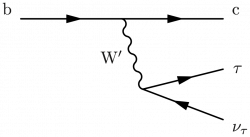
\begin { fmffile }{feyngraph} \begin { fmfgraph* }(120,sixty) \fmfset {arrow_len}{10} \fmfstraight \fmfleft {i3,i1} \fmfright{o3,o2,o1 } % fermions \fmf { fermion}{i1,v1,o1} \fmffreeze \fmf {fermion,tension=1.5}{o3,v3,o2} \fmf {phantom,tension=one.8}{i3,v3} \fmflabel {b}{i1} \fmflabel {south}{o1} \fmflabel { $\mu$ }{o2} \fmflabel { $\mu$}{o3 } % boson \fmf { boson,label=Z$'$,characterization.side=left}{v3,v1} \fmfblob {16}{v1} \finish { fmfgraph* } \end { fmffile }
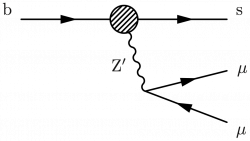
\large \begin { fmffile }{feyngraph} \begin { fmfgraph* }(110,100) \fmfleft {i2,i1} \fmfright {o2,m2,m1,o1} \fmfshift {xxx right}{m1,m2} \fmf {fermion}{i1,v1,i2} \fmf {phantom}{o2,v2,o1} \fmf {boson,characterization=$\text {Z}/\gamma^*$,label.side=right}{v1,v2} \fmffreeze \fmf {fermion}{o2,v2,z,o1} \fmffreeze \fmf {boson,label=$\text{Z}'$,label.side=left}{z,chiliad} \fmf {fermion,tension=i.4}{m2,m,m1} \fmf {phantom,tension=0.vi}{i2,k} \fmflabel { $\mu^-$ }{m1} \fmflabel { $\mu^+$ }{m2} \fmflabel { $\mu^-$ }{o1} \fmflabel { $\mu^+$ }{o2} \fmflabel { $q$ }{i1} \fmflabel { $\overline{q}'$ }{i2} \terminate { fmfgraph* } \terminate { fmffile }
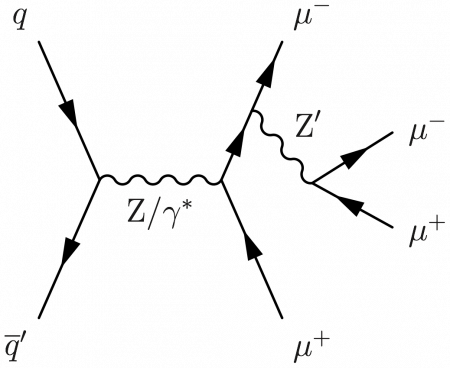
SUSY
More than SUSY diagram are available here (images and hither (GitHub).
\large \begin { fmffile }{feyngraph} \brainstorm { fmfgraph* }(80,120) %\fmfstraight \fmfleft { i2,b,i1} \fmfright {o4,o3,o2,o1} \fmftop {top} \fmfbottom{bot } % blob \fmfblob { 16}{b} \fmf {dashes,tension=1.three,label=$\tilde { \text{t}}$,fifty.s=right}{v1,b} \fmf {dashes,tension=one.three,label=$\overline { \tilde { \text{t}}}$,l.south=right}{b,v2 } % decay products %\fmf{phantom,tension=1.0}{top,v1} %\fmf{phantom,tension=1.0}{v2,bot} \fmfshift { 16 down}{o1} \fmfshift { viii downwardly}{o2} \fmfshift { 8 up}{o3} \fmfshift {xvi upward}{o4} \fmf {dots,tension=i.8}{v1,o1} \fmf {fermion,tension=1.8}{o2,v1} \fmf {fermion,tension=one.eight}{v2,o4} \fmf{dots,tension=i.8}{o3,v2 } % labels \fmflabel { $\tilde { \chi}_1^0$ }{o1} \fmflabel { $\overline { \text{t}}$ }{o2} \fmflabel { $\tilde { \chi}_1^0$ }{o3} \fmflabel {t}{o4} \cease { fmfgraph* } \cease { fmffile }
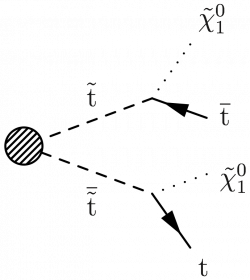
Top quark pair disuse into a W boson pair and a b quark pair
A acme quark pair decaying in to bbWW with the Due west boson pair in the semi-leptonic final state.
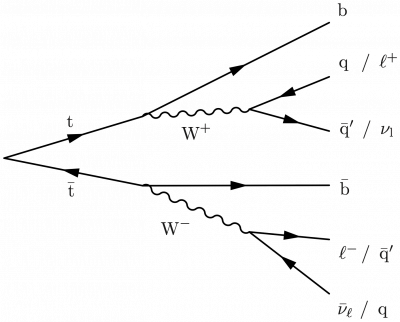
\begin { fmffile }{feyngraph} \begin { fmfgraph* }(180,150) \fmfset {arrow_len}{three.5mm} \fmfstraight \fmfleft {i1,i2,i3,i4,i5} \fmfright{o1,o2,o3,o4,o5,o6 } % bW -> bqq \fmf { boson,tension=1.v,label={$\text{W}^+$},label.side=right}{v2,v21 } % W boson \fmf { fermion}{v2,o6 } % b quark \fmf { fermion}{o5,v21,o4 } % bW -> blnu \fmf { boson,tension=one.5,characterization={$\text{Due west}^-$},label.side=right}{v1,v11 } % West boson \fmf { fermion}{v1,o3 } % b quark \fmf { fermion}{o1,v11,o2} \fmf{fermion,tension=i.5}{v1,i3,v2 } % top quark pair \fmf { phantom,label={$\bar { \text{t}}$ },tension=ane}{i3,v1} \fmf {phantom,label={ $\text{t}$ },tension=1}{i3,v2} \fmflabel {\ makebox [ 3.2mm ][ l ]{ $\bar { \nu }_\ell$ } /\, q}{o1} \fmflabel {\ makebox [ 3.2mm ][ l ]{ $\ell^-$ } /\, $\bar { \text{q}}'$ }{o2} \fmflabel { $\bar { \text{b}}$ }{o3} \fmflabel {\ makebox [ 3.2mm ][ 50 ]{ $\bar { \text{q}}'$ } /\, $\nu_\text{l}$ }{o4} \fmflabel {\ makebox [ iii.2mm ][ l ]{q} /\, $\ell^+$ }{o5} \fmflabel { $\text{b}$ }{o6} \cease { fmfgraph* } \end { fmffile }
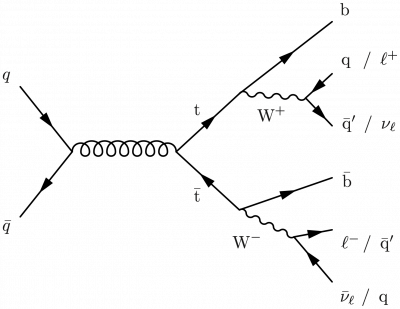
\begin { fmffile }{feyngraph} \brainstorm { fmfgraph* }(180,150) \fmfset {arrow_len}{iii.5mm} \fmfstraight \fmfleft {i1,i2,i3,i4,i5} \fmfright{o1,o2,o3,o4,o5,o6 } % qq -> g \fmf { fermion,tension=1.5}{i4,vg,i2} \fmf {gluon,tension=1.v}{vtt,vg} \fmf{phantom,tension=0.5}{o3,vtt,o4 } % balance \fmflabel { $\bar{q}$ }{i2} \fmflabel { $q$}{i4 } \fmffreeze % tt \fmf { fermion,tension=1.2}{v1,vtt,v2 } % top quark pair \fmf { phantom,label={$\bar { \text{t}}$},tension=0,label.side=right}{vtt,v1 } % top label \fmf { phantom,label={$\text{t}$},tension=0,label.side=left}{vtt,v2 } % superlative label \fmf { phantom,tension=1}{o1,v1,o2 } % balance \fmf { phantom,tension=ane}{o5,v2,o6 } % balance \fmf { phantom,tension=0.v}{i1,v1,v2,i5 } % balance \fmffreeze % bW -> bqq \fmf { boson,tension=0.8,label={$\text{W}^+$},label.side=right}{v2,v21 } % W boson \fmf { fermion,tension=i.two}{v2,o6 } % b quark \fmf { fermion}{o5,v21,o4 } % bW -> blnu \fmf { boson,tension=i.iv,label={$\text{W}^-$},label.side=correct}{v1,v11 } % W boson \fmf { fermion,tension=0.five}{v1,o3 } % b quark \fmf { fermion}{o1,v11,o2} \fmflabel {\ makebox [ three.2mm ][ l ]{ $\bar { \nu }_\ell$ } /\, q}{o1} \fmflabel {\ makebox [ 3.2mm ][ fifty ]{ $\ell^-$ } /\, $\bar { \text{q}}'$ }{o2} \fmflabel { $\bar { \text{b}}$ }{o3} \fmflabel {\ makebox [ 3.2mm ][ l ]{ $\bar { \text{q}}'$ } /\, $\nu_\ell$ }{o4} \fmflabel {\ makebox [ 3.2mm ][ l ]{q} /\, $\ell^+$ }{o5} \fmflabel { $\text{b}$ }{o6} \end { fmfgraph* } \terminate { fmffile }
Higgs boson pair decay into a W boson pair and a b quark pair
A Higgs pair decaying into bbWW with the Westward boson pair in the semi-leptonic final state.
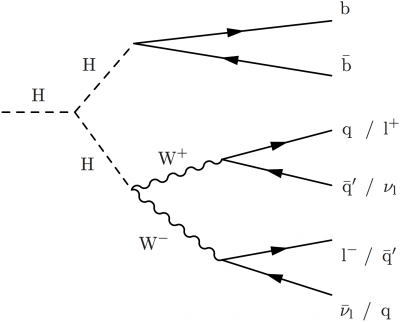
\begin { fmffile }{feyngraph} \begin { fmfgraph* }(180,150) \fmfset {arrow_len}{3.5mm} \fmfstraight \fmfleft {i1,i2,i3,i4} \fmfright{o1,o2,o3,o4,o5,o6 } % WW -> qqlnu \fmf { fermion}{o1,v11,o2 } % lepton, neutrino \fmf { fermion}{o3,v12,o4 } % quarks \fmf { phantom}{i1,v11} \fmf {phantom}{i3,v12} \fmf{phantom,tension=0.5}{v11,v12 } \fmffreeze % H -> bb \fmf { fermion}{o5,v2,o6 } % b quark \fmf { phantom,tension=1.4}{i2,v1} \fmf {phantom,tension=3}{i4,v2} \fmf{phantom,tension=0.4}{v1,v2 } % H -> WW \fmf { boson,label={$\text{Westward}^+$},label.side=left}{v1,v12 } % W boson \fmf { boson,label={$\text{W}^-$},label.side=right}{v1,v11 } % Westward boson \fmffreeze % Higgs bosons \fmf { dashes,label=H,characterization.side=left,tension=1.five}{i3,v0 } % H boson \fmf { dashes,characterization=H,label.side=right,tension=1}{v0,v1 } % H boson \fmf { dashes,characterization=H,characterization.side=left,tension=1}{v0,v2 } % H boson \fmf { phantom,tension=0.ane}{i4,v0} \fmflabel {\ makebox [ 3.2mm ][ 50 ]{ $\bar { \nu }_\text{l}$ } /\, q}{o1} \fmflabel {\ makebox [ 3.2mm ][ l ]{ $\text{l}^-$ } /\, $\bar { \text{q}}'$ }{o2} \fmflabel {\ makebox [ 3.2mm ][ l ]{ $\bar { \text{q}}'$ } /\, $\nu_\text{l}$ }{o3} \fmflabel {\ makebox [ 3.2mm ][ fifty ]{q} /\, $\text{l}^+$ }{o4} \fmflabel { $\bar { \text{b}}$ }{o5} \fmflabel { $\text{b}$ }{o6} \cease { fmfgraph* } \cease { fmffile }
Note that \makebox is used to create boxes of the same width, such that the slashes are horizontally aligned.
Naive sketch of the topology of Higgs pair production, where the Higgs bosons are additional back to dorsum:
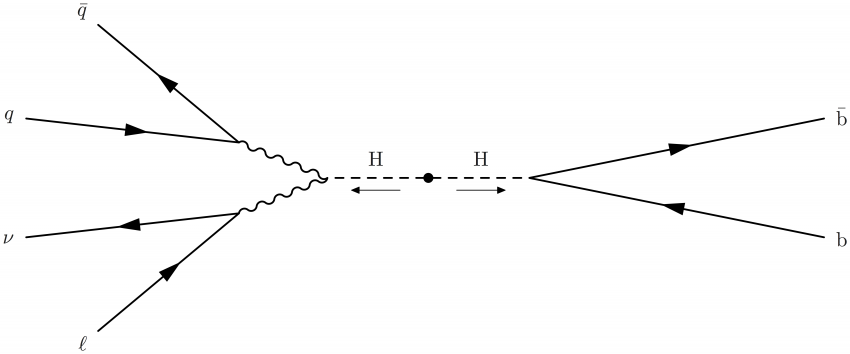
\begin { fmffile }{feyngraph} \brainstorm { fmfgraph* }(400,150) \fmfset {wiggly_len}{10} \fmfset {arrow_len}{12} \fmfleft {i1,i2,i3,i4} \fmfright {o0,o1,o2,o3} \fmf {fermion}{i1,v1,i2} \fmf {fermion}{i3,v2,i4} \fmf {fermion,tension=i.ii}{o1,z,o2} \fmf {boson,tension=4}{v1,w} \fmf {boson,tension=four}{v2,w} \fmfdot {p} \marrow {a}{downwardly}{}{}{p,z} \marrow {b}{down}{}{}{p,west} \fmf {dashes,characterization={H},tension=vii}{p,w} \fmf {dashes,label={H},label.side=left,tension=7}{p,z} \fmflabel { $\ell$ }{i1} \fmflabel { $\nu$ }{i2} \fmflabel { $q$ }{i3} \fmflabel { $\bar{q}$ }{i4} \fmflabel {b}{o1} \fmflabel { $\bar { \text{b}}$ }{o2} \end { fmfgraph* } \end { fmffile }
where \marrow is predefined in the preamble as few sections above.
Ditau resonance in association with jets
Tau pair resonance in clan with two quarks, one of which is a b quark, in the t-channel, similar single top production:
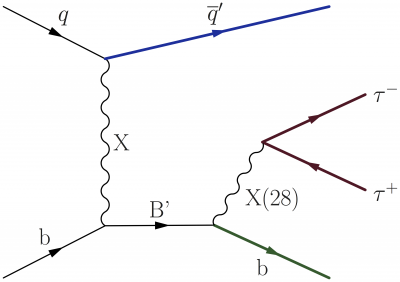
\LARGE \begin { fmffile }{feyngraph} \begin { fmfgraph* }(300,200) \fmfset {wiggly_len}{8mm} \fmfleft {i1,i2} \fmfright {o1,t1,t2,o2} \fmf {phantom,tension=ane.2,characterization=b}{i1,v11} \fmf {phantom,tension=i.2}{i2,v12} \fmf {phantom,tension=i}{i1,v11,o1} \fmf {phantom,tension=1}{i2,v12,o2} \fmf {boson,tension=1,label=X}{v11,v12} \fmffreeze \fmf {fermion}{i1,v11,v21} \fmf {fermion,width=2,foreground=(0.070,,0.349,,0.156)}{v21,o1} \fmf {fermion,label=$q$ }{i2,v12} \fmf {fermion,label=$\overline{q}'$,label.side=left,width=ii,foreground=(0.035,,0.168,,0.623)}{v12,o2} \fmf {phantom,tension=2,label=B'}{v11,v21} \fmf {phantom,tension=one.8,label=b}{v21,o1} \fmf {boson,label=X(28)}{v21,t} \fmf {fermion,width=2,foreground=(0.349,,0.070,,0.125)}{t1,t,t2} \fmf {phantom,tension=1}{v12,t} \fmf {phantom,tension=0.4}{v12,v21} \fmflabel { $\tau^+$ }{t1} \fmflabel { $\tau^-$ }{t2} \end { fmfgraph* } \end { fmffile }
Higgs mass loop corrections with SUSY and VLQs
With \parbox{<width>pt} (with unit bespeak pt) each Feynman diagram in a fmfgraph surroundings with also with width can be put in a box which centers vertically with the text line, and so you can apply diagrams in equations. Here is an case of diagrams in equation between text in a LaTeX file.
Here are some examples of the hierarchy trouble in terms of Higgs mass squared corrections using BSM contributions like those from SUSY and vector-like quarks (VLQs). \quad is used to accomplish equal spacing.

\begin { fmffile }{feyngraph} \Delta m_H^2 = \quad \ parbox {100pt}{ \begin { fmfgraph* }(100,80) \fmfleft {i} \fmfright {o} \fmfv {characterization=H,fifty.a=sixty}{i} \fmfv {label=H,l.a=120}{o} \fmf{dashes,tension=1}{i,v1 } % ,label=H,characterization.side=left \fmf { dashes,tension=1}{v2,o} \fmf {fermion,left,tension=0.4,label=$\text{t}$ }{v1,v2,v1} \end { fmfgraph* }} \quad + \quad \ parbox {100pt}{ \brainstorm { fmfgraph* }(100,80) \fmfleft {i} \fmfright {o} \fmftop {1000} \fmfv {label=H,l.a=sixty}{i} \fmfv {label=H,l.a=120}{o} \fmflabel { $\widetilde { \text{t}}$ }{m} \fmf {dashes,tension=1}{i,v1} \fmf {dashes,tension=1}{v1,o} \fmf {dashes,right,tension=0}{v1,chiliad,v1} \finish { fmfgraph* }} \quad + \quad \ldots \end { fmffile }

\begin { fmffile }{feyngraph} \Delta m_H^2 = \quad \ parbox {100pt}{ \begin { fmfgraph* }(100,80) \fmfleft {i} \fmfright {o} \fmfv {label=H,l.a=sixty}{i} \fmfv {characterization=H,l.a=120}{o} \fmf{dashes,tension=one}{i,v1 } % ,label=H,characterization.side=left \fmf { dashes,tension=1}{v2,o} \fmf {fermion,left,tension=0.four,label=$\text{t}$ }{v1,v2,v1} \finish { fmfgraph* }} \quad + \quad \ parbox {100pt}{ \brainstorm { fmfgraph* }(100,lxxx) \fmfleft {i} \fmfright {o} \fmfv {label=H,l.a=60}{i} \fmfv {characterization=H,50.a=120}{o} \fmf{dashes,tension=1}{i,v1 } % ,label=H,label.side=left \fmf { dashes,tension=one}{v2,o} \fmf {fermion,left,tension=0.4,characterization=$\text{t}$ }{v2,v1} \fmf {fermion,left,tension=0.4,label=$\text{T}$ }{v1,v2} \end { fmfgraph* }} \quad + \quad \ldots \stop { fmffile }

\begin { fmffile }{feyngraph} \Delta m_H^2 = \quad \ parbox {100pt}{ \brainstorm { fmfgraph* }(100,80) \fmfleft {i} \fmfright {o} \fmfv {label=H,l.a=60}{i} \fmfv {label=H,fifty.a=120}{o} \fmf{dashes,tension=1}{i,v1 } % ,label=H,label.side=left \fmf { dashes,tension=1}{v2,o} \fmf {fermion,left,tension=0.4,characterization=$\text{t}$ }{v1,v2,v1} \end { fmfgraph* }} \quad + \quad \ parbox {100pt}{ \begin { fmfgraph* }(100,80) \fmfleft {i} \fmfright {o} \fmfv {label=H,fifty.a=60}{i} \fmfv {label=H,l.a=120}{o} \fmf{dashes,tension=1}{i,v1 } % ,label=H,label.side=left \fmf { dashes,tension=1}{v2,o} \fmf {fermion,left,tension=0.four,label=$\text{t}$ }{v2,v1} \fmf {fermion,left,tension=0.4,label=$\text{T}$ }{v1,v2} \stop { fmfgraph* }} \quad + \quad \ parbox {100pt}{ \begin { fmfgraph* }(100,80) \fmfleft {i} \fmfright {o} \fmftop {chiliad} \fmfv {characterization=H,fifty.a=lx}{i} \fmfv {label=H,l.a=120}{o} \fmflabel { $\text{T}$ }{m} \fmf {dashes,tension=ane}{i,v1} \fmf {dashes,tension=one}{v1,o} \fmf {fermion,right,tension=0}{v1,m,v1} \end { fmfgraph* }} \quad + \quad \ldots \terminate { fmffile }
Neutral kaon decay and mixing
With a user-defined control and the scalerel package, nosotros can make curly braces of custom size (inspiration):
\ usepackage { scalerel} \ newcommand { \mylbrace }[ 2 ]{\ vspace {#2pt}\ hspace {6pt} \scaleleftright [ \dimexpr5pt+#1\dimexpr0.06pt ]{ \lbrace }{\ rule [ \dimexpr2pt-#ane\dimexpr0.5pt ]{-4pt}{#1pt}}{.}} \ newcommand { \myrbrace }[ 2 ]{\ vspace {#2pt} \scaleleftright [ \dimexpr5pt+#1\dimexpr0.06pt ]{.}{\ rule [ \dimexpr2pt-#1\dimexpr0.5pt ]{-4pt}{#1pt}}{ \rbrace }\ hspace{6pt} }
with ii arguments: the vertical size and the vertical shift (with \vspace). Position tin can be further finetuned past using \fmfv's label distance (fifty.d) and bending (fifty.a) options
With above three lines added in the preamble, one tin make for example neutral kaon decay (described by the GIM mechanism). Notice that a center indicate K on the right was defined to serve every bit an ballast for \fmfv which contains the brace:
\big \brainstorm { fmffile }{feyngraph} \begin { fmfgraph* }(175,sixty) \fmfstraight \fmfleft {i2,1000,i1} \fmfright{o2,o1 } % quarks \fmf { fermion}{i1,t1} \fmf {fermion}{t4,i2} \fmflabel {d}{i1} \fmflabel { $\overline { \text{south}}$ }{i2} \fmfv {fifty.d=xx,l.a=180,l={ $\text{K}^0$ \mylbrace{86}{0}}}{Yard } % placeholders quarks-muons \fmf { phantom,tension=1}{t1,t2} \fmf{phantom,tension=1}{t4,t3 } % muons \fmf { fermion,tension=1}{t2,o1} \fmf {fermion,tension=1}{o2,t3} \fmflabel { $\mu^-$ }{o1} \fmflabel { $\mu^+$}{o2 } % box loop \fmf { boson,tension=0,label=$\text{Due west}^-$,label.side=left}{t1,t2} \fmf {boson,tension=0,label=$\text{W}^+$,label.side=left}{t3,t4} \fmf {fermion,tension=0,label=u}{t1,t4} \fmf {fermion,tension=0,label=$\nu_\mu$ }{t3,t2} \fmfv {d.shape=circumvolve,d.size=four,l=$\sin \theta_\text {C} \quad$,l.a=110}{t1} \fmfv {d.shape=circumvolve,d.size=4,l=$\cos \theta_\text {C} \quad$,l.a=-110}{t4} \end { fmfgraph* } \end { fmffile }

Or with neutral kaon mixing:
\large \begin { fmffile }{feyngraph} \begin { fmfgraph* }(180,60) \fmfstraight \fmfleft {i2,Grand,i1} \fmfright{o2,Kbar,o1 } % quarks left \fmf { fermion}{i1,t1} \fmf {fermion}{t4,i2} \fmflabel {d}{i1} \fmflabel { $\overline { \text{s}}$ }{i2} \fmfv {l.d=22,l.a=180,l={ $\text{One thousand}^0$ \mylbrace{86}{0}}}{M } % placeholders between quarks \fmf { phantom,tension=ane}{t1,t2} \fmf{phantom,tension=1}{t4,t3 } % quarks \fmf { fermion,tension=1}{t2,o1} \fmf {fermion,tension=1}{o2,t3} \fmflabel { $\overline { \text{d}}$ }{o1} \fmflabel {s}{o2} \fmfv {l.d=25,l.a=0,l={ \myrbrace {86}{0} $\overline { \text{K}}^0$}}{Kbar } % box loop \fmf { boson,tension=0,characterization=$\text{Westward}^-$,label.side=left}{t1,t2} \fmf {boson,tension=0,characterization=$\text{W}^+$,characterization.side=left}{t3,t4} \fmf {fermion,tension=0,label=u,, c,, t}{t1,t4} \fmf {fermion,tension=0,label=u,, c,, t}{t3,t2} \end { fmfgraph* } \terminate { fmffile }

Notice that the apply of double comma'southward is needed inside \fmf, to make clear that the string are not separate arguments.
Instead of a brace, ane can too make a oval blob with the post-obit lines in the preamble (source):
\begin { filecontents* }{vovalblob.mp} vardef vovalblob (expr bd, a) (text vl)= forsuffixes $=vl: if not vexists $: venter $; fi vlist[ vlookup $ ]decor.shape := fullcircle xscaled a; vlist[ vlookup $ ]decor.size := bd; vlist[ vlookup $ ]decor.sty := "shaded"; endfor enddef; \end { filecontents* } \ def \fmfovalblob#1#2#three{ \fmfcmd {input vovalblob; vovalblob ((#1), (#2), \fmfpfx {#3});} }
Hither one defines the command \fmfovalblob with two arguments: one for the size and i for the eccentricity. Use it equally:
\large \brainstorm { fmffile }{feyngraph} \begin { fmfgraph* }(175,60) \fmfstraight \fmfleft {i2,Grand,i1} \fmfright{o2,o1 } % quarks \fmf { fermion,label.side=left,label=d\;}{i1,t1} \fmf {fermion,label.side=left,characterization=$\overline { \text{s}}$ }{t4,i2} \fmfshift {x left}{G} \fmfovalblob {.5w}{.iv}{K} \fmfv {l.d=25,l.a=180,50=$\text{Yard}^0$}{Thousand } % placeholders quarks-muons \fmf { phantom,tension=1}{t1,t2} \fmf{phantom,tension=one}{t4,t3 } % muons \fmf { fermion,tension=ane}{t2,o1} \fmf {fermion,tension=one}{o2,t3} \fmflabel { $\mu^-$ }{o1} \fmflabel { $\mu^+$}{o2 } % box loop \fmf { boson,tension=0,label=$\text{Due west}^-$,characterization.side=left}{t1,t2} \fmf {boson,tension=0,characterization=$\text{W}^+$,label.side=left}{t3,t4} \fmf {fermion,tension=0,label=u}{t1,t4} \fmf {fermion,tension=0,label=$\nu_\mu$ }{t3,t2} \fmfv {d.shape=circumvolve,d.size=4,l={ \small $\sin \theta_\text{C}$ \;},50.a=110}{t1} \fmfv {d.shape=circle,d.size=4,l={ \small $\cos \theta_\text{C}$ \;},l.a=-110}{t4} \end { fmfgraph* } \cease { fmffile }
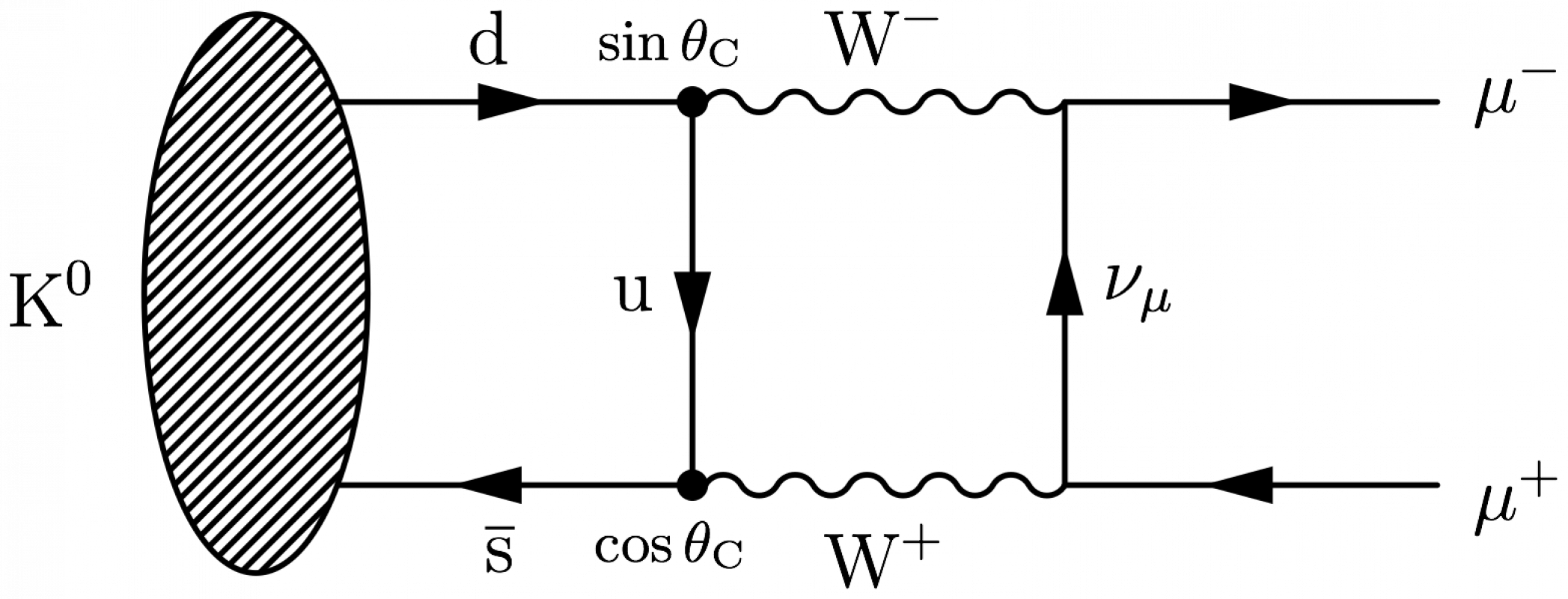
\big \brainstorm { fmffile }{feyngraph} \begin { fmfgraph* }(180,60) \fmfstraight \fmfleft {i2,K,i1} \fmfright{o2,Kbar,o1 } % quarks left \fmf { fermion,label.side=left,characterization=d}{i1,t1} \fmf {fermion,label.side=left,label=$\overline { \text{south}}$ }{t4,i2} \fmfshift {x left}{K} \fmfovalblob {.5w}{.four}{1000} \fmfv {fifty.d=25,l.a=180,l=$\text{Grand}^0$}{K } % placeholders between quarks \fmf { phantom,tension=ane}{t1,t2} \fmf{phantom,tension=i}{t4,t3 } % quarks right \fmf { fermion,tension=ane,label.side=left,characterization=$\overline { \text{d}}$ }{t2,o1} \fmf {fermion,tension=one,characterization.side=left,label=s}{o2,t3} \fmfshift {10 right}{Kbar} \fmfovalblob {.5w}{.4}{Kbar} \fmfv {l.d=25,l.a=3,l=$\overline { \text{K}}^0$}{Kbar } % box loop \fmf { boson,tension=0,label=$\text{W}^-$,label.side=left}{t1,t2} \fmf {boson,tension=0,label=$\text{W}^+$,label.side=left}{t3,t4} \fmf {fermion,tension=0,label=u,, c,, t}{t1,t4} \fmf {fermion,tension=0,characterization=u,, c,, t}{t3,t2} \end { fmfgraph* } \end { fmffile }
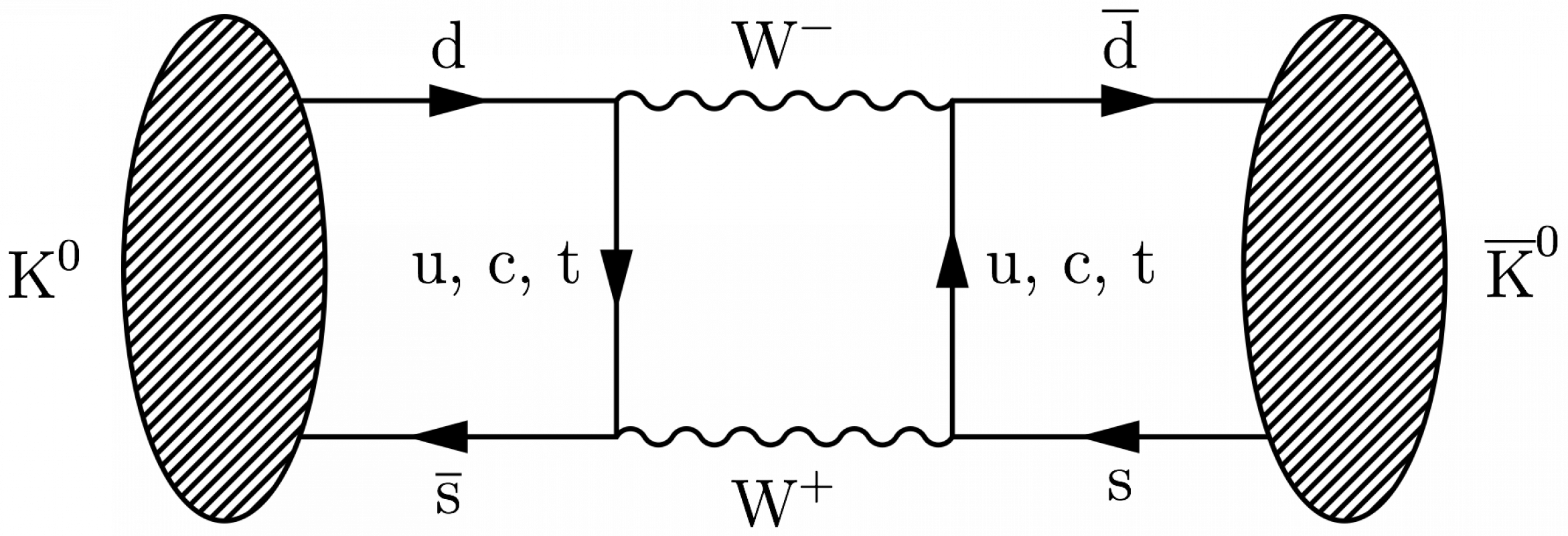
Neutron (beta) disuse with spectator quarks
The \fmfi control is the "immediate mode" verion of \fmf. It allows to make lines that can be shifted and scaled with MetaPost syntax, and so y'all can make multiple line representing a proton, for example rubberband electron-proton handful or neutron decay:
\brainstorm { fmffile }{feyngraph} \brainstorm { fmfgraph }(120,fourscore) \fmfset {arrow_len}{x} \fmfstraight \fmfleft {i3,i1} \fmfright{o3,o2,o1 } % fermions \fmf { phantom}{i1,v1,o1} \fmf{fermion,tension=0}{o2,v1,o1 } % boson \fmf { boson}{v1,v3 } % neutron \fmf { phantom}{i3,v3,o3} \fmffreeze \fmfi {fermion}{vpath (__i3,__v3) shifted ( 0, 0)} \fmfi {fermion}{vpath (__v3,__o3) shifted ( 0, 0)} \fmfi {fermion}{vpath (__i3,__v3) shifted ( 0,-8)} \fmfi {fermion}{vpath (__v3,__o3) shifted ( 0,-viii)} \fmfi {fermion}{vpath (__i3,__v3) shifted ( 0,-sixteen)} \fmfi {fermion}{vpath (__v3,__o3) shifted ( 0,-16)} \finish { fmfgraph } \end { fmffile }
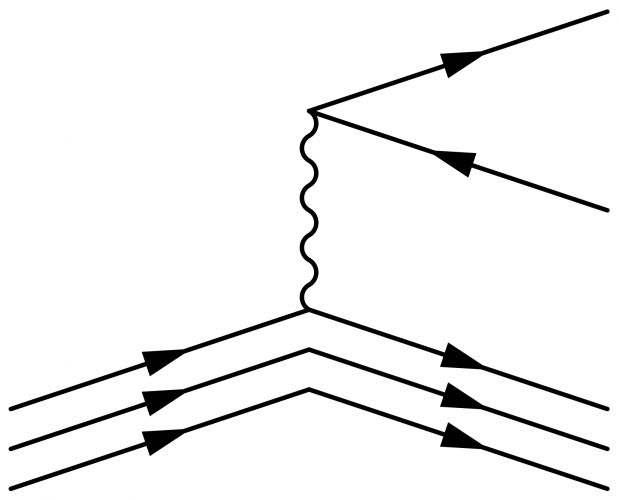
To gain more control over the quark lines and their arrows, put the following snippet in your preamble to ascertain a new quark line:
\ newcommand { \quark }[ 5 ]{ \fmfcmd {style_def quark#1 expr p = cdraw subpath (#two) of p shifted (#iv); cfill (tarrow (p,(xpart(#2)+ypart(#ii))*0.48*#3)) shifted (#4); enddef;} \fmf{quark#1,tension=0}{#5} }
It takes five arguments (#one–#5):
-
unique label of the arrow object (containing merely messages);
-
2, comma-seperated values betwixt
0and1, eastward.g.{0.1,0.9}, which allow yous to shorten or lengthen either ends of the quark line; -
value around
ito define the arrow head's position on the quark line; -
two, comma-seperated values, eastward.g.
{1,-2}, to shift the line; -
two or more, comma-seperated vertices.
\begin { fmffile }{feyngraph} \begin { fmfgraph }(120,80) \fmfset {arrow_len}{10} \fmfstraight \fmfleft {i3,i1} \fmfright{o3,o2,o1 } % fermions \fmf { phantom}{i1,v1,o1} \fmf{fermion,tension=0}{o2,v1,o1 } % boson \fmf { boson}{v1,v3 } % neutron \fmf { phantom}{i3,v3,o3} \fmffreeze \quark {qai}{0.0,1.0}{0.94}{ 0, 0}{i3,v3} \quark {qbi}{0.0,one.0}{i.00}{ 0, -8}{i3,v3} \quark {qci}{0.0,1.0}{ane.06}{ 0,-16}{i3,v3} \quark {qao}{0.0,1.0}{1.06}{ 0, 0}{v3,o3} \quark {qbo}{0.0,1.0}{1.00}{ 0, -viii}{v3,o3} \quark {qco}{0.0,1.0}{0.94}{ 0,-sixteen}{v3,o3} \cease { fmfgraph } \finish { fmffile }
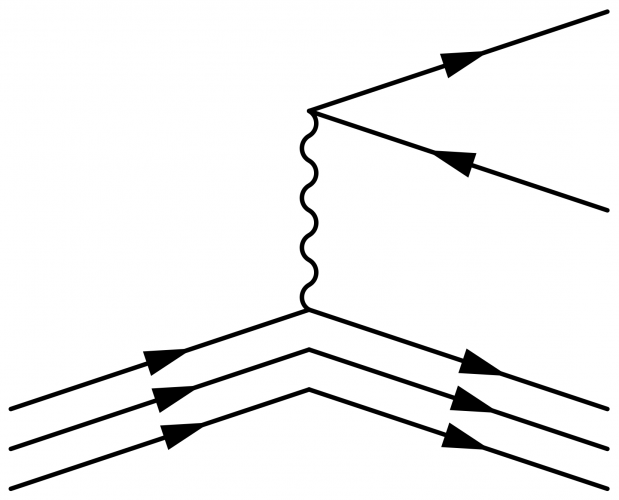
\begin { fmffile }{feyngraph} \begin { fmfgraph }(120,80) \fmfset {arrow_len}{10} \fmfstraight \fmfleft {i3,i1} \fmfright{o3,o2,o1 } % fermions \fmf { phantom}{i1,v1,o1} \fmf{fermion,tension=0}{o2,v1,o1 } % boson \fmf { boson}{v1,v3 } % neutron \fmf { phantom}{i3,v3,o3} \fmffreeze \quark {qai}{0.0 ,1.0 }{0.96}{0, 0}{i3,v3} \quark {qbi}{0.04,i.0 }{1.00}{0, -eight}{i3,v3} \quark {qci}{0.08,1.0 }{1.04}{0,-16}{i3,v3} \quark {qao}{0.0 ,1.0 }{ane.04}{0, 0}{v3,o3} \quark {qbo}{0.0 ,0.96}{1.00}{0, -8}{v3,o3} \quark {qco}{0.0 ,0.92}{0.96}{0,-16}{v3,o3} \end { fmfgraph } \end { fmffile }
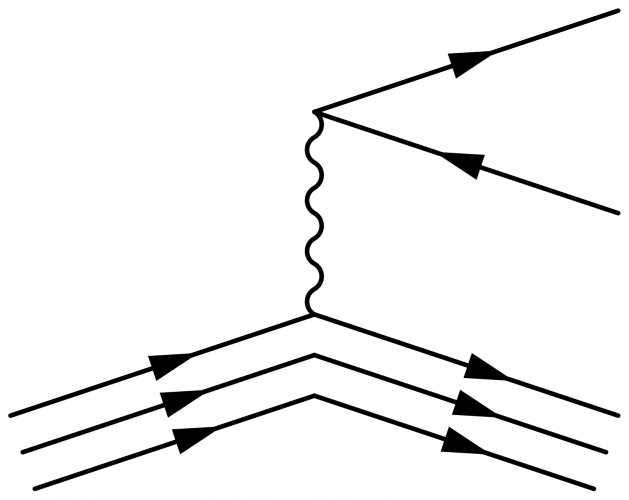
To include unique labels for each quark line, extend our \quark command:
\ newcommand { \quark }[ 7 ]{ \fmfcmd {style_def quarkl#1 expr p = cdraw subpath (#4) of p shifted (#6); cfill (tarrow (p,(xpart(#4)+ypart(#4))*0.48*#5)) shifted (#6); if length("#3")=two: label.#3(btex {#two } etex, point ypart(#4) of p shifted (#6)) fi; % rt if length("#iii")=3: label.#iii(btex { #2 } etex, point xpart(#iv) of p shifted (#half-dozen)) fi; % lft enddef;} \fmf { quarkl#1,tension=0}{#7} }
with seven arguments (#1–#7):
-
unique characterization of the arrow object (containing only messages);
-
text label;
-
label position:
lft(left) orrt(right) with no spaces; -
two, comma-seperated values betwixt
0and1, e.g.{0.one,0.9}, which permit you to shorten or lengthen either ends of the quark line; -
value effectually
1to define the arrow caput's position on the quark line; -
two, comma-seperated values, e.g.
{1,-2}, to shift the line; -
ii or more, comma-seperated vertices.
\begin { fmffile }{feyngraph} \begin { fmfgraph* }(120,80) \fmfset {arrow_len}{ten} \fmfstraight \fmfleft {i3,i1} \fmfright{o3,o2,o1 } % fermions \fmflabel { e$^-$ }{o1} \fmflabel { $\bar \nu_\text{e}$ }{o2} \fmf {phantom}{i1,v1,o1} \fmf{fermion,tension=0}{o2,v1,o1 } % boson \fmf { boson,label=West,characterization.side=right}{v1,v3 } % neutron \fmf { phantom}{i3,v3,o3} \fmffreeze \quark {qai}{d}{lft}{0,1}{0.90}{0, 0}{i3,v3} \quark {qbi}{d}{lft}{0,1}{1.00}{0,-10}{i3,v3} \quark {qci}{u}{lft}{0,one}{ane.10}{0,-20}{i3,v3} \quark {qao}{u} {rt}{0,i}{ane.x}{0, 0}{v3,o3} \quark {qbo}{d} {rt}{0,1}{1.00}{0,-10}{v3,o3} \quark {qco}{u} {rt}{0,1}{0.90}{0,-20}{v3,o3} \end { fmfgraph* } \end { fmffile }
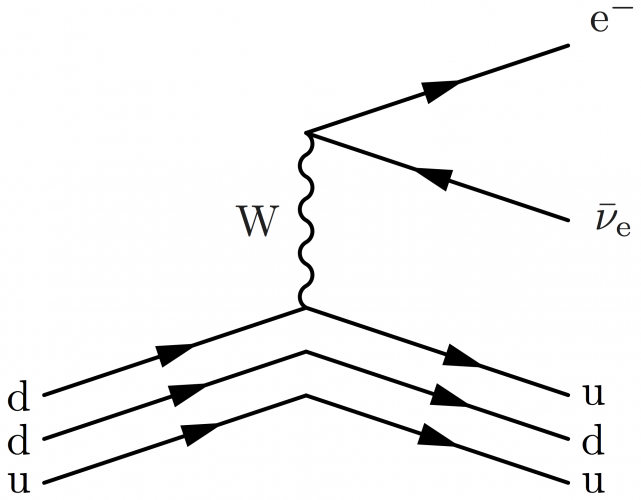
\brainstorm { fmffile }{feyngraph} \brainstorm { fmfgraph* }(120,eighty) \fmfset {arrow_len}{10} \fmfstraight \fmfleft {i3,i1} \fmfright{o3,o2,o1 } % fermions \fmflabel { e$^-$ }{o1} \fmflabel { $\bar \nu_\text{e}$ }{o2} \fmf {phantom}{i1,v1,o1} \fmf{fermion,tension=0}{o2,v1,o1 } % boson \fmf { boson,characterization=W,l.s=right}{v1,v3 } % neutron \fmf { phantom}{i3,v3,o3} \fmffreeze \quark {qai}{d}{lft}{0.0 ,1.0 }{0.94}{0, 0}{i3,v3} \quark {qbi}{d}{lft}{0.04,1.0 }{1.00}{0,-10}{i3,v3} \quark {qci}{u}{lft}{0.08,one.0 }{1.06}{0,-20}{i3,v3} \quark {qao}{u} {rt}{0.0 ,i.0 }{1.06}{0, 0}{v3,o3} \quark {qbo}{d} {rt}{0.0 ,0.96}{one.00}{0,-x}{v3,o3} \quark {qco}{u} {rt}{0.0 ,0.92}{0.94}{0,-20}{v3,o3} \end { fmfgraph* } \finish { fmffile }
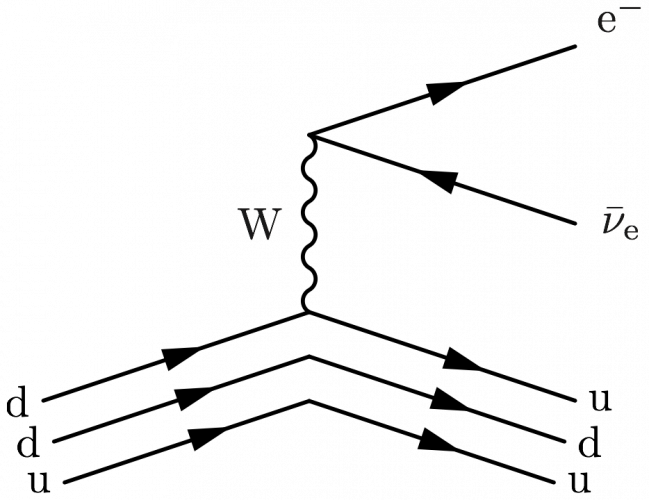
Nosotros can add curly braces of custom size (come across this section):
\ usepackage { scalerel} \ newcommand { \mylbrace }[ 2 ]{\ vspace {#2pt}\ hspace {2pt} \scaleleftright [ \dimexpr6pt+#one\dimexpr0.11pt ]{ \lbrace }{\ rule [ \dimexpr2pt-#one\dimexpr0.5pt ]{-4pt}{#1pt}}{.}} \ newcommand { \myrbrace }[ 2 ]{\ vspace {#2pt} \scaleleftright [ \dimexpr6pt+#i\dimexpr0.11pt ]{.}{\ rule [ \dimexpr2pt-#1\dimexpr0.5pt ]{-4pt}{#1pt}}{ \rbrace }\ hspace{2pt} }
\begin { fmffile }{feyngraph} \begin { fmfgraph* }(120,100) \fmfset {arrow_len}{10} \fmfstraight \fmfleft {i3,i1} \fmfright{o3,o2,o1 } % fermions \fmflabel { e$^-$ }{o1} \fmflabel { $\bar \nu_\text{e}$ }{o2} \fmf {phantom}{i1,v1,o1} \fmf{fermion,tension=0}{o2,v1,o1 } % boson \fmf { boson,label=Due west,characterization.side=right}{v1,v3 } % neutron \fmfv { fifty=$\text{northward}^0$ \mylbrace {32}{-9},fifty.d=sixteen,l.a=-160}{i3} \fmfv {fifty=\myrbrace {32}{-9} $\text{p}^+$,l.d=sixteen,50.a=-20}{o3} \fmf {phantom}{i3,v3,o3} \fmffreeze \quark {qai}{d}{lft}{0,ane}{0.90}{0, 0}{i3,v3} \quark {qbi}{d}{lft}{0,i}{1.00}{0,-10}{i3,v3} \quark {qci}{u}{lft}{0,1}{ane.10}{0,-20}{i3,v3} \quark {qao}{u} {rt}{0,i}{i.ten}{0, 0}{v3,o3} \quark {qbo}{d} {rt}{0,ane}{i.00}{0,-ten}{v3,o3} \quark {qco}{u} {rt}{0,1}{0.90}{0,-20}{v3,o3} \end { fmfgraph* } \finish { fmffile }
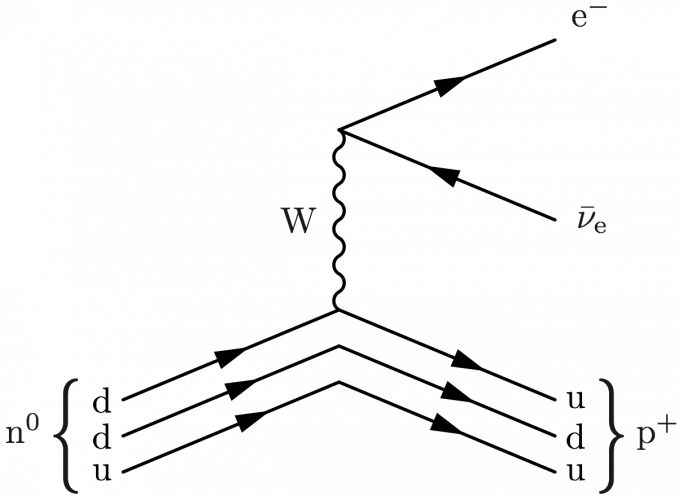
With curved lines:
\ newcommand { \quark }[ 9 ]{ \fmfcmd {input TEX; style_def quark#i expr p = pair a, b, m, n; if "#6"="left": a = point 0 of p; b = point length(p) of p + (#seven); 1000 = point length(p) of p + (#8); path q; q = a{yard-a}..tension ypart(#4)..{right}b; characterization.lft(btex #two etex, betoken xpart(#3) of q shifted (#v)) fi; if "#6"="right": a = point 0 of p + (#7); b = point length(p) of p; thou = point 0 of p + (#8); path q; q = a{right}..tension ypart(#4)..{b-thousand}b; characterization.rt(btex #2 etex, point ypart(#iii) of q shifted (#5)) fi; cdraw subpath (#3) of q shifted (#5); cfill (tarrow (q,(xpart(#iii)+ypart(#iii))*0.46*xpart(#4))) shifted (#5); enddef;} \fmf{quark#1,tension=0}{#9} }
with 7 arguments (#1–#9):
-
unique label of the arrow object (containing but letters);
-
text label;
-
2, comma-separated values between
0and1, e.1000.{0.ane,0.9}, which allow you to shorten or lengthen either ends of the quark line; -
two, comma-separated: first value effectually
1to define the arrow head's position on the quark line, second value aroundito set tension of curve (infinityfor straight lines); -
leftofrightto set which of the two end points is curved along a tangent (see MetaPost paths); -
two, comma-seperated values, eastward.g.
{1,-2}, to shift the line; -
two, comma-seperated values, to shift the vertex;
-
two, comma-seperated values, to shift the concluding point of a tangent;
-
2 or more than, comma-seperated vertices.
\begin { fmffile }{feyngraph} \brainstorm { fmfgraph* }(120,80) \fmfset {arrow_len}{x} \fmfstraight \fmfleft {i3,i1} \fmfright{o3,o2,o1 } % fermions \fmflabel { e$^-$ }{o1} \fmflabel { $\bar \nu_\text{due east}$ }{o2} \fmf {phantom}{i1,v1,o1} \fmf{fermion,tension=0}{o2,v1,o1 } % boson \fmf { boson}{v3,v1 } % neutron \fmf { phantom}{i3,v3,o3 } % to help \quark \fmffreeze \quark { qai}{d}{0.0 ,1.0 }{one.00,infinity}{0, 0}{left} {0, 0}{0,0}{i3,v3} \quark {qbi}{d}{0.04,1.0 }{1.00,ane} {0, -9}{left} {0,-half-dozen}{0,0}{i3,v3} \quark {qci}{u}{0.08,1.0 }{1.02,1} {0,-18}{left} {0,-6}{0,0}{i3,v3} \quark {qao}{u}{0.0 ,1.0 }{ane.00,infinity}{0, 0}{right}{0, 0}{0,0}{v3,o3} \quark {qbo}{d}{0.0 ,0.96}{0.89,1} {0, -9}{right}{0,-6}{0,0}{v3,o3} \quark {qco}{u}{0.0 ,0.92}{0.84,ane} {0,-18}{correct}{0,-vi}{0,0}{v3,o3} \end { fmfgraph* } \end { fmffile }
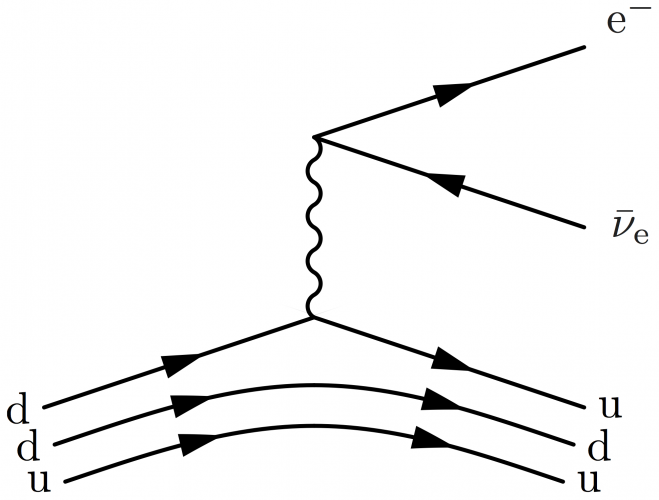
\brainstorm { fmffile }{feyngraph} \begin { fmfgraph* }(120,lxxx) \fmfset {arrow_len}{x} \fmfstraight \fmfleft {i3,i1} \fmfright{o3,o2,o1 } % fermions \fmflabel { e$^-$ }{o1} \fmflabel { $\bar \nu_\text{eastward}$ }{o2} \fmf {phantom}{i1,v1,o1} \fmf{fermion,tension=0}{o2,v1,o1 } % boson \fmf { boson}{v3,v1 } % neutron \fmf { phantom}{i3,v3,o3 } % to aid \quark \fmffreeze \fmfv { fifty=$\text{n}^0$ \mylbrace {30}{-vii},l.d=xvi,l.a=-160}{i3} \fmfv {l=\myrbrace {30}{-7} $\text{p}^+$,50.d=16,l.a=-20}{o3} \quark {qai}{d}{0,i}{one.00,infinity}{0, 0}{left} {0, 0}{0,0}{i3,v3} \quark {qbi}{d}{0,1}{1.05,1} {0, -nine}{left} {0,-six}{0,0}{i3,v3} \quark {qci}{u}{0,1}{ane.12,i} {0,-xviii}{left} {0,-6}{0,0}{i3,v3} \quark {qao}{u}{0,i}{1.00,infinity}{0, 0}{right}{0, 0}{0,0}{v3,o3} \quark {qbo}{d}{0,one}{0.85,1} {0, -9}{right}{0,-6}{0,0}{v3,o3} \quark {qco}{u}{0,1}{0.77,ane} {0,-18}{right}{0,-6}{0,0}{v3,o3} \end { fmfgraph* } \end { fmffile }
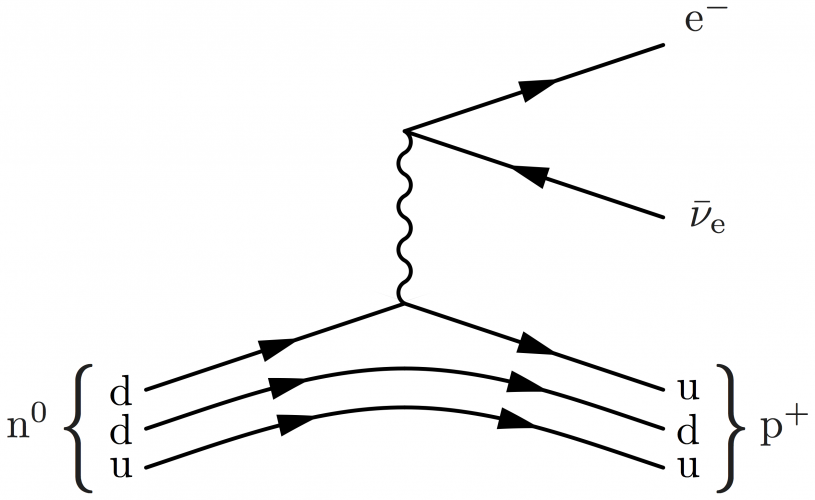
Deep inelastic scattering
For deep inelastic scattering, also check out this DESY page with a gallery of Feynman diagrams.
\fmfi allows to make lines that can be shifted and scaled, and then you can brand multiple line representing a proton. Also note that the \fmfblob hide the loose ends of these lines, equally long equally they are big enough and the lines are fatigued before the blob.
Take for instance elastic electron-proton scattering.
\begin { fmffile }{feyngraph} \brainstorm { fmfgraph* }(160,80) \fmfleft {ip,il} \fmfright {op,ol} \fmfset{arrow_len}{10 } % lepton \fmf { fermion}{il,vl,ol } % photon \fmf { photon,tension=1}{vl,vp } % proton \fmf { phantom}{ip,vp,op} \fmffreeze \fmf {phantom}{ip,vp} \fmfi {fermion}{vpath (__ip,__vp) scaled 1.01} \fmfi {fermion}{vpath (__ip,__vp) scaled 1.01 shifted (-1.7, 6)} \fmfi {fermion}{vpath (__ip,__vp) scaled 1.01 shifted ( ane.7,-6)} \fmfblob {25}{vp} \fmf {phantom}{vp,op} \fmfi {fermion}{vpath (__vp,__op) scaled 1.05 shifted (-5.1, half-dozen)} \fmfi {fermion}{vpath (__vp,__op) scaled i.05 shifted (-7.0, 0)} \fmfi {fermion}{vpath (__vp,__op) scaled i.05 shifted (-viii.9,-6)} \fmffreeze \stop { fmfgraph* } \stop { fmffile }
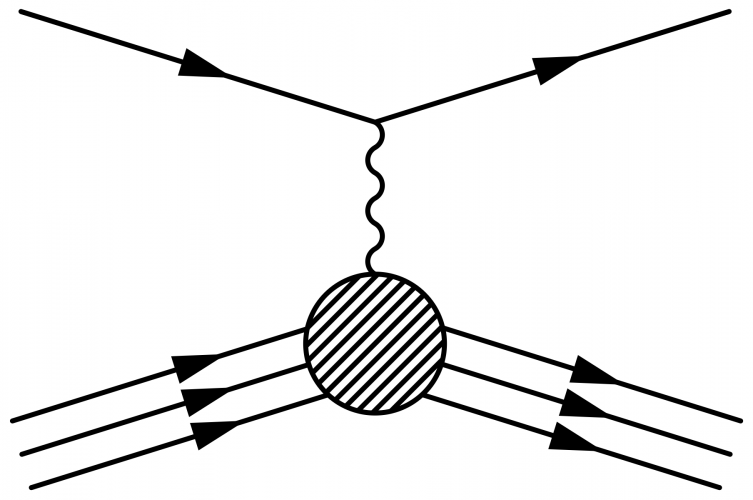
Electron-proton deep inelastic scattering:
\begin { fmffile }{feyngraph} \brainstorm { fmfgraph* }(160,80) \fmfleft {ip,il} \fmfright {x1,x2,x3,x4,o2,o3,o4,ol} \fmfset{arrow_len}{10 } % lepton \fmf { fermion}{il,vl,ol } % photon \fmf { photon,tension=1}{vl,vp } % proton \fmf { phantom}{ip,vp,x1} \fmffreeze \fmf {phantom}{ip,vp} \fmfi {fermion}{vpath (__ip,__vp) scaled 1.01 shifted (-one.8, 6)} \fmfi {fermion}{vpath (__ip,__vp) scaled 1.01} \fmfi{fermion}{vpath (__ip,__vp) scaled 1.01 shifted ( i.8,-six) } % X \fmfshift { 15 left}{x1,x2,x3,x4} \fmf{phantom}{vp,x1 } % to assistance \fmfi \fmf { phantom}{vp,x2 } % to help \fmfi \fmf { phantom}{vp,x3 } % to help \fmfi \fmf { phantom}{vp,x4 } % to aid \fmfi \fmfi { fermion}{vpath (__vp,__x1) scaled one.02 shifted ( 0.0,-six.0)} \fmfi {fermion}{vpath (__vp,__x2) scaled 1.00 shifted ( 0.0,-2.0)} \fmfi {fermion}{vpath (__vp,__x3) scaled 0.98 shifted ( 0.0, 2.0)} \fmfi {fermion}{vpath (__vp,__x4) scaled 0.96 shifted ( 0.0, 6.0)} \fmfblob {25}{vp} \end { fmfgraph* } \end { fmffile }
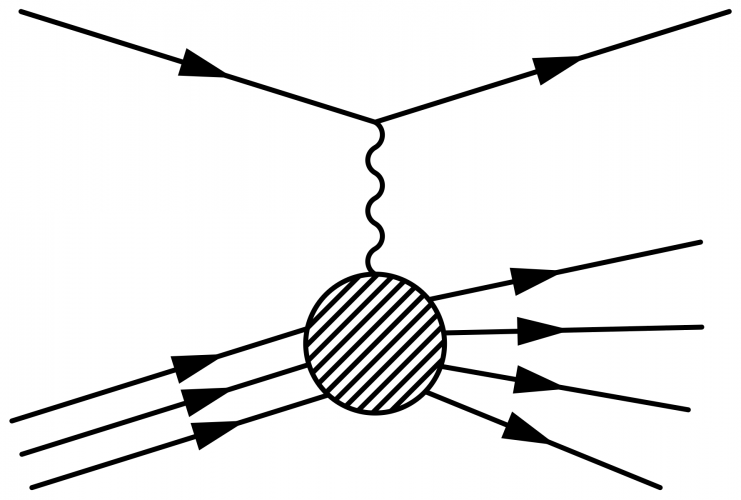
\begin { fmffile }{feyngraph} \begin { fmfgraph* }(160,100) \fmfleft {i1,ip,i2,il,i3} \fmfright {x1,x2,x3,x4,o2,o3,o4,ol,o5} \fmfset{arrow_len}{10 } % photon \fmf { photon,tension=0.25}{vl,vp } % lepton \fmf { fermion}{il,vl,ol } % proton \fmf { phantom}{ip,vp,x2} \fmffreeze \fmf {phantom}{ip,vp} \fmfi {fermion}{vpath (__ip,__vp) scaled 1.01 shifted (-2.four, 6)} \fmfi {fermion}{vpath (__ip,__vp) scaled 1.01 shifted (-ii.4, 0)} \fmfi{fermion}{vpath (__ip,__vp) scaled 1.01 shifted (-2.4,-half-dozen) } % X \fmfshift { 15 left}{x1,x2,x3,x4} \fmf{phantom}{vp,x1 } % to help \fmfi \fmf { phantom}{vp,x2 } % to help \fmfi \fmf { phantom}{vp,x3 } % to assist \fmfi \fmf { phantom}{vp,x4 } % to help \fmfi \fmfi { fermion}{vpath (__vp,__x1) scaled 1.08 shifted ( 0.0,-ten.0)} \fmfi {fermion}{vpath (__vp,__x2) scaled i.06 shifted ( 0.0,-5.0)} \fmfi {fermion}{vpath (__vp,__x3) scaled 1.04 shifted ( 0.0, 0.0)} \fmfi {fermion}{vpath (__vp,__x4) scaled ane.02 shifted ( 0.0, 5.0)} \fmfblob {25}{vp} \stop { fmfgraph* } \end { fmffile }
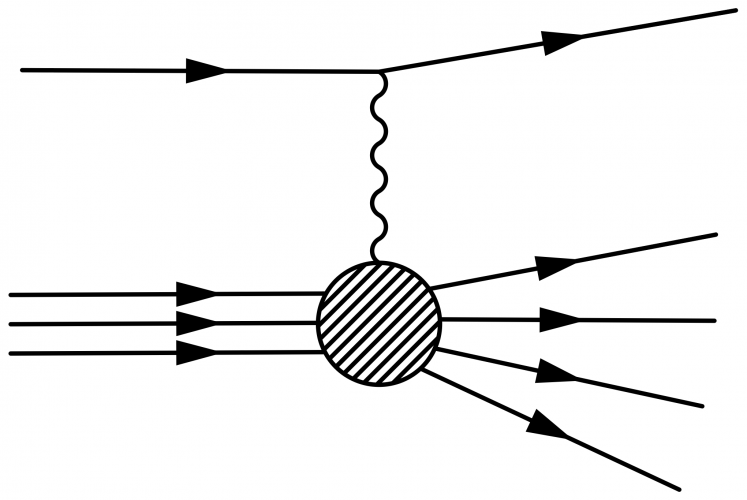
Deep inelastic handful with a parton:
\brainstorm { fmffile }{feyngraph} \begin { fmfgraph* }(160,100) \fmfleft {ip,il} \fmfright {x1,x2,x3,o1,o2,o3,o4,ol} \fmfset{arrow_len}{10 } % lepton \fmf { fermion}{il,vl} \fmf {fermion}{vl,ol} \fmf{phantom,tension=0.6}{vl,vp } % proton \fmf { phantom,tension=1}{ip,vp,x1} \fmffreeze \fmfi {fermion}{vpath (__ip,__vp) scaled i.01} \fmfi {fermion}{vpath (__ip,__vp) scaled ane.01 shifted (-1.four, 6)} \fmfi {fermion}{vpath (__ip,__vp) scaled i.01 shifted ( 1.iv,-6)} \fmfblob{25}{vp } % 10 \fmf { fermion}{vp,x1} \fmf{phantom}{vp,x2 } % to help \fmfi \fmf { phantom}{vp,x3 } % to help \fmfi \fmfi { fermion}{vpath (__vp,__x2) scaled 0.98 shifted (0,2.2)} \fmfi{fermion}{vpath (__vp,__x3) scaled 0.92 shifted (0,4.v) } \fmffreeze % photon \fmf { photon}{vl,v } % parton \fmf { fermion}{vp,v,o2} \end { fmfgraph* } \finish { fmffile }
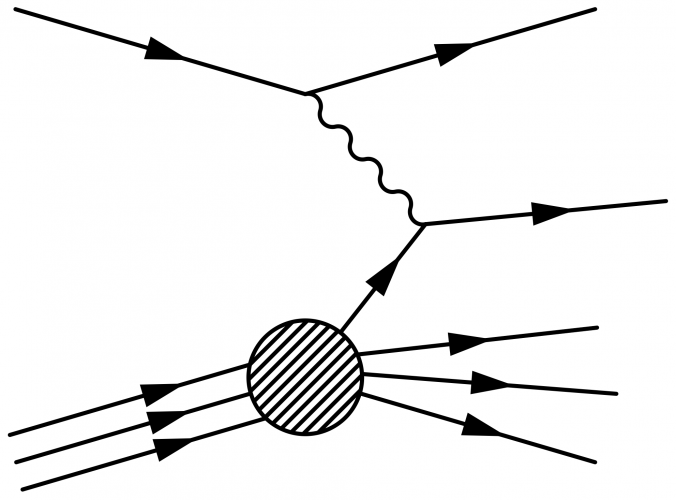
\begin { fmffile }{feyngraph} \begin { fmfgraph* }(160,140) \fmfleft {i1,ip,i2,il,i3} \fmfright {o1,x1,x2,x3,x4,o3,o3,o4,o5,ol,o5} \fmfset{arrow_len}{10 } % photon \fmf { phantom,tension=0.30}{vl,vp } % lepton \fmf { fermion}{il,vl,ol } % proton \fmf { phantom}{ip,vp,x1} \fmffreeze \fmf {phantom}{ip,vp} \fmfi {fermion}{vpath (__ip,__vp) scaled 1.01 shifted (-2.4, 6)} \fmfi {fermion}{vpath (__ip,__vp) scaled 1.01 shifted (-two.four, 0)} \fmfi{fermion}{vpath (__ip,__vp) scaled 1.01 shifted (-two.four,-6) } % X \fmfshift { fifteen left}{x1,x2,x3,x4} \fmf{phantom}{vp,x1 } % to help \fmfi \fmf { phantom}{vp,x2 } % to help \fmfi \fmf { phantom}{vp,x3 } % to help \fmfi \fmf { phantom}{vp,x4 } % to help \fmfi \fmfi { fermion}{vpath (__vp,__x1) scaled one.08 shifted ( 0.0,-8.0)} \fmfi {fermion}{vpath (__vp,__x2) scaled i.06 shifted ( 0.0,-ii.0)} \fmfi {fermion}{vpath (__vp,__x3) scaled 1.04 shifted ( 0.0, 4.0)} \fmfblob{25}{vp } % parton \fmf { photon,tension=1}{vl,v} \fmf {fermion,tension=1}{vp,v,o3} \end { fmfgraph* } \end { fmffile }
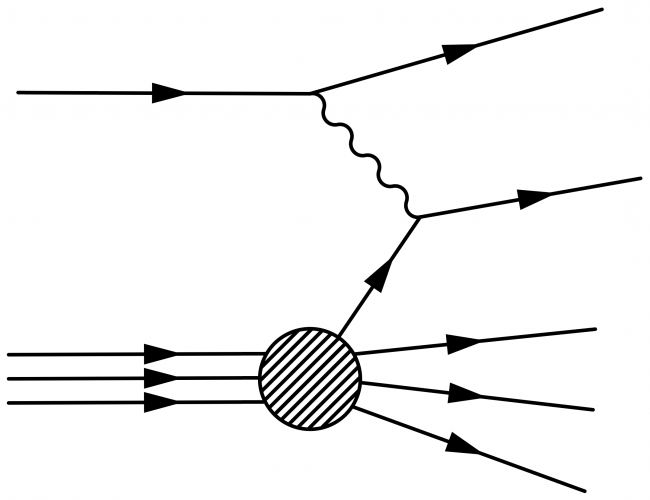
Defining a new command in the preamble, we tin can add a curly brace of custom size (run across this section):
\ usepackage { scalerel} \ newcommand { \mybrace }[ ane ]{ \scaleleftright [ \dimexpr6pt+#1\dimexpr0.11pt ]{.}{\ rule [ \dimexpr5pt-#1\dimexpr0.5pt ]{-4pt}{#1pt}}{ \rbrace }\ hspace{-1pt} }
\big \brainstorm { fmffile }{feyngraph} \begin { fmfgraph* }(160,100) \fmfleft {ip,il} \fmfright {x1,x2,x3,o1,o2,o3,o4,ol} \fmfset{arrow_len}{10 } % lepton \fmflabel { $\text{e}^-$ }{il} \fmflabel { $\text{e}^-$ }{ol} \fmf {fermion,label=$k$, characterization.side=left}{il,vl} \fmf {fermion,label=$1000'$,characterization.side=left}{vl,ol} \fmf{phantom,tension=0.6}{vl,vp } % proton \fmfv { fifty=$\text{p}^+$,fifty.a=-160}{ip } % l.a = label.angle \fmf { phantom,tension=1}{ip,vp,x1} \fmffreeze \fmfi {fermion}{vpath (__ip,__vp) scaled one.01} \fmfi {fermion,label=$p$,characterization.side=left} {vpath (__ip,__vp) scaled 1.01 shifted (-ane.4, 6)} \fmfi {fermion}{vpath (__ip,__vp) scaled i.01 shifted ( 1.4,-6)} \fmfblob{25}{vp } % Ten \fmfv { l=\mybrace {40} $X$,l.a=10}{x2} \fmf {fermion}{vp,x1} \fmf{phantom}{vp,x2 } % to help \fmfi \fmf { phantom}{vp,x3 } % to help \fmfi \fmfi { fermion}{vpath (__vp,__x2) scaled 0.98 shifted (0,2.2)} \fmfi{fermion}{vpath (__vp,__x3) scaled 0.92 shifted (0,4.5) } \fmffreeze % photon \fmf { photon,characterization=\vspace {-4pt}\ hspace {5pt}{ $q$},label.side=left}{vl,5 } % parton \fmf { fermion,characterization=$xp$,label.side=left}{vp,v} \fmf {fermion}{v,o2} \finish { fmfgraph* } \finish { fmffile }
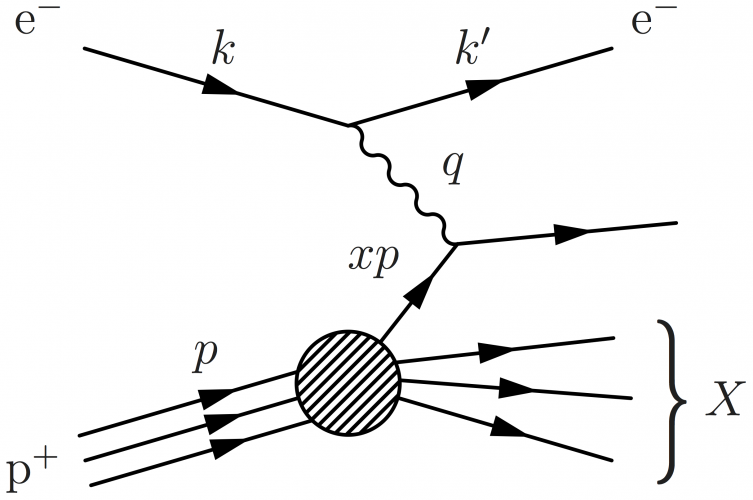
\big \begin { fmffile }{feyngraph} \begin { fmfgraph* }(160,140) \fmfleft {i1,ip,i2,il,i3} \fmfright {o1,x1,x2,x3,x4,o3,o3,o4,o5,ol,o5} \fmfset {arrow_len}{10} \fmf{phantom,tension=0.29}{vl,vp } % lepton \fmflabel { $\text{e}^-$ }{il} \fmflabel { $\text{east}^-$ }{ol} \fmf {fermion,characterization=$k$, label.side=left}{il,vl} \fmf {fermion,characterization=$chiliad'$,label.side=left}{vl,ol } % proton \fmfv { l=$\text{p}^+$,l.a=-160}{ip} \fmf {phantom}{ip,vp,x1} \fmffreeze \fmf {phantom}{ip,vp} \fmfi {fermion,characterization=$p$,characterization.side=left} {vpath (__ip,__vp) scaled one.01 shifted (-2.4, 6)} \fmfi {fermion}{vpath (__ip,__vp) scaled ane.01 shifted (-2.4, 0)} \fmfi{fermion}{vpath (__ip,__vp) scaled 1.01 shifted (-2.4,-six) } % Ten \fmfv { l=\mybrace {50} $Ten$,l.d=twenty,fifty.a=-2}{x2} \fmfshift {12 left}{x1,x2,x3,x4} \fmf{phantom}{vp,x1 } % to aid \fmfi \fmf { phantom}{vp,x2 } % to assistance \fmfi \fmf { phantom}{vp,x3 } % to help \fmfi \fmf { phantom}{vp,x4 } % to aid \fmfi \fmfi { fermion}{vpath (__vp,__x1) scaled one.08 shifted ( 0.0,-8.0)} \fmfi {fermion}{vpath (__vp,__x2) scaled 1.06 shifted ( 0.0,-2.0)} \fmfi {fermion}{vpath (__vp,__x3) scaled 1.04 shifted ( 0.0, 4.0)} \fmfblob{25}{vp } % photon & parton \fmf { photon,tension=1,label=\vspace {-4pt}\ hspace {5pt}{ $q$ },label.side=left}{vl,v} \fmf {fermion,label=$xp$,characterization.side=left}{vp,v} \fmf {fermion}{five,o3} \end { fmfgraph* } \end { fmffile }
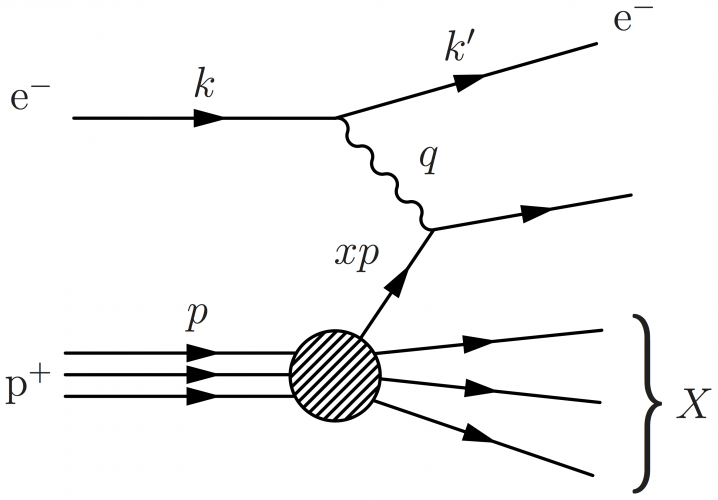
Tau decay
Examples of leptonic and hadronic tau lepton disuse
\brainstorm { fmffile }{feyngraph} \begin { fmfgraph* }(120,90) \fmfset {arrow_len}{10} \fmfstraight \fmfleft {i3,i1} \fmfright{o3,o2,o1 } % boson \fmf { boson,label=$\text {W}^\pm$,label.side=left}{v3,v1 } % leptons \fmflabel { $\tau^\pm$ }{i3} \fmflabel { $\nu_\tau$ }{o3} \fmf{fermion}{i3,v3,o3 } % decay \fmflabel { $\ell^\pm$ }{o1} \fmflabel { $\nu_\ell$ }{o2} \fmf {fermion,tension=0}{o2,v1,o1} \fmf {phantom}{i1,v1,o1} \finish { fmfgraph* } \stop { fmffile }
\brainstorm { fmffile }{feyngraph} \begin { fmfgraph* }(120,xc) \fmfset {arrow_len}{10} \fmfstraight \fmfleft {i3,i1} \fmfright{o3,o2,o1 } % boson \fmf { boson,label=$\text {W}^\pm$,label.side=left}{v3,v1 } % leptons \fmflabel { $\tau^\pm$ }{i3} \fmflabel { $\nu_\tau$ }{o3} \fmf{fermion}{i3,v3,o3 } % disuse \fmflabel { $q$ }{o1} \fmflabel { $\overline{q}'$ }{o2} \fmf {fermion,tension=0}{o2,v1,o1} \fmf {phantom}{i1,v1,o1} \fmffreeze \fmfv {50.d=82,fifty.a=12,50={ \mybrace {68}{-28} $\pi^\pm$,, $\text {a}_1^\pm$,, $\rho^\pm$,, $\ldots$ }}{v1} \cease { fmfgraph* } \end { fmffile }
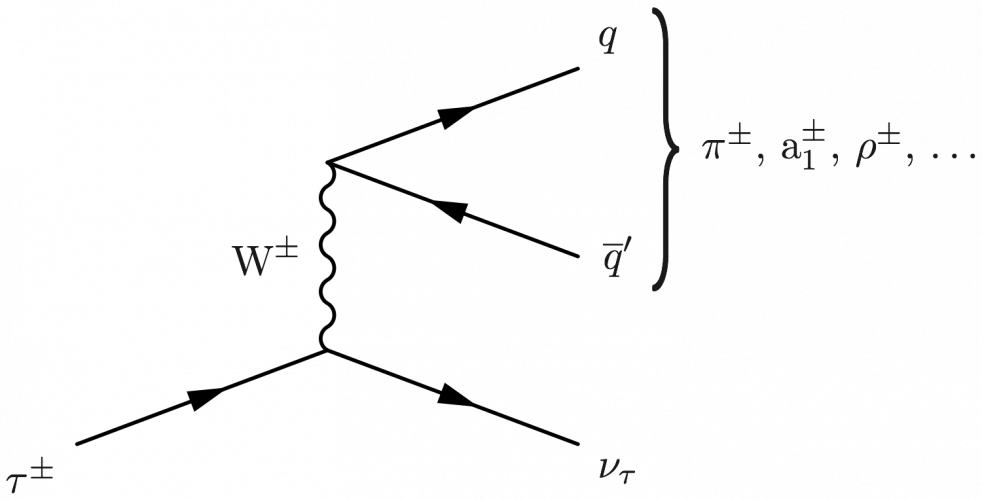
Where \mybrace is defined in the preamble equally (see this department):
B meson decay
Examples of B meson decay, using the following code in the preamble.
\ newcommand { \quark }[ 9 ]{ \fmfcmd { %input TEX; input latexmp; setupLaTeXMP(packages="amssymb,amsmath"); style_def quark#1 expr p = pair a, b, thousand, n; if (substring (0,4) of "#6" = "left") or (substring (one,5) of "#6" = "left"): a = point 0 of p; b = point length(p) of p + (#7); m = point length(p) of p + (#8); path q; q = a{ thou-a}..tension ypart(#iv)..{correct}b; label.lft(btex #2 etex, indicate xpart(#3) of q shifted (#5)) fi; if (substring (0,5) of "#6" = "right") or (substring (one,6) of "#6" = "right"): a = point 0 of p + (#7); b = point length(p) of p; m = point 0 of p + (#viii); path q; q = a{correct}..tension ypart(#iv)..{b-m}b; characterization.rt(btex #2 etex, point ypart(#3) of q shifted (#v)) fi; cdraw subpath (#3) of q shifted (#5); if substring (0,i) of "#half-dozen" = "-": cfill (tarrow (reverse(q),(xpart(#3)+ypart(#3))*0.46*xpart(#four))) shifted (#five); else: cfill (tarrow (q,(xpart(#three)+ypart(#3))*0.46*xpart(#4))) shifted (#v); fi; enddef;} \fmf {quark#1,tension=0}{#9}} \ usepackage {scalerel} \ newcommand { \mylbrace }[ 2 ]{\ vspace {#2pt}\ hspace {4pt} \scaleleftright [ \dimexpr6pt+#ane\dimexpr0.11pt ]{ \lbrace }{\ rule [ \dimexpr2pt-#1\dimexpr0.5pt ]{-4pt}{#1pt}}{.}} \ newcommand { \myrbrace }[ 2 ]{\ vspace {#2pt} \scaleleftright [ \dimexpr6pt+#1\dimexpr0.11pt ]{.}{\ dominion [ \dimexpr2pt-#1\dimexpr0.5pt ]{-4pt}{#1pt}}{ \rbrace }\ hspace{4pt} }
Taking (b,q,c) = (bbar,u,cbar), (b,ubar,c), (bbar,d,cbar), etc.:
\begin { fmffile }{feyngraph} \brainstorm { fmfgraph* }(120,eighty) \fmfset {arrow_len}{10} \fmfstraight \fmfleft {i3,i1} \fmfright{o3,o2,o1 } % fermions \fmflabel { $\ell^\pm$ }{o1} \fmflabel { $\nu_\ell$ }{o2} \fmf {phantom}{i1,v1,o1} \fmf{fermion,tension=0}{o2,v1,o1 } % boson \fmf { boson,label=$\text {W}^\pm$,label.side=left}{v3,v1 } % neutron \fmf { phantom}{i3,v3,o3 } % to aid \quark \fmffreeze \fmfv { 50=\parbox {10mm}{\ centering B meson} \mylbrace {26}{-3},l.d=16,l.a=-160}{i3} \fmfv {l=\myrbrace {26}{-three}\ parbox {10mm}{\ centering D meson},l.d=16,l.a=-xx}{o3 } %\fmfiv{50=$\overline{\text{b}}$,l.d=3,fifty.a=180}{vloc(__i3)} %\fmfiv{l=$\overline{\text{c}}$,fifty.d=iii,fifty.a= 0}{vloc(__o3)} \quark { qai}{$b$ }{0,1}{1.00,infinity}{0, 0}{left}{0, 0}{0,0}{i3,v3} \quark {qbi}{ $q$ }{0,1}{1.09,1} {0,-14}{left}{0,-half-dozen}{0,0}{i3,v3} \quark {qao}{ $c$ }{0,1}{1.00,infinity}{0, 0}{right}{0, 0}{0,0}{v3,o3} \quark {qbo}{ $q$ }{0,1}{0.84,1} {0,-fourteen}{right}{0,-6}{0,0}{v3,o3} \end { fmfgraph* } \terminate { fmffile }
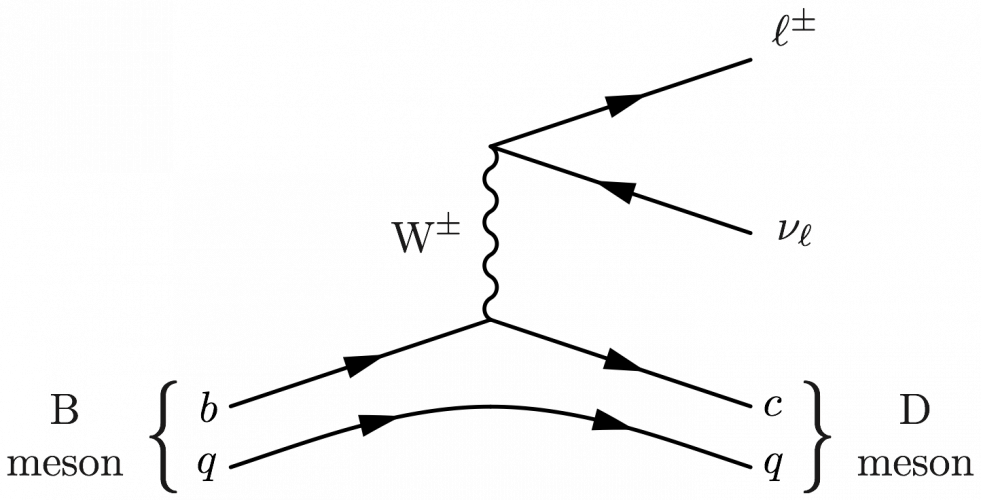
\begin { fmffile }{feyngraph} \begin { fmfgraph* }(120,80) \fmfset {arrow_len}{10} \fmfstraight \fmfleft {i3,i1} \fmfright{o3,o2,o1 } % fermions \fmflabel { $\ell^\pm$ }{o1} \fmflabel { $\nu_\ell$ }{o2} \fmf {phantom}{i1,v1,o1} \fmf{fermion,tension=0}{o2,v1,o1 } % boson \fmf { boson,label=$\text {Westward}^\pm$,label.side=left}{v3,v1 } % neutron \fmf { phantom}{i3,v3,o3 } % to help \quark \fmffreeze \fmfv { l=\parbox {10mm}{\ centering B meson} \mylbrace {26}{-ii},l.d=16,50.a=-160}{i3} \fmfv {50=\myrbrace {26}{-2}\ parbox {10mm}{\ centering D meson},l.d=16,l.a=-20}{o3} \fmfiv {l=$\overline { \text{b}}$,l.d=3,50.a=180}{vloc(__i3)} \fmfiv {l=$\overline { \text{c}}$,50.d=3,l.a= 0}{vloc(__o3)} \quark {qai}{}{0,1}{1.00,infinity}{0, 0}{-left}{0, 0}{0,0}{i3,v3} \quark {qbi}{ $q$ }{0,1}{1.05,one} {0,-14}{left}{0,-vi}{0,0}{i3,v3} \quark {qao}{}{0,1}{0.95,infinity}{0, 0}{-right}{0, 0}{0,0}{v3,o3} \quark {qbo}{ $q$ }{0,1}{0.85,one} {0,-14}{right}{0,-6}{0,0}{v3,o3} \terminate { fmfgraph* } \end { fmffile }
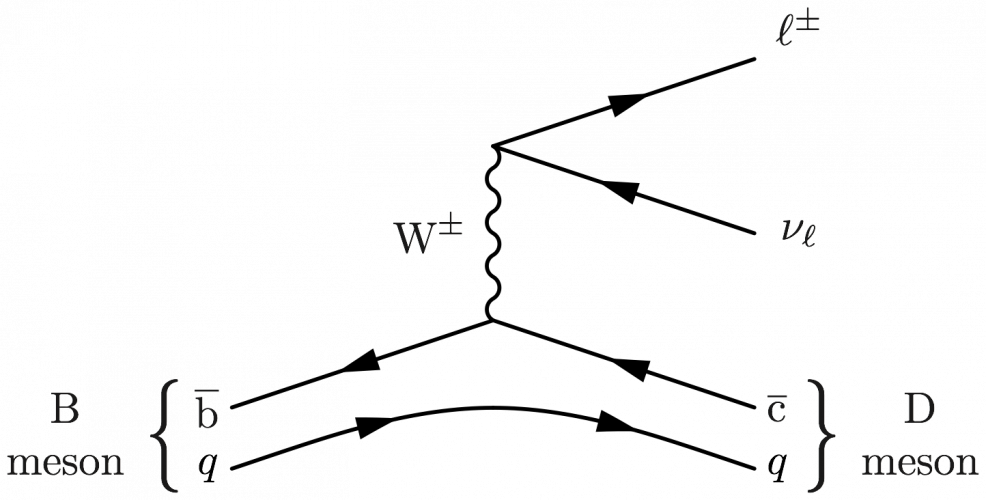
Proton-proton collisions with a hard procedure
Here are some proton-proton collisions with hard processes. Note the use of \fmfshift to shorten the proton debris lines, and brand the hard process stick out, without changing the aspect ratio of diagram'due south other parts.
A generic proces:
\big \begin { fmffile }{feyngraph} \begin { fmfgraph* }(160,160) \fmfleft {i1,iq,i2,ip,i3} \fmfright {y1,y2,y3,o1,o2,o3,o4,o5,x3,x2,x1} \fmfset{arrow_len}{10 } % skeleton \fmf { phantom,tension=0.50}{vq,vp} \fmf {phantom}{ip,vp,x1} \fmf{phantom}{iq,vq,y1 } \fmffreeze % parton \fmf { fermion,tension=2,label=$x_1p_1$,label.side=right}{vp,v} \fmf {fermion,tension=2,label=$x_2p_2$,label.side=left}{vq,5 } % hard interaction \fmf { phantom,tension=1}{five,o2 } % to assist \fmfi \fmf { phantom,tension=1}{five,o3 } % to help \fmfi \fmf { phantom,tension=one}{v,o4 } % to help \fmfi \fmffreeze \fmfi { fermion}{vpath (__v,__o2) scaled one.01 shifted ( 0,-ii)} \fmfi {fermion}{vpath (__v,__o3) scaled 1.01 shifted ( 0, 0)} \fmfi {fermion}{vpath (__v,__o4) scaled i.01 shifted ( 0, 2)} \fmfblob{20}{v } % proton 1 \fmfv { l=$\text{p}^+$,fifty.a=180,fifty.d=ten}{ip} \fmf {phantom}{ip,vp} \fmfi {fermion,l=$p_1$,l.s=left,l.d=8} {vpath (__ip,__vp) scaled i.01 shifted (-2.4, half dozen)} \fmfi {fermion}{vpath (__ip,__vp) scaled one.01 shifted (-ii.4, 0)} \fmfi{fermion}{vpath (__ip,__vp) scaled 1.01 shifted (-2.iv,-half dozen) } % proton 2 \fmfv { l=$\text{p}^+$,l.a=180,l.d=ten}{iq} \fmf {phantom}{iq,vq} \fmfi {fermion}{vpath (__iq,__vq) scaled 1.01 shifted (-two.4, 6)} \fmfi {fermion}{vpath (__iq,__vq) scaled ane.01 shifted (-two.4, 0)} \fmfi {fermion,l=$p_2$,l.s=right,fifty.d=8} {vpath (__iq,__vq) scaled i.01 shifted (-two.4,-6) } % Ten ii \fmfshift { 25 left}{x1} \fmfshift {20 left}{x2,x3} \fmf{phantom}{vp,x1 } % to help \fmfi \fmf { phantom}{vp,x2 } % to aid \fmfi \fmf { phantom}{vp,x3 } % to help \fmfi \fmfi { fermion}{vpath (__vp,__x1) scaled 1.0 shifted ( 0.0, 2.0)} \fmfi {fermion}{vpath (__vp,__x2) scaled 1.0 shifted ( 0.0, 0.0)} \fmfi {fermion}{vpath (__vp,__x3) scaled 1.0 shifted ( 0.0,-2.0)} \fmfblob{25}{vp } % X 2 \fmfshift { 25 left}{y1} \fmfshift {20 left}{y2,y3} \fmf{phantom}{vq,y1 } % to help \fmfi \fmf { phantom}{vq,y2 } % to help \fmfi \fmf { phantom}{vq,y3 } % to help \fmfi \fmfi { fermion}{vpath (__vq,__y1) scaled 1.0 shifted ( 0.0,-2.0)} \fmfi {fermion}{vpath (__vq,__y2) scaled 1.0 shifted ( 0.0, 0.0)} \fmfi {fermion}{vpath (__vq,__y3) scaled 1.0 shifted ( 0.0, ii.0)} \fmfblob {25}{vq} \end { fmfgraph* } \end { fmffile }
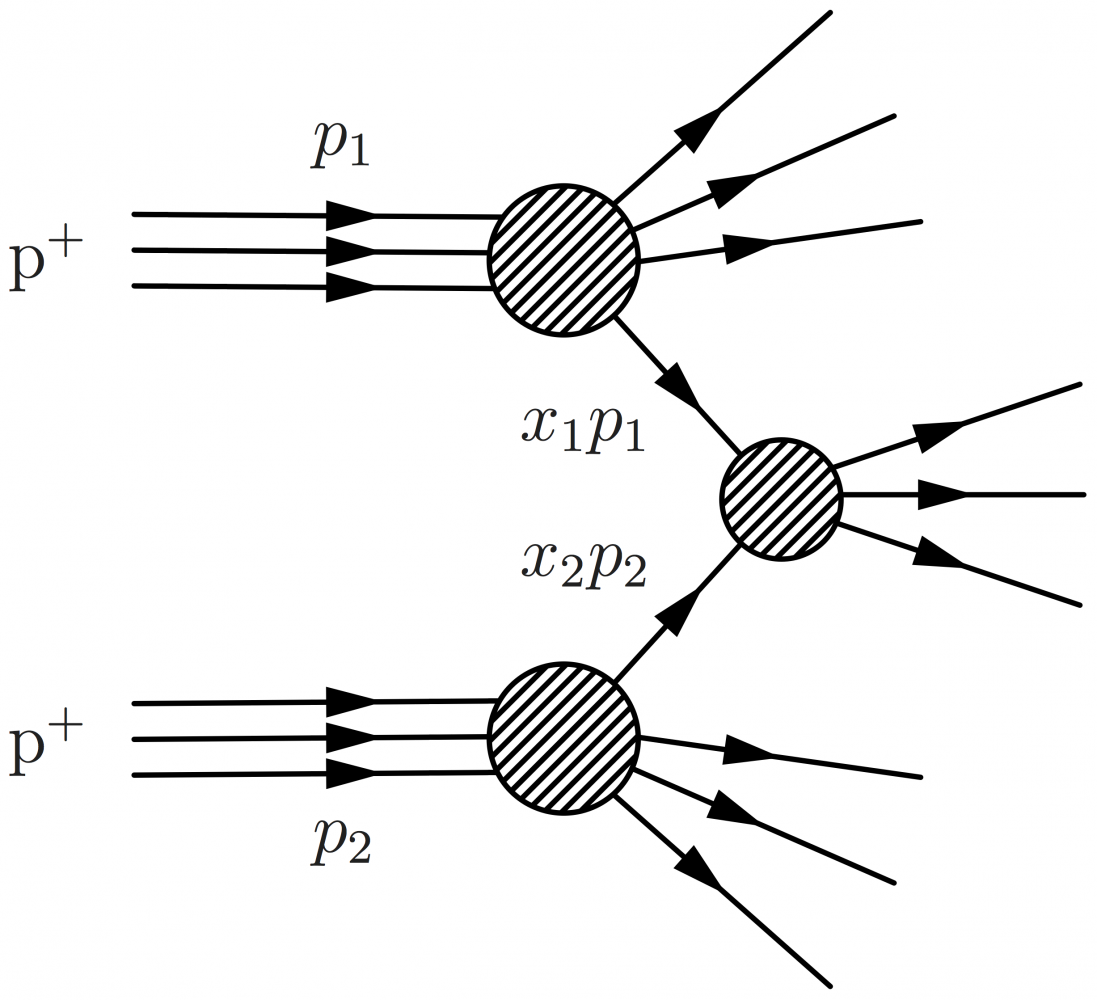
Drell-Yan:
\big \brainstorm { fmffile }{feyngraph} \begin { fmfgraph* }(160,160) \fmfleft {i1,iq,i2,ip,i3} \fmfright {y1,y2,y3,o1,f1,o2,o3,o4,f2,o5,x3,x2,x1} \fmfset{arrow_len}{10 } % skeleton \fmf { phantom,tension=0.48}{vq,vp} \fmf {phantom}{ip,vp,x1} \fmf{phantom}{iq,vq,y1 } \fmffreeze % parton \fmfv { 50=$x_1p_1$,fifty.a=-90,l.d=22}{vp } % cheat: actually a line label \fmfv { l=$x_2p_2$,fifty.a=90,50.d=22}{vq } % crook: really a line label \fmf { fermion,tension=1.half dozen}{vp,v} \fmf{fermion,tension=1.six}{v,vq } % difficult process \fmfshift { 20 right}{f1,f2} \fmfv {l=$\bar{f}$ }{f1} \fmfv {l=$f$ }{f2} \fmf {boson,tension=2,characterization=$\text {Z}^0/\gamma^*$,characterization.side=left}{v,vf} \fmf{fermion,tension=2}{f1,vf,f2 } % proton 1 \fmfv { l=$\text{p}^+$,fifty.a=180,l.d=ten}{ip} \fmf {phantom}{ip,vp} \fmfi {fermion,l=$p_1$,50.s=left,l.d=8} {vpath (__ip,__vp) scaled 1.01 shifted (-two.4, 6)} \fmfi {fermion}{vpath (__ip,__vp) scaled 1.01 shifted (-2.4, 0)} \fmfi{fermion}{vpath (__ip,__vp) scaled 1.01 shifted (-2.4,-six) } % proton 2 \fmfv { l=$\text{p}^+$,l.a=180,fifty.d=ten}{iq} \fmf {phantom}{iq,vq} \fmfi {fermion}{vpath (__iq,__vq) scaled 1.01 shifted (-ii.4, 6)} \fmfi {fermion}{vpath (__iq,__vq) scaled 1.01 shifted (-2.4, 0)} \fmfi {fermion,l=$p_2$,l.south=right,l.d=8} {vpath (__iq,__vq) scaled 1.01 shifted (-2.4,-6) } % 10 ii \fmfshift { 25 left}{x1} \fmfshift {xx left}{x2,x3} \fmf{phantom}{vp,x1 } % to help \fmfi \fmf { phantom}{vp,x2 } % to help \fmfi \fmf { phantom}{vp,x3 } % to help \fmfi \fmfi { fermion}{vpath (__vp,__x1) scaled 1.0 shifted ( 0.0, 2.0)} \fmfi {fermion}{vpath (__vp,__x2) scaled 1.0 shifted ( 0.0, 0.0)} \fmfi {fermion}{vpath (__vp,__x3) scaled 1.0 shifted ( 0.0,-2.0)} \fmfblob{25}{vp } % 10 2 \fmfshift { 25 left}{y1} \fmfshift {20 left}{y2,y3} \fmf{phantom}{vq,y1 } % to assistance \fmfi \fmf { phantom}{vq,y2 } % to help \fmfi \fmf { phantom}{vq,y3 } % to help \fmfi \fmfi { fermion}{vpath (__vq,__y1) scaled ane.0 shifted ( 0.0,-2.0)} \fmfi {fermion}{vpath (__vq,__y2) scaled 1.0 shifted ( 0.0, 0.0)} \fmfi {fermion}{vpath (__vq,__y3) scaled 1.0 shifted ( 0.0, 2.0)} \fmfblob {25}{vq} \end { fmfgraph* } \end { fmffile }
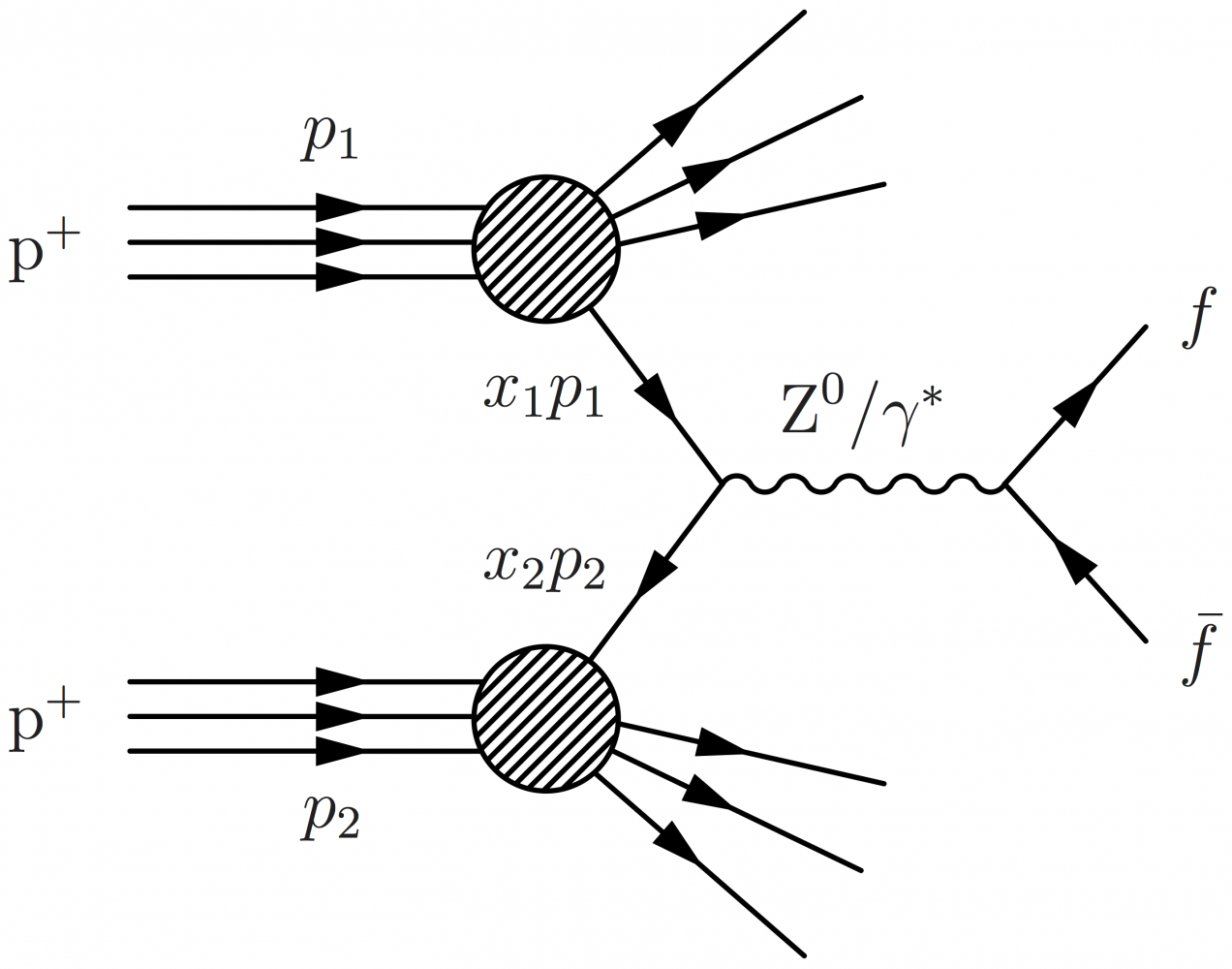
Higgs production via gluon-gluon fusion:
\big \begin { fmffile }{feyngraph} \begin { fmfgraph* }(160,160) \fmfleft {i1,iq,i2,ip,i3} \fmfright {y1,y2,y3,o1,o2,o3,o4,o5,x3,x2,x1} \fmfset {arrow_len}{10} \fmfset{curly_len}{eight } % skeleton \fmf { phantom,tension=0.48}{vq,vp} \fmf {phantom}{ip,vp,x1} \fmf{phantom}{iq,vq,y1 } \fmffreeze % parton \fmf { gluon,tension=1.4,label=$x_1p_1$,label.side=left}{v1,vp} \fmf {gluon,tension=1.4,characterization=$x_2p_2$,characterization.side=left}{vq,v2 } % hard process \fmfshift { 20 right}{o3} \fmfv {l=H}{o3} \fmf {fermion,tension=0.3,pointer.size=2mm}{v1,v2} \fmf {fermion,tension=ii.0}{v1,vh,v2} \fmf{dashes,tension=2.v}{vh,o3 } % proton 1 \fmfv { l=$\text{p}^+$,l.a=180,l.d=10}{ip} \fmf {phantom}{ip,vp} \fmfi {fermion,fifty=$p_1$,l.s=left,fifty.d=eight} {vpath (__ip,__vp) scaled ane.01 shifted (-2.4, 6)} \fmfi {fermion}{vpath (__ip,__vp) scaled ane.01 shifted (-2.4, 0)} \fmfi{fermion}{vpath (__ip,__vp) scaled one.01 shifted (-2.4,-6) } % proton 2 \fmfv { fifty=$\text{p}^+$,fifty.a=180,l.d=10}{iq} \fmf {phantom}{iq,vq} \fmfi {fermion}{vpath (__iq,__vq) scaled 1.01 shifted (-2.four, half dozen)} \fmfi {fermion}{vpath (__iq,__vq) scaled ane.01 shifted (-two.4, 0)} \fmfi {fermion,l=$p_2$,l.southward=right,l.d=8} {vpath (__iq,__vq) scaled one.01 shifted (-two.4,-half dozen) } % X 2 \fmfshift { 25 left}{x1} \fmfshift {20 left}{x2,x3} \fmf{phantom}{vp,x1 } % to aid \fmfi \fmf { phantom}{vp,x2 } % to help \fmfi \fmf { phantom}{vp,x3 } % to aid \fmfi \fmfi { fermion}{vpath (__vp,__x1) scaled i.0 shifted ( 0.0, two.0)} \fmfi {fermion}{vpath (__vp,__x2) scaled one.0 shifted ( 0.0, 0.0)} \fmfi {fermion}{vpath (__vp,__x3) scaled 1.0 shifted ( 0.0,-ii.0)} \fmfblob{25}{vp } % X 2 \fmfshift { 25 left}{y1} \fmfshift {20 left}{y2,y3} \fmf{phantom}{vq,y1 } % to help \fmfi \fmf { phantom}{vq,y2 } % to help \fmfi \fmf { phantom}{vq,y3 } % to help \fmfi \fmfi { fermion}{vpath (__vq,__y1) scaled 1.0 shifted ( 0.0,-2.0)} \fmfi {fermion}{vpath (__vq,__y2) scaled 1.0 shifted ( 0.0, 0.0)} \fmfi {fermion}{vpath (__vq,__y3) scaled 1.0 shifted ( 0.0, 2.0)} \fmfblob {25}{vq} \end { fmfgraph* } \terminate { fmffile }
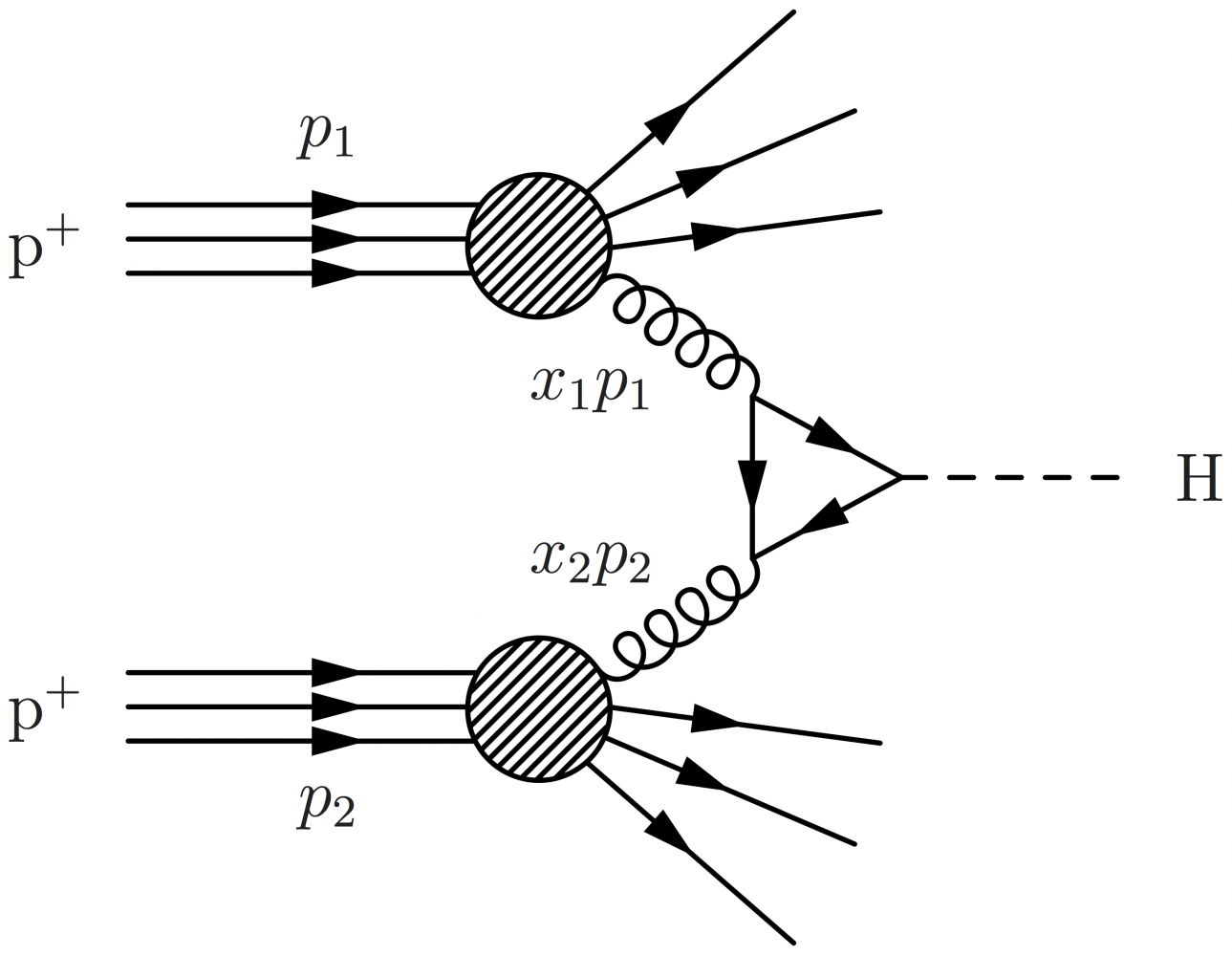
Diffractive proton-proton collisions
Diffractive processes involving a Pomeron, subsequently this ALICE, this CMS (FSQ-fifteen-005) and this ATLAS (ATL-PHYS-PROC-2016-079) paper. Note the Pomeron symbol is made with ${\rm I\!P}$ instead of ${\mathbb{P}$.
Elastic scattering with Pomeron substitution:
\large \brainstorm { fmffile }{feyngraph} \begin { fmfgraph* }(160,80) \fmfleft {iq,ip} \fmfright{oq,op } % proton 1 \fmflabel { $\text{p}^+$ }{ip} \fmflabel { $\text{p}^+$ }{op} \fmf{fermion,width=1.five}{ip,vp,op } % proton ii \fmflabel { $\text{p}^+$ }{iq} \fmflabel { $\text{p}^+$ }{oq} \fmf{fermion,width=one.five}{iq,vq,oq } % pomeron \fmfv { decor.shape=circle,decor.filled=full,decor.size=six}{vp} \fmfv {decor.shape=circle,decor.filled=full,decor.size=vi}{vq} \fmf {double,tension=0.nine,characterization=${\rm I\!P}$,characterization.side=right}{vp,vq} \terminate { fmfgraph* } \end { fmffile }
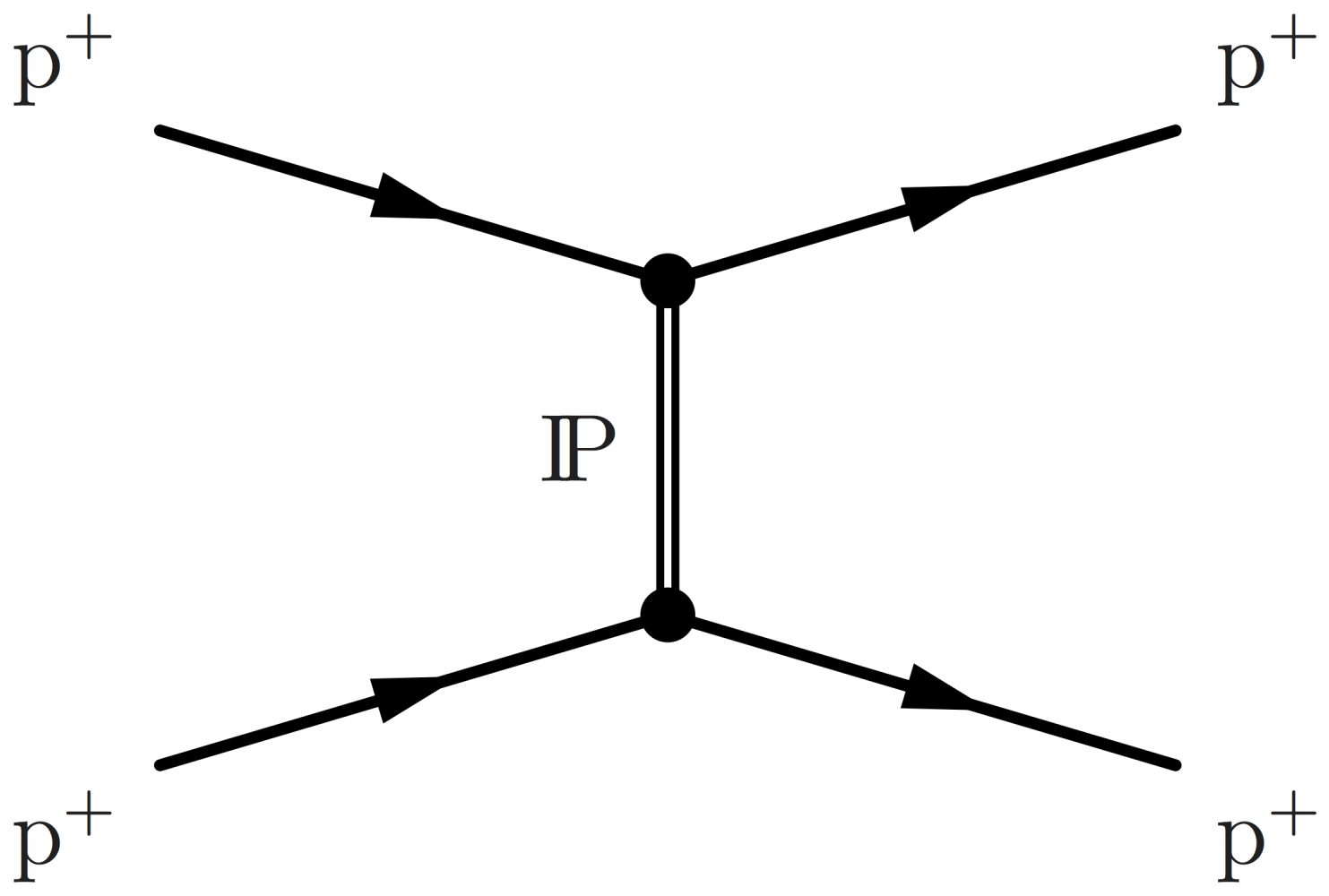
Single diffraction (SD):
\large \begin { fmffile }{feyngraph} \begin { fmfgraph* }(160,lxxx) \fmfleft {iq,ip} \fmfright{oq,op } % proton 1 \fmflabel { $\text{p}^+$ }{ip} \fmflabel { $\text{p}^+$ }{op} \fmf{fermion,width=1.v}{ip,vp,op } % proton 2 \fmflabel { $\text{p}^+$ }{iq} \fmf {fermion,width=ane.5}{iq,vq} \fmf{phantom}{vq,oq } % pomeron \fmf { double,tension=0.nine,label=${\rm I\!P}$,label.side=right}{vp,vq } \fmffreeze % single diffraction \fmfshift { 5 up}{oq} \fmfv {l=Y,l.a=-ten,50.d=12}{oq} \fmfi {fermion}{vpath (__vq,__oq) scaled i.01 shifted(4, two) rotatedaround(vloc(__vq), 10)} \fmfi {fermion}{vpath (__vq,__oq) scaled i.01 shifted(iv, 0) rotatedaround(vloc(__vq), 0)} \fmfi{fermion}{vpath (__vq,__oq) scaled i.01 shifted(4,-2) rotatedaround(vloc(__vq),-10) } % vertices \fmfv { decor.shape=circle,decor.filled=full,decor.size=6}{vp} \fmfblob {20}{vq} \terminate { fmfgraph* } \terminate { fmffile }
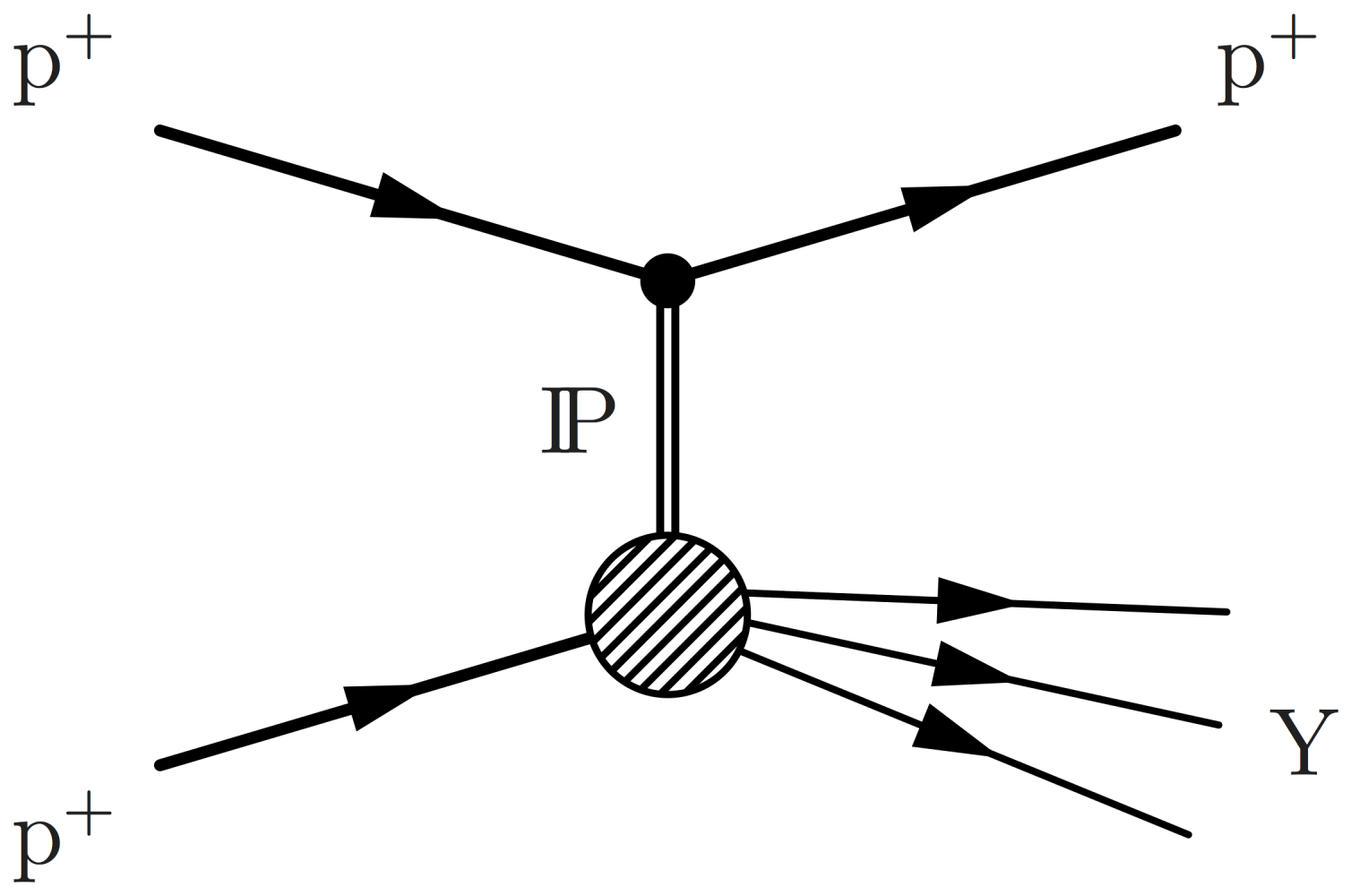
\large \begin { fmffile }{feyngraph} \begin { fmfgraph* }(160,80) \fmfleft {iq,ip} \fmfright{oq,op } % proton 1 \fmflabel { $\text{p}^+$ }{ip} \fmf {fermion,width=1.5}{ip,vp} \fmf{phantom}{vp,op } % proton 2 \fmflabel { $\text{p}^+$ }{iq} \fmflabel { $\text{p}^+$ }{oq} \fmf{fermion,width=1.5}{iq,vq,oq } % pomeron \fmf { double,tension=0.ix,label=${\rm I\!P}$,label.side=right}{vp,vq } \fmffreeze % single diffraction \fmfshift { v down}{op} \fmfv {50=X,l.a=x,l.d=12}{op} \fmfi {fermion}{vpath (__vp,__op) scaled 1.01 shifted(4, 2) rotatedaround(vloc(__vp), x)} \fmfi {fermion}{vpath (__vp,__op) scaled 1.01 shifted(iv, 0) rotatedaround(vloc(__vp), 0)} \fmfi{fermion}{vpath (__vp,__op) scaled 1.01 shifted(4,-2) rotatedaround(vloc(__vp),-x) } % vertices \fmfv { decor.shape=circle,decor.filled=full,decor.size=half dozen}{vp} \fmfblob {20}{vp} \terminate { fmfgraph* } \end { fmffile }
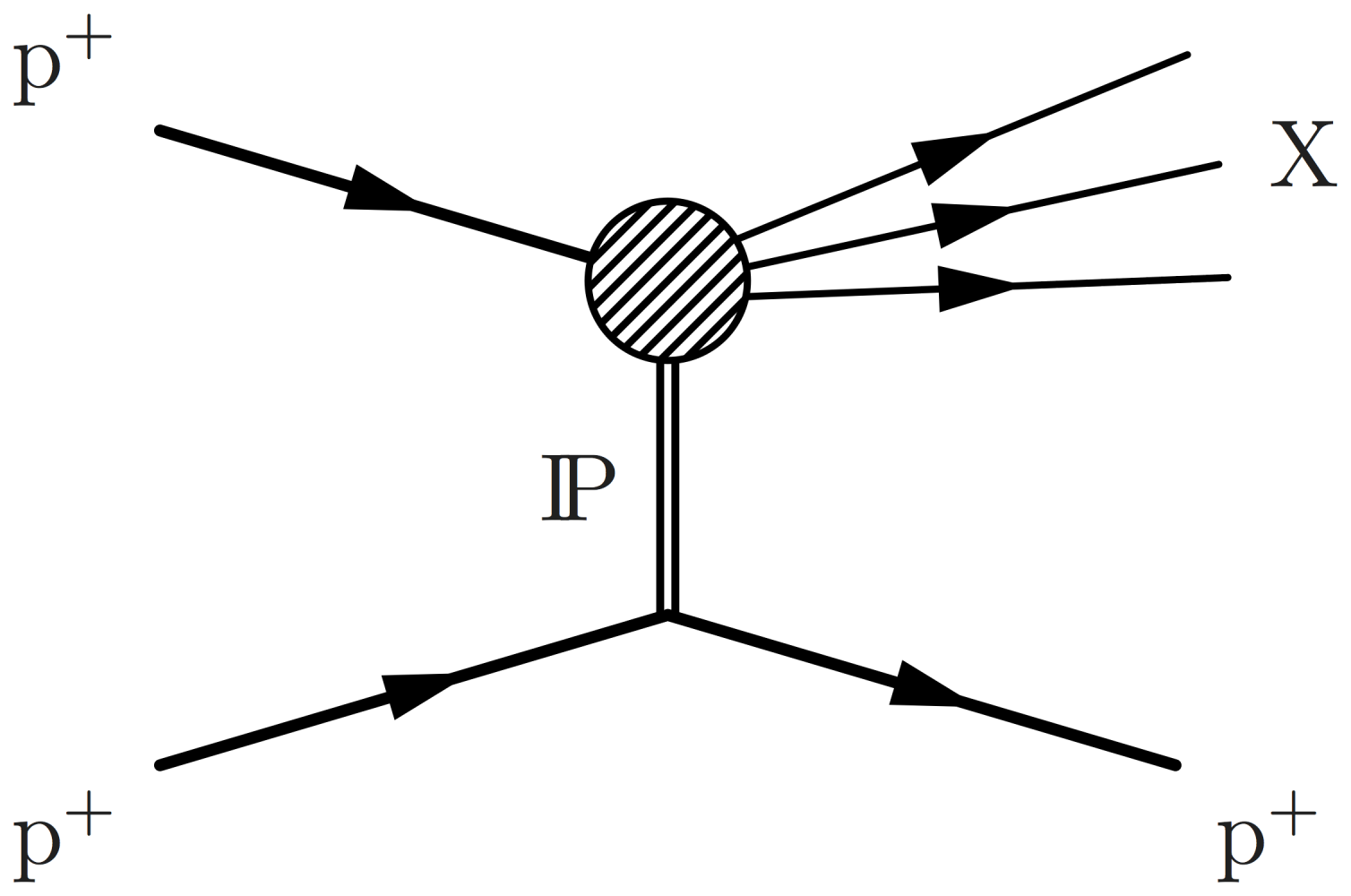
Double diffraction (DD):
\big \brainstorm { fmffile }{feyngraph} \begin { fmfgraph* }(160,eighty) \fmfleft {iq,ip} \fmfright{oq,op } % proton 1 \fmflabel { $\text{p}^+$ }{ip} \fmf {fermion,width=one.v}{ip,vp} \fmf{phantom}{vp,op } % proton 2 \fmflabel { $\text{p}^+$ }{iq} \fmf {fermion,width=1.5}{iq,vq} \fmf{phantom}{vq,oq } % pomeron \fmf { double,tension=0.9,characterization=${\rm I\!P}$,label.side=correct}{vp,vq } \fmffreeze % double diffraction \fmfshift { 5 downward}{op} \fmfshift {5 up}{oq} \fmfv {l=Ten,l.a=x,l.d=12}{op} \fmfv {50=Y,l.a=-10,50.d=12}{oq} \fmfi {fermion}{vpath (__vp,__op) scaled 1.01 shifted(4, ii) rotatedaround(vloc(__vp), 10)} \fmfi {fermion}{vpath (__vp,__op) scaled 1.01 shifted(4, 0) rotatedaround(vloc(__vp), 0)} \fmfi {fermion}{vpath (__vp,__op) scaled 1.01 shifted(iv,-2) rotatedaround(vloc(__vp),-10)} \fmfi {fermion}{vpath (__vq,__oq) scaled 1.01 shifted(4, 2) rotatedaround(vloc(__vq), ten)} \fmfi {fermion}{vpath (__vq,__oq) scaled one.01 shifted(four, 0) rotatedaround(vloc(__vq), 0)} \fmfi{fermion}{vpath (__vq,__oq) scaled one.01 shifted(iv,-2) rotatedaround(vloc(__vq),-10) } % vertices \fmfblob { twenty}{vp} \fmfblob {20}{vq} \end { fmfgraph* } \end { fmffile }
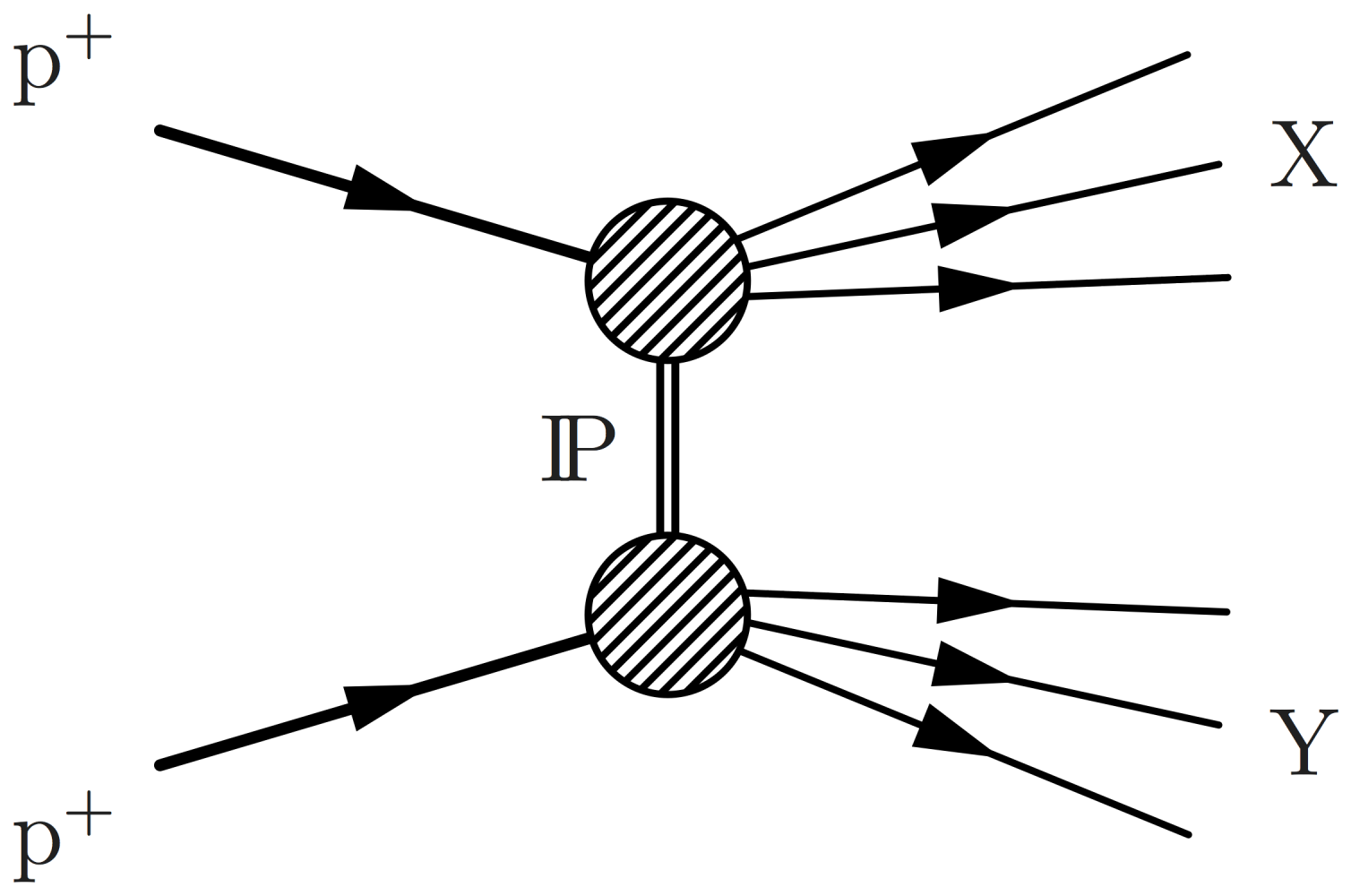
Central diffraction:
\large \begin { fmffile }{feyngraph} \begin { fmfgraph* }(160,80) \fmfleft {iq,ip} \fmfright{oq,oc,op } % proton 1 \fmflabel { $\text{p}^+$ }{ip} \fmflabel { $\text{p}^+$ }{op} \fmf{fermion,width=1.5}{ip,vp,op } % proton 2 \fmflabel { $\text{p}^+$ }{iq} \fmflabel { $\text{p}^+$ }{oq} \fmf{fermion,width=one.five}{iq,vq,oq } % pomeron \fmfv { decor.shape=circle,decor.filled=total,decor.size=half dozen}{vp} \fmfv {decor.shape=circle,decor.filled=total,decor.size=6}{vq} \fmf {double,tension=0.9,label=${\rm I\!P}$,characterization.side=correct}{vp,v,vq } \fmffreeze % unmarried diffraction \fmfv { l=Z,l.a=0,50.d=12}{oc} \fmf {phantom}{v,oc} \fmfshift {12 left}{oc} \fmfi {fermion}{vpath (__v,__oc) scaled 1.01 shifted(4, 2) rotatedaround(vloc(__v), 10)} \fmfi {fermion}{vpath (__v,__oc) scaled i.01 shifted(4, 0) rotatedaround(vloc(__v), 0)} \fmfi {fermion}{vpath (__v,__oc) scaled ane.01 shifted(4,-2) rotatedaround(vloc(__v),-10)} \fmfblob {20}{v} \stop { fmfgraph* } \cease { fmffile }
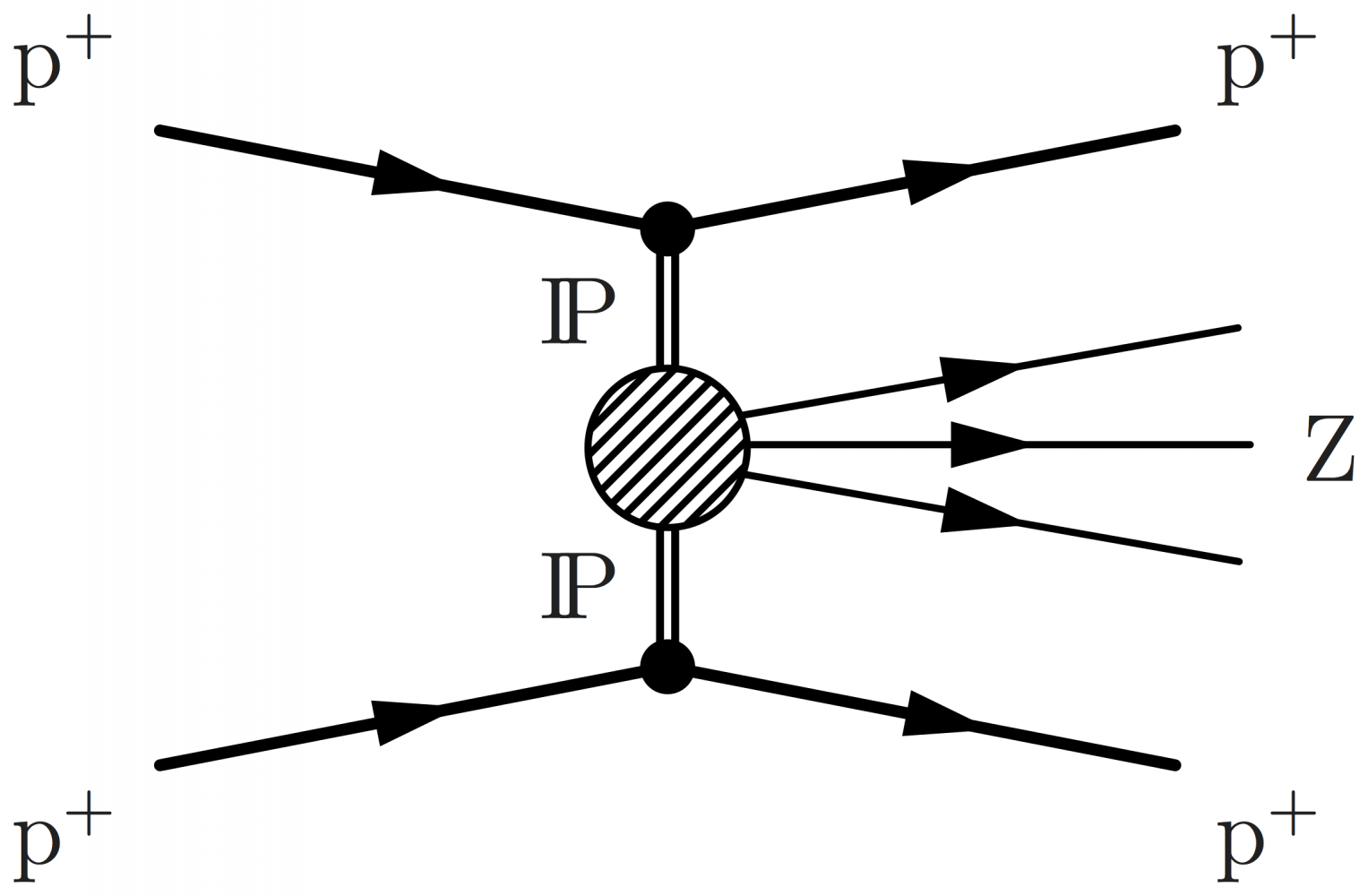
Inelastic and non-diffractive:
\big \brainstorm { fmffile }{feyngraph} \begin { fmfgraph* }(160,eighty) \fmfleft {iq,ip} \fmfright{o } % proton 1 \fmflabel { $\text{p}^+$ }{ip} \fmf{fermion,width=1.5}{ip,v } % proton two \fmflabel { $\text{p}^+$ }{iq} \fmf {fermion,width=one.5}{iq,v} \fmf{phantom,tension=ii}{five,o } \fmffreeze % X \fmfv { fifty=X,l.a=0,l.d=xvi}{o} \fmfi {fermion}{vpath (__v,__o) scaled 1.01 shifted(half dozen, four) rotatedaround(vloc(__v), 24)} \fmfi {fermion}{vpath (__v,__o) scaled ane.01 shifted(half dozen, 2) rotatedaround(vloc(__v), 12)} \fmfi {fermion}{vpath (__v,__o) scaled i.01 shifted(six, 0) rotatedaround(vloc(__v), 0)} \fmfi {fermion}{vpath (__v,__o) scaled ane.01 shifted(6,-two) rotatedaround(vloc(__v),-12)} \fmfi {fermion}{vpath (__v,__o) scaled 1.01 shifted(6,-four) rotatedaround(vloc(__v),-24)} \fmfblob {30}{five} \end { fmfgraph* } \terminate { fmffile }
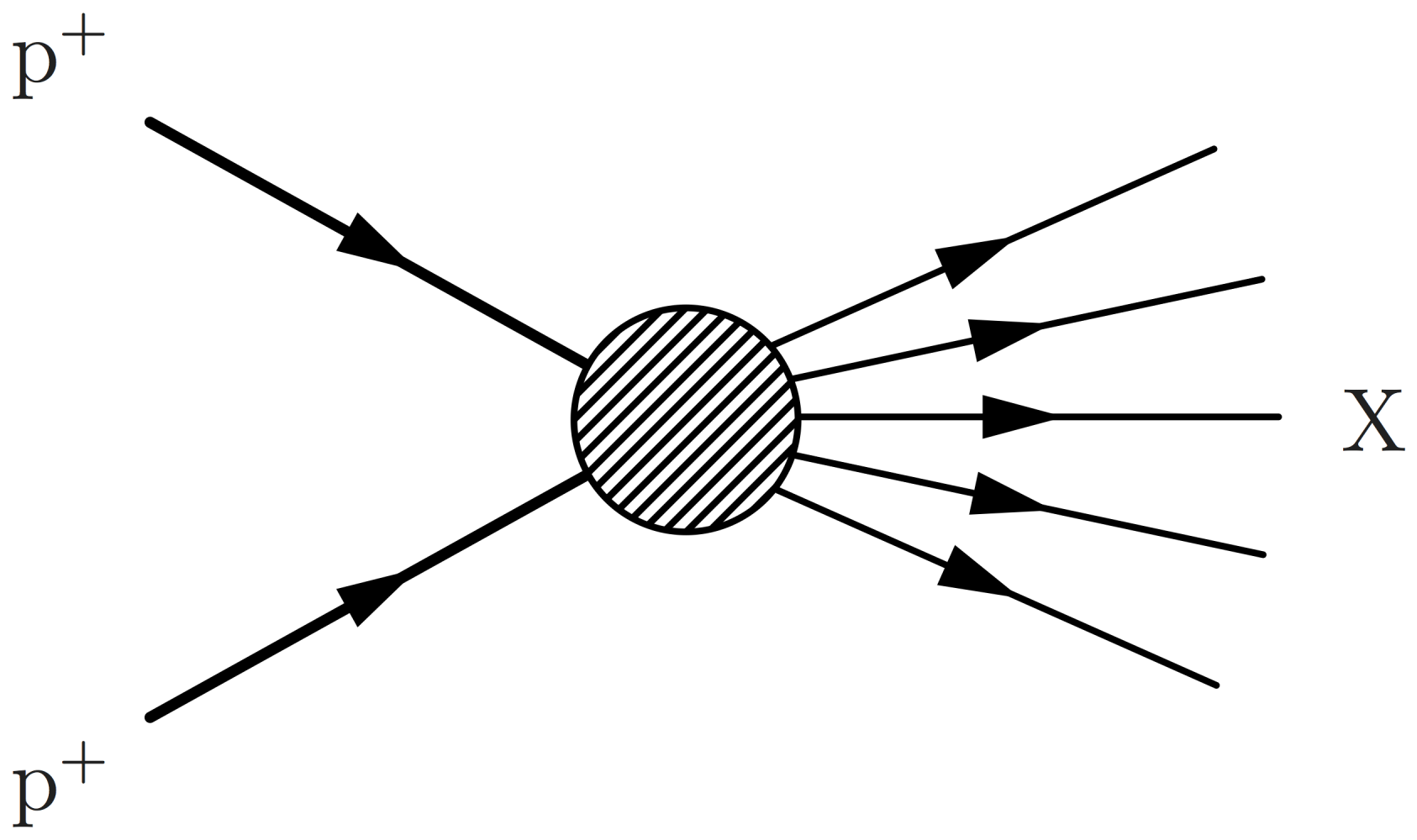
Penguin diagrams
For fun, here are two culling code snippets for the Penguin diagram from Yamanaka examples and Ohl's webpages.
\begin { fmffile }{feyngraph} \begin { fmfgraph* }(120,120) \fmfstraight \fmfleft {g1,g2,s,dsleft,gl} \fmflabel { $\text{s}$ }{southward} \fmflabel { $\overline { \text{d}}$ }{dsleft} \fmfright {n1,n2,d,dsright,gr} \fmflabel { $\bar \nu$ }{n1} \fmflabel { $\nu$ }{n2} \fmflabel { $\text{d}$ }{d} \fmflabel { $\overline { \text{d}}$ }{dsright} \fmf {fermion,tension=1}{dsright,dsleft} \fmf {fermion,tension=1}{s,v1} \fmf {fermion,tension=1}{v3,d} \fmf {fermion}{v1,v2} \fmf {fermion,label=$\text{t}$,label.side=right}{v2,v3} \fmf {photon,label=$\text{W}^-$,left=0.v,tension=0.2}{v1,v3} \fmf {photon,label=$\text{Z}^0$,right=0.v,tension=0.5}{v2,v4} \fmf {fermion}{n1,v4,n2} \fmf {phantom}{g1,v4,g2} \fmfv {characterization=$V_\text{td}$,label.bending=-35,decor.shape=circle, decor.filled=full,decor.size=2thick}{v3} \end { fmfgraph* } \stop { fmffile }
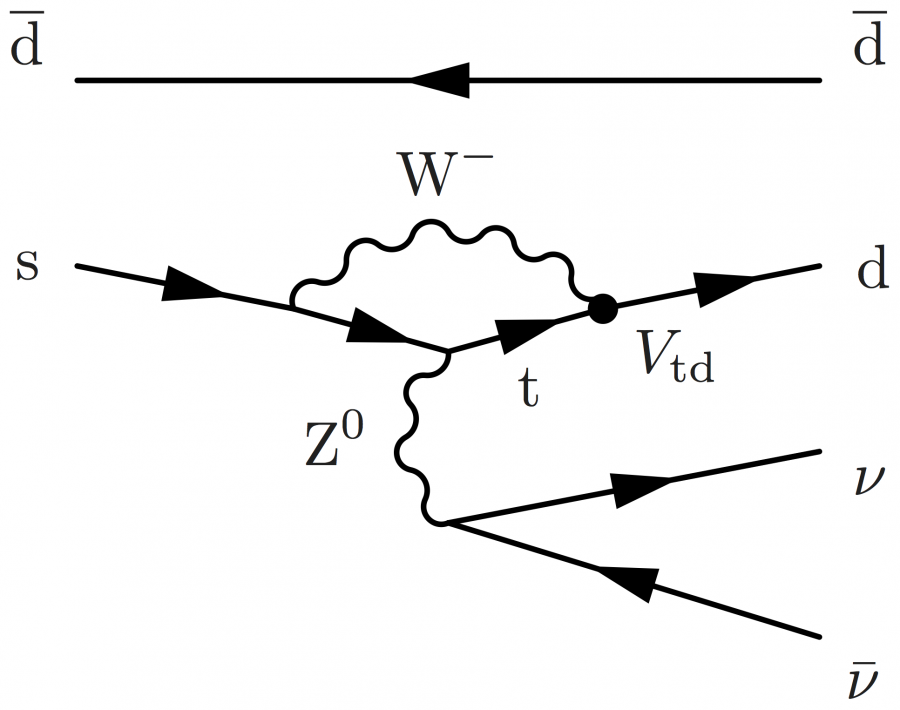
\begin { fmffile }{feyngraph} \begin { fmfgraph* }(140,120) \fmfstraight \fmfleft {x,g1,g2,x,s,dsleft,x} \fmfright {x,n1,n2,x,d,dsright,x} \fmfbottom {b} \fmflabel { $\text{b}$ }{southward} \fmflabel { $\text{southward}$ }{d} \fmf {fermion,tension=1}{dsleft,dsright} \fmf {fermion,tension=ane}{s,v1} \fmf {fermion,tension=one}{v3,d} \fmf {photon,label=$\text{W}^-$,characterization.side=left,tension=one}{v1,v3} \fmffreeze \fmf {fermion,label=$\text{t}$,right=0.4,tension=0.2}{v1,v2} \fmf {fermion,right=0.4,label.side=correct,tension=0.2}{v2,v3} \fmf {phantom,tension=0.xx}{v2,b} \fmffreeze \fmf {photon,label=$\gamma/\text{Z}^0$,label.side=correct,tension=0.v}{v2,v4} \fmf {fermion,tension=2}{n1,v4,n2} \fmf {phantom}{g1,v4,g2} \fmfv {characterization=$V_\text{ts}^{*}$,label.bending=45,label.dist=iii, %decor.shape=circumvolve, decor.filled=total,decor.size=2thick }{ v3} \fmfv {characterization=$V_\text{tb}$,label.angle=120,characterization.dist=3, %decor.shape=circumvolve, decor.filled=full,decor.size=2thick }{ v1} \fmfv {label=$\ell^+$,label.bending=0}{n1} \fmfv {characterization=$\ell^-$,label.angle=0}{n2} \fmfv {label=$\text{$q$}$,label.bending=180}{dsleft} \fmfv {label=$\text{$q$}$,label.angle=0}{dsright} \end { fmfgraph* } \end { fmffile }
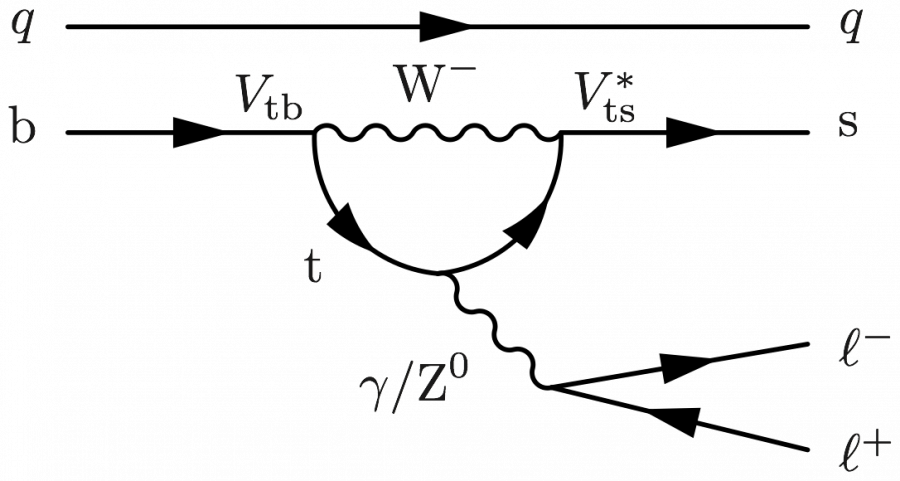
\begin { fmffile }{feyngraph} \begin { fmfgraph* }(140,140) \fmftop {b,s} \fmfbottom {ep,em} \fmf {fermion,lab=b,lab.sid=left}{b,Vtb} \fmf {fermion,lab=south,lab.sid=left}{Vts,s} \fmf {fermion,tension=.5,lab=t,lab.sid=correct}{Vtb,grand,Vts} \fmf {dbl_wiggly,tension=.8,lab=Westward,lab.sid=left}{Vtb,Vts} \fmf {photon}{thou,g'} \fmf {fermion}{ep,g',em} \fmfdot {Vtb,Vts,g,g'} \end { fmfgraph* } \end { fmffile }
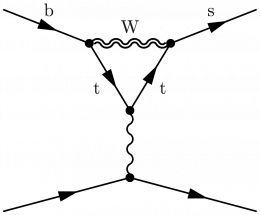
As fatigued past John Ellis and Melissa Franklin (explanation of the code):
\begin { fmffile }{feyngraph} \begin { fmfgraph* }(100,100) \fmfipair {Vtb,Vts,b,s,ep,em,p,p'} \fmfiequ {.5[ Vtb,Vts ]}{.5[ nw,ne ]} \fmfiequ {Vts}{Vtb+(.3w,0)} \fmfiequ {b}{.7[ sw,nw ]} \fmfiequ {s}{.7[ se,ne ]} \fmfiequ {xpart(p')}{xpart(.5[ ep,em ])} \fmfiequ {ypart(p')}{.2h} \fmfiequ {p}{p'+(0,.2h)} \fmfiequ {.5[ ep,em ]}{.5[ sw,se ]} \fmfiequ {em}{ep+(.7w,0)} \fmfi {dbl_wiggly,lab=W,lab.sid=correct}{Vtb--Vts} \fmfi {fermion,lab=b,lab.sid=left}{b--Vtb} \fmfi {fermion,lab=s,lab.sid=left}{Vts--s} \fmfi {fermion,lab=t}{Vtb{b-Vtb} .. tension ii .. {correct}p} \fmfi {fermion,lab=t}{p{correct} .. tension 2 .. {Vts-s}Vts} \fmfi {photon}{p--p'} \fmfi {fermion}{ep--p'} \fmfi {fermion}{p'--em} \fmfiv {d.sh=circle,d.siz=2thick}{Vtb} \fmfiv {d.sh=circle,d.siz=2thick}{Vts} \fmfiv {d.sh=circle,d.siz=2thick}{p} \fmfiv {d.sh=circle,d.siz=2thick}{p'} \end { fmfgraph* } \end { fmffile }
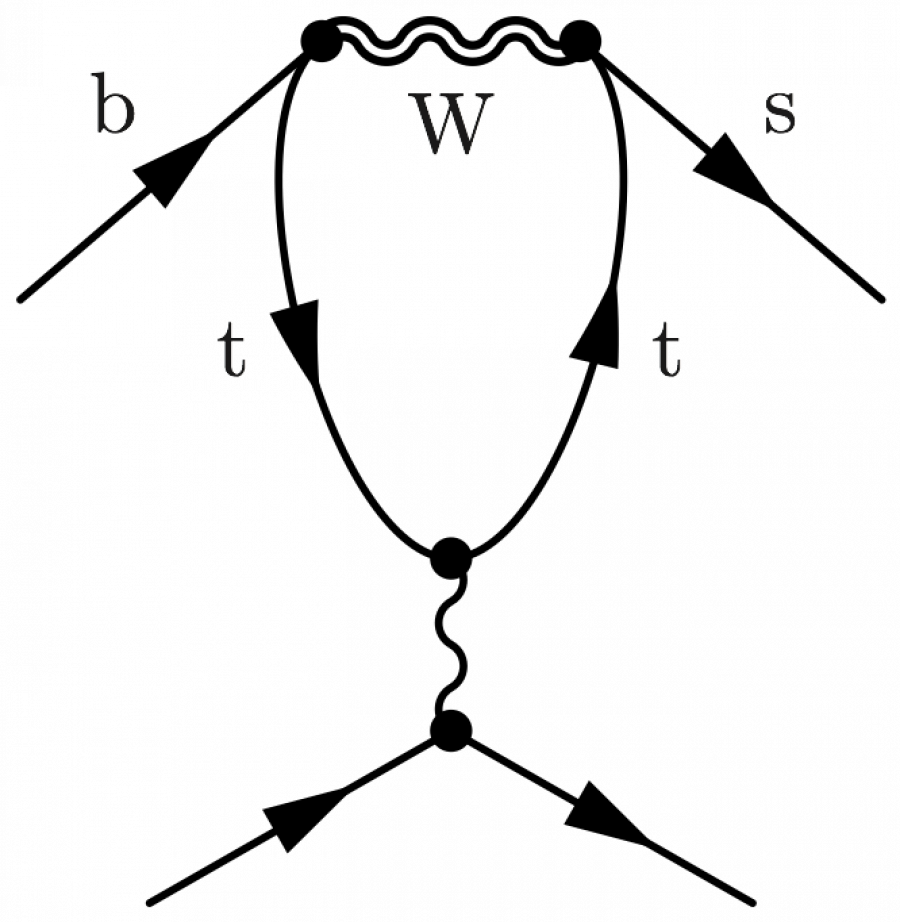
Source: https://wiki.physik.uzh.ch/cms/latex:feynman
Posted by: blancharddeve1941.blogspot.com


0 Response to "How To Draw Feynman Diagrams In Latex"
Post a Comment